

biafINTERNATIONALFLORENCEBIENNIALANTIQUESFAIR






text
48 BACK TO THE FUTURE
Francesco Bonami’s look at Henry Moore and Florence Lo sguardo di Francesco Bonami su Henry Moore e Firenze text Rossella Battista

54 BROAD VIEWS

Bruce Edelstein describes the fascinating figure of Eleonora di Toledo

Bruce Edelstein ci racconta l’affascinante figura di Eleonora di Toledo
62 ITALY IN THE WORLD
Keith Christiansen from the Met in New York, a distinguished member of the BIAF Vetting DalCommitteeMetdi New York, Keith Christiansen, autorevole delmembroComitato Vetting di BIAF text Virginia Mammoli
66 ART HAS MADE ME A BETTER PERSON
Piero Chiambretti, special guest of the XXXII edition of the BIAF Piero Chiambretti, ‘padrino’ d’eccezione della XXXII edizione di BIAF
text Virginia Mammoli
68 PASSION FLORENCE
Sergio Risaliti tells us about the Museo Novecento’s and city SergioprogrammeRisaliti ci racconta il programma del Museo Novecento e della città text Francesca Lombardi
74 ART DIALOGUES
Arturo Galansino and some of his most popular exhibitions at Palazzo Strozzi Arturo Galansino e alcune delle sue mostre più di successo di Palazzo Strozzi
80 NEW TREASURES
The latest major acquisitions by the Uffizi Gallery
Le ultime importanti acquisizioni delle Gallerie degli Uffizi

CONTENTS17EDITORIALAimingforthefuture:DarioNardellaandFabrizioMorettidiscussthe2022BiennaleIlfuturocomeobiettivo:DarioNardellaeFabrizioMorettiraccontanolaBiennale202221MASTERPIECESINFLORENCE27WORLDEXHIBITIONS31HIDDENTREASURES35ANNIVERSARYCANOVA36BOOK40ARTANDCINEMA42FROMWORKTOMASTERPIECELessonsfromtheItalianmaestrooffashionphotographyGianPaoloBarbieriLagrandelezionediGianPaoloBarbierimaestrodellafotografiadimoda
Teresa Favi

Una chiacchierata con il direttore Andrea Di Lorenzo per capire cos’è stato e cosa sarà il Museo Ginori
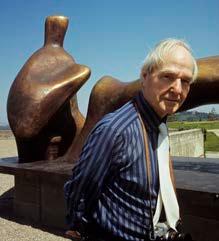

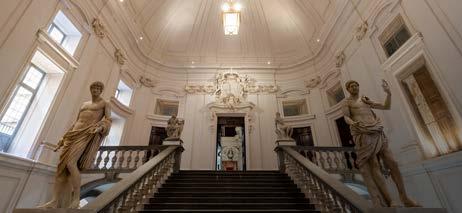

96949288CONTENTSFILROUGEThenew20thcenturyexhibitionatPalazzoMediciRiccarditolearnaboutcontemporarycollectingLanuovamostrasulNovecentoaPalazzoMediciRiccardiperconoscereilcollezionismocontemporaneoTHEMUSEUMTHATWASN’TBIAFinthefuturethankstoEY,InnovationPartnerforthe32ndeditionBIAFnelfuturograzieaEY,InnovationPartnerdiquesta32°edizioneBIAFMEMORIESINTHEFUTUREEternalMemories,thedocu-gamecreatedforBIAFthatlaunchesanewwayoftellingstoriesEternalMemories,ildocu-gamepensatoperBIAFcheinauguraunnuovomododiraccontarestorieSAVOIRFAIREAninterviewwithMatteoCorvino,theinfluentialdesigneroftheBiennaledell’Antiquariatosince2017ParlaMatteoCorvinoautorevolefirmadell’allestimentodellaBiennaledell’Antiquariatodal2017100ARTLOVERCristinaAcidini,Presidentof four invaluable Florentine institutions Cristina Acidini, Presidente di quattro preziose istituzioni fiorentine 106 delAngeloofAngeloBYSURROUNDEDBEAUTYTartuferi,directortheMuseodiSanMarcoTartuferi,direttoreMuseodiSanMarco 112 STILL IN TIME Our interview with Tomaso Montanari, president of the Ginori Museum La nostra intervista con Tomaso Montanari presidente del Museo Ginori text Teresa Favi 120 THE ENERGY OF ANCIENT SCULPTURE Bruno Botticelli, the president of the Associazione Antiquari d’Italia Bruno Botticelli, il presidente dell’Associazione Antiquari d’Italia text Martina Olivieri 122 UN SISTEMA DA diinternazionale,universitarioFrancescoworkstellsprofessorFrancescoSNELLIRESalamone,universityandinternationallawyerusabouttheexportofartinItalySalamone,docenteeavvocatociraccontal’exportopered’arteinItalia 128 TheANDCONTINUITYEXCELLENCEeventhasgrownyearon year Un evento cresciuto anno dopo anno 130 BIAF,INFLORENCETHEWORLDlandmarkontheantiques scene Punto di nell’antiquariaroriferimento 132 BIAF & NewCOLLABORATIONEYlanguagesinthename of art Nuovi linguaggi nel nome dell’arte 137 Internazionale32thEXHIBITORSedition-Biennaledell’Antiquariatodi Firenze 116 BETWEEN THE PAST AND FUTURE A conversation with the director Andrea Di Lorenzo to learn about the present and the future of the Ginori Museum

COLOPHONEDITORINCHIEFMatteoParigiBiniMANAGINGEDITORSTeresaFavi,FrancescaLombardiEDITORIALDIRECTORFabrizioMorettiEDITORIALCOMMITTEERiccardoBacarelli,BrunoBotticelliEDITORSRossellaBattista,MatteoGrazzini,VirginiaMammoli,MartinaOlivieriPHOTOGRAPHERS
Gian Paolo Barbieri (cover), Ela Bialkowska, Stefano Casati, Arrigo Coppitz, Lorenzo Cotrozzi, Elena Foresto, Dario Garofalo Alessandro Moggi, Pasquale Paradiso, Antonio Quattrone, New Press Photo, Tom Powel Imaging, Jens Ziehe
ART EDITORS
Martina Alessi, Melania TRANSLATIONSBranca
Tessa Conticelli, The Florentine
ADVERTISING AND MARKETING DIRECTOR Alex Vittorio ADVERTISINGLana
Nicola Brigandì, Gianni Consorti, Alessandra Nardelli Monica Offidani, Stefano Papini
Supplemento a Firenze Made in Tuscany N.63 Registrazione Tribunale di Prato - n° 9/2006 del 15.12.2006 Spedizione in abbonamento postale 45% - art. 2, lettera b - legge 662/96 Filiale di Firenze - Contiene IP
PUBLISHER
Alex Vittorio Lana & Matteo Parigi Bini via Cristoforo Landino, 2 - 50129 Firenze - Italy - ph +39 055 0498097
Finishedwww.gruppoeditoriale.comprintingSeptember2022STAMPABaroni&Gori-Prato

 Boutique Panerai Firenze - Piazza San Giovanni, 14R
Boutique Panerai Firenze - Piazza San Giovanni, 14R
extend your international limited warranty for up to 8 years on panerai.com
PAINTINGS AND DRAWINGS
PRESIDENT Dario Nardella (Mayor of HONORARYSECRETARYVICE-PRESIDENTFlorence)GiovannaFolonariEnricoFrascioneGENERALFabrizioMorettiCOMMITTEERiccardoBacarelliMassimoBartolozziBrunoBotticelliFabrizioGuidiBruscoliAlessandraDiCastroCarloOrsiLuigiSalvadoriFurioVelonaPRESIDENTGiovanniPratesi
Organizzazione Mostra: EXPO ARTE E CULTURA S.R.L., Riccardo Bacarelli, Presidente
Biennale Internazionale dell’Antiquariato Via del Parione, 11 - 50123 Firenze Tel. +39 055 282 635 - Tel. +39 055 282 283

24PALAZZO32www.biennaleantiquariato.itVETTINGEDITIONCORSINIFIRENZEthSeptember/2thOctober2022
Marco Voena, Coordinatore Keith Christiansen, Coordinatore
Bernard Jan Hendrik Aikema
Luca Massimo Barbero
Daniele Benati
Stefano Causa
Sonia Chiodo
Maria Cecilia Fabbri
Carlo Falciani
Luca Jean-PatriceFrancescoRichardPeterLoredanaArturoFiorentinoGalansinoGalloKerberKnightLeoneMarandel
Fernando lMaicholLauraAndrewSilvestraSandroAndreaBrunoRiccardoSCULPTUREMariaCarlDanieleSergioNicolettaGianniAlessandroMazzoccaMorandottiPapiPonsRisalitiRossiStrehlkeCristinaTerzaghiBacarelli,CoordinatoreBotticelli,CoordinatoreBacchiBellesiBietolettiButterfieldCavazziniClemente
Aldo AndreaEnricoSimoneDoraMarcoperAlessandraDavidARTSFURNITUREClaudioRiccardoFernandoDavidFrancescoSimoneGalliGuerrieroLeoneLucidiMazzoccaNaldiPizzorussoANDDECORATIVESestieri,CoordinatoreDiCastro,ReferentegliespositoriArosioLisciaBemporadChiarugiColleDeMiglio
Roberto Fersini Claudio Franchi
Pier Maria Scagliola
Roberto ElenaCOORDINATRICEWalterCarloAlessandraAlbertoAlessandroBrunoRiccardoEnricoFabrizioCOMITATOValerianiDEIGARANTIMoretti,CoordinatoreFrascione,CoordinatoreBacarelliBotticelliCesatiDiCastroDiCastroOrsiPadovaniSCIENTIFICACapretti
CONTRIBUTORS
CRISTINA ACIDINI
Cristina Acidini, an art historian born in Florence, was director of the Opificio delle Pietre Dure and Polo Museale Fiorentino. She has promoted restorations, museum renovations, exhibitions, research and publications, and has written books and essays. Today Cristina Acidini chairs the Opera di Santa Croce, the Academy of Arts of Drawing, and the Casa Buonarroti and Roberto Longhi Foundations.

GIAN PAOLO BARBIERI
One of the greatest fashion photographers of all time, his images anticipated the great changes in society from the Sixties onwards. His works are displayed in the Victoria & Albert Museum and National Portrait Gallery in London, Kunsforum in Vienna, MAMM in Moscow and Musée du Quai Branly in Paris, and Nicola Erni Collection on Zug.
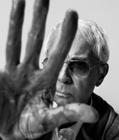
FRANCESCO BONAMI
He was the director of the 50th Venice Biennale in 2003, curator of the 75th Whitney Biennial of American Art in 2010 and the 3rd Manifesta in 2000. He has curated Yan Pei Ming and Damien Hirst exhibitions. At the MCA in Chicago, he was the curator of shows dedicated to Jeff Koons and Rudolf Stingel. He is a regular contributor for La Repubblica and Vogue He’s the author of several books on contemporary art.
KEITH CHRISTIANSEN
He earned a PhD in art history at the University of Harvard in 1977, the same year he was hired at the Metropolitan Museum as Assistant Curator. Following his positions as Associate Curator ( 1980), Full Curator ( 1987) and Jayne Wrightsman Curator ( 1989), he was Chairman of the John Pope-Hennessy Department of European Painting (20092021). Now retired, he is Curator Emeritus.



ANDREA DI LORENZO
An art historian, he was born and grew up in Milan, but considered Florence his second home. Before being appointed director of Fondazione Museo Archivio Ginori della Manifattura in Doccia in 2021, he was vice-director of the Museo Poldi Pezzoli Milan, where he was also curator of the porcelain collection.


BRUCE EDELSTEIN
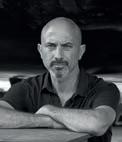
Coordinator for Graduate Programs and Advanced Research at New York University Florence. His publications focus on the works of painters and sculptors at the Medicean court in the 1500s. He was co-curator of the Miraculous Encounters: Pontormo from drawing to painting exhibition in Florence, New York, and Los Angeles in 2018-2019.



ARTURO GALANSINO
In 2015, he was appointed General Director of Florence’s Palazzo Strozzi Foundation. He has built a brilliant career working first in Paris, at the Musée du Louvre, and then in London, at the National Gallery and Royal Academy of Arts. Galansino has studied in Italy, where he received a PhD in Art History and Criticism.
TOMASO MONTANARI President of Fondazione Museo Archivio Ginori della Manifattura in Doccia, he is an expert on seventeenth-century European art and has written about one hundred essays about it. Among his best-known books are A cosa serve Michelangelo? (Einaudi 2011); Le pietre e il popolo (minimum fax 2013); Privati del patrimonio (Einaudi 2015).
SERGIO RISALITI
Sergio Risaliti is an art historian, writer, and curator of exhibitions and interdisciplinary events.. Since 2014 he has acted as artistic director of projects at the Forte di Belvedere, the Museo Stefano Bardini, the Palazzo Vecchio, and the Piazza della Signoria, Florence. Since 2018 he is artistic director of the Museo Novecento in Florence
FRANCESCO SALOMONE Lawyer specialized in Protection of Cultural Heritage law and professor of Cultural Heritage law at Università La Sapienza, Rome. Member of the Permanent Committee for the circulation of works of art established at the MIC. He explained the circulation of works in Italy for us.
EIKE SCHMIDT
Eike Schmidt, has been a curator and museum director since 2001 at The National Gallery of Arts in Washington, the J. Paul Getty Museum in Los Angeles and the Minneapolis Institute of Arts. He was the managing director of Europe in the Sculpture Department at Sotheby’s auction house in London. Since November 2015, Eike Schmidt has been the director of the Uffizi Galleries.
ANGELO TARTUFERI
Born in Florence, as of 2000 he is Director of the Office for the Export Antiques and Art Objects of the Special Heritage Authorities for the Florence Museums. Following assistant directorships at the Uffizi and director at the Accademia Gallery, since May 2020 Angelo Tartuferi has been director of the Museo di San Marco.





+39 055 6560324 | OFFICINEGULLO.COMTHE QUINTESSENTIAL KITCHEN
A parallel course that began in 2015 and is punctuated with achievements and satisfaction, and which marks a real turning point for the city. If we want to take stock of recent editions of the Florence International Antiques Biennale , we have to begin with the partnership between the city’s mayor Dario Nardella and BIAF general secretary Fabrizio Moretti. Enthusiasm, passion and vision for the future are the values shared by both men, unmistakable signs of strong, forceful personalities. We asked them to tell us about this 32° edition of the Biennale, which marks 63 years of the event.

What are the values shared by Florence and the BIAF?
Dario Nardella: There’s no doubt in my mind: originality, passion, meticulousness and vision for the future
What does the 2022 edition represent?
DN: It’s a moment of recovery: the BIAF once again opens its doors to Florence and the world after a three-year hiatus due to the Palazzo Corsini, the perfect venue for an event of this kind, will be really exciting Fabrizio Moretti:
We’re presenting a programme based on quality, chosen by the world’s greatest art patrons with passion and enthusiasm. It’s an exhibition that seeks to pay homage to Florence as a whole; it encourages satellite activities and - without a shadow of doubtconstitutes an important benchmark for the world market in ancient art
In addition to the Biennale, Florence Art Week is an important moment for the city, bringing together art, fashion and hospitality. Can you give us a brief summary from your privileged viewpoint?
DN: Florence Art Week was conceived as an ideological - and certainly not exhaustive - framework to contain a concentration of high-level cultural events; a pilot project which we hope to build on and make permanent in the years to come. The various cultural organisations of the city responded to our call, so we’re in a position to showcase Florence’s extraordinary capacity to create networks
Un percorso parallelo, iniziato insieme nel 2015, costellato di successi e soddisfazioni, che ha segnato una vera e propria svolta per la città: se si deve tracciare un bilancio di questi anni di attività della Biennale internazionale di Antiquariato di Firenze bisogna partire dal sodalizio che lega il Sindaco Dario Nardella e il Segretario Generale di BIAF Fabrizio Moretti. Entusiasmo, passione, sguardo rivolto al futuro sono i valori che condividono, segni distintivi di due personalità forti e volitive. A loro abbiamo chiesto di raccontarci questa 32° edizione della Biennale, che segna 63 anni di attività della stessa. Quali sono i valori condivisi di Firenze e BIAF?
Dario Nardella: Non ho dubbi: originalità, passione, meticolosità, sguardo rivolto al futuro. Cosa rappresenta questa edizione del 2022?
DN: L’edizione della ripartenza: la Biaf apre di nuovo le sue porte a Firenze e non solo dopo tre anni di stop dovuto alla pandemia.Tornare nello splendido Palazzo Corsini, luogo ideale per una manifestazione di questo genere, sarà davvero una forte emozione.
Fabrizio Moretti: Sicuramente rappresenta la rinascita dopo un periodo dei più grandi mercanti d’arte al mondo, passione e entusiasmo. E’ una mostra che vuole omaggiare tutta la città di Firenze, che favorisce l’indotto e - possiamo dire senza ombra di dubbio – rappresenta un punto di riferimento fondamentale per il mercato mondiale di arte antica.
Oltre Biennale, la Florence Art Week è un momento importante per la città che coinvolge arte, moda e accoglienza. Ce la racconta in poche parole dal suo osservatorio privilegiato?
DN: La Florence Art Week è stata concepita come una cornice ideale e non certo esaustiva in cui inserire una concentrazione di eventi culturali di altissimo livello, un progetto pilota che vogliamo strutturare e rendere permanente negli anni a venire. I diversi attori culturali della città hanno risposto al nostro appello e siamo così in grado di dimostrare una straordinaria capacità della città di fare rete e
Chiara and Dario Nardella with Fabrizio Moretti
biennaleantiquariato 17
IN AimingPERSPECTIVEforthefuture:the 2022 Biennale Il futuro come obiettivo: la Biennale 2022
and present a varied programme in line with current trends in different artistic disciplines. The BIAF has been by our side from the outset
Digitalisation is a major development in the recent history of the city, and also of the Biennale. Why is it increasingly important to keep looking to the future?

DN: Thanks to Fabrizio Moretti’s farsightedness, for some time the Biennale has had a strong contemporary character, with a programme that includes many parallel events and whose audience is no longer just experts, but truly heterogeneous and interested
FM: As with previous editions, in the months leading up to the Biennale, we’ve publicised it on our Facebook and Instagram pages, featuring interviews with all our partners and previews of the latest news. This year we’ve gone much further, creating a video game in Italian and English which aims to raise awareness among young people all over the world about Florence’s history, so that they appreciate the present and, we hope, invest in the future of our city. We’ve touched on three important topics: Florence, young people
DN: Young people are part of the new audience I mentioned earlier: touch with the new trends in art and contemporary art collecting FM: As I always say, the Biennale is a genuine museum for sale, wonderful to visit even for young people, who perhaps dream of becoming tomorrow’s collectors. I’d really like the Biennale to be seen above all as an opportunity for cultural exchange, with enormously beautiful and valuable objects selected by an extremely rigorous and professional vetting process. Works which could genuinely be in museums, and often actually end up there. The Biennale is a veritable patron of the city: can you tell us about the operations it funds?
FM: In addition to the considerable satellite activities around the sculpture and decorative arts - worth some 10,000 euros - are an which will go to some wax items at the Ginori Museum. The painting
di proporre un’offerta variegata e in sintonia con l’attualità dei diversi linguaggi artistici. La BIAF
La digitalizzazione è un capitolo importante della storia recente della Città e anche della Biennale. Perché oggi è sempre più importante mantenere uno sguardo proiettato verso il futuro?
DN: Da tempo, grazie alla lungimiranza di Fabrizio Moretti, la Biennale ha acquisito una forte connotazione contemporanea con un programma composto anche da molte iniziative collaterali e richiama un pubblico non più di soli addetti ai lavori ma davvero eterogeneo e interessato.
FM: Come per le precedenti edizioni, nei mesi che hanno preceduto la mostra abbiamo raccontato la Biennale attraverso le piattaforme Facebook e Instagram, lanciando interviste a tutti i nostri partner e notizie in anteprima. Quest’anno abbiamo fatto molto di più, abbiamo creato un videogioco in italiano e inglese che ha come scopo sensibilizzare i giovani di tutto il mondo sul passato di Firenze, per apprezzare di più il presente e speriamo investire sul futuro della città. Abbiamo toccato tre temi importanti: Firenze, i giovani e la Biennale. Mi costruite questa equazione?
DN: I giovani fanno parte di quel pubblico nuovo di cui ho accennato sopra: chi pensa che l’antiquariato sia roba appunto del passato è rimasto decisamente indietro con le nuove tendenze dell’arte e del collezionismo contemporanei.
FM: Come dico sempre la Biennale è un vero e proprio museo in vendita, bello da visitare anche quando si è giovani, per sognare magari di diventare collezionisti domani. Vorrei davvero che si vedesse la Biennale soprattutto come un momento di scambio culturale, con oggetti di grande valore e bellezza selezionate da un vetting molto attento e preparato. Opere che davvero possono stare in un museo, e spesso ci arrivano davvero.
La Biennale è un vero e proprio mecenate per la città: entriamo nel
FM: Oltre all’importante indotto che la Biennale porta alla città, per quanto riguarda le opere mirate, i tre Premi Pittura, Scultura e Arti Decorative, tre premi di circa 10 mila euro, sono un pretesto
potrebbero essere recuperate. Abbiamo già deciso il Premio Scultura, che andrà a delle cere del Museo Ginori. Il Premio Scultura andrà
18 biennaleantiquariato
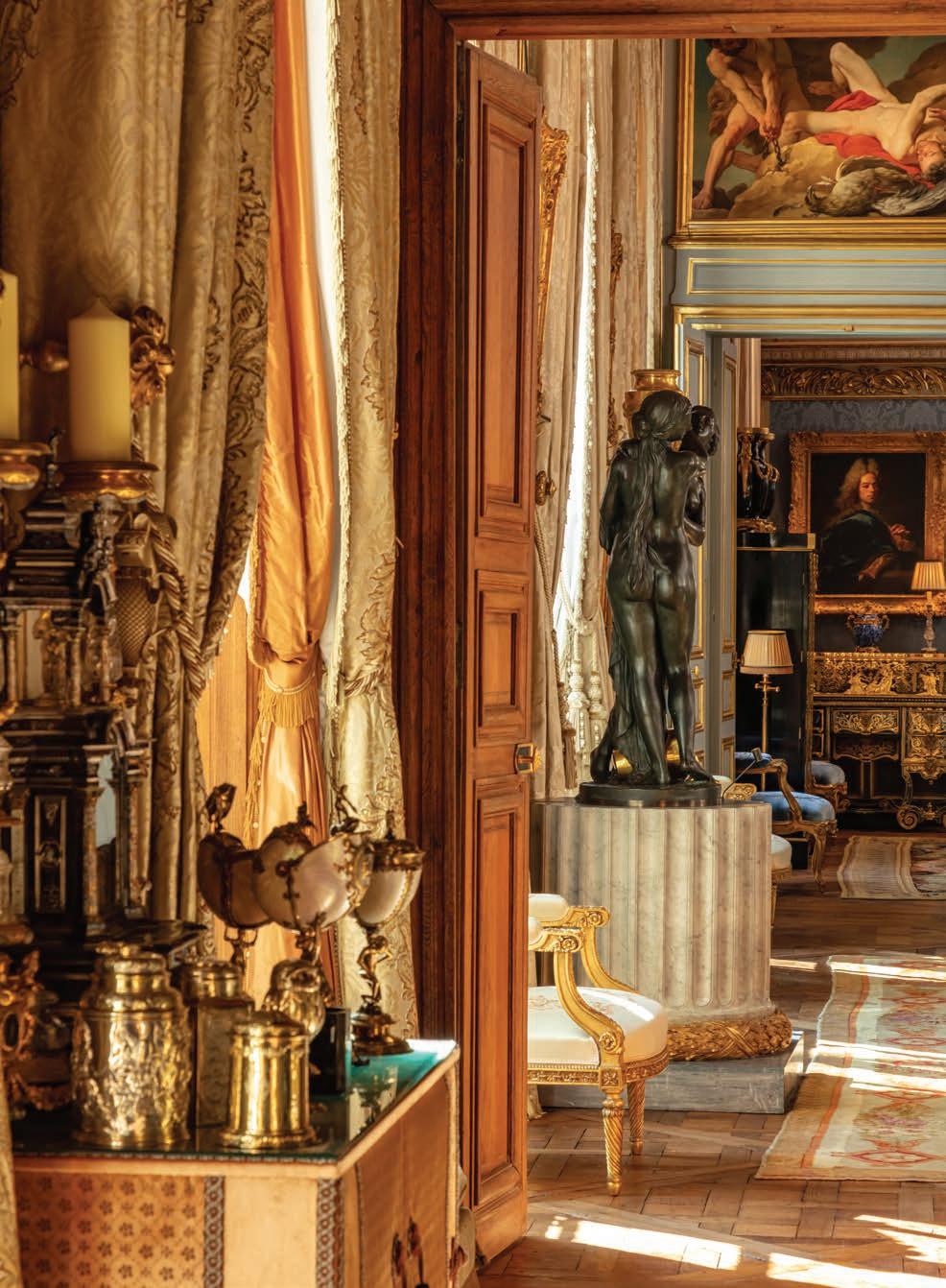
DOWNLOAD SOTHEBY’S APP FOLLOW US @SOTHEBYS 76, RUE DU FAUBOURG SAINT HONORÉ, PARIS 8 e ENQUIRIES +33 (0)1 53 05 53 04 LOUIS XAVIER.JOSEPH@SOTHEBYS.COM SOTHEBYS.COM/HOTELAMBERT #SOTHEBYS AGRÉMENT N°2001 002 DU 25 OCTOBRE 2001 COMMISSAIRE PRISEUR HABILITÉ PIERRE MOTHES. © ART DIGITAL STUDIO


FALIEROSARTI.COM
URS FISHER IN PIAZZA DELLA SIGNORIA WITH THE CYCLOPEAN BIG CLAY #4 1.
text FRANCESCA LOMBARDI
A majestic work is added to the extraordinary open-air sculpture museum that is Piazza della Signoria: a ‘giant’ of 13 metres, almost an architectural prop for the Arengario animated with two life-size wax sculptures. This is the contribution of Urs Fisher for In Florence 2017, a contemporary art event wanted by Fabrizio Moretti and Sergio Risaliti. When we interviewed Urs Fisher on that occasion, he showed he had perfectly understood the spirit of the city: “It is one thing to create something new, but it takes another kind of talent to skilfully preserve what we have been offered. The people of Florence excel at this. Their city and culture have remained valuable and important throughout the centuries.”
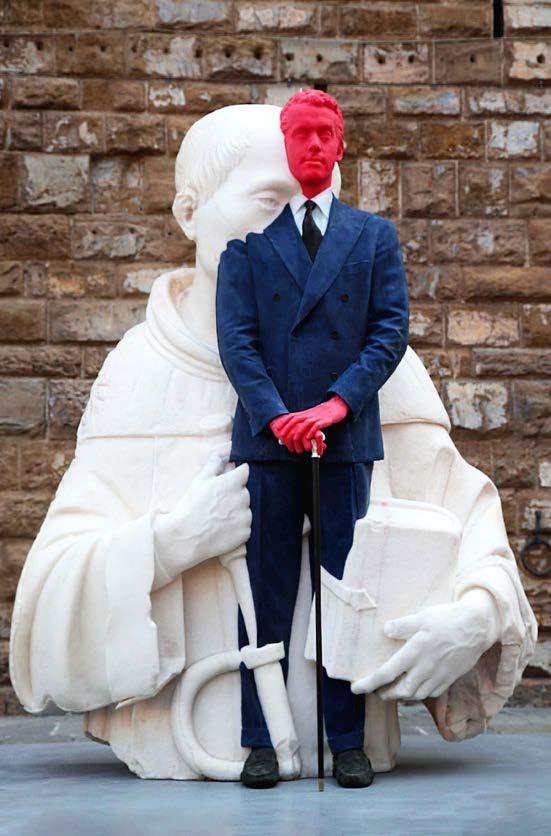
Un’opera monumentale all’interno dello straordinario museo della scultura a cielo aperto che è Piazza Signoria: un ‘gigante’ di 13 metri che fa da quinta all’Arengario, animato con due sculture in cera a grandezza naturale. È l’in tervento di Urs Fisher per In Florence 2017, evento di arte contemporanea ideato da Fabrizio Moretti e Sergio Risaliti. Urs Fisher, che intervistammo in quell’occasione, aveva perfettamente compreso lo spirito della città: “Una cosa è il creare qualcosa di nuovo, ma ci vuole un altro tipo di talento nel questo. La loro città e cultura sono rimaste preziose e importanti per secoli.”
The candle sculpture by Urs Fi sher placed in the Piazza nella Si gnoria in 2017 depicting Fabrizio the appearance of the historic square
biennaleantiquariato 21
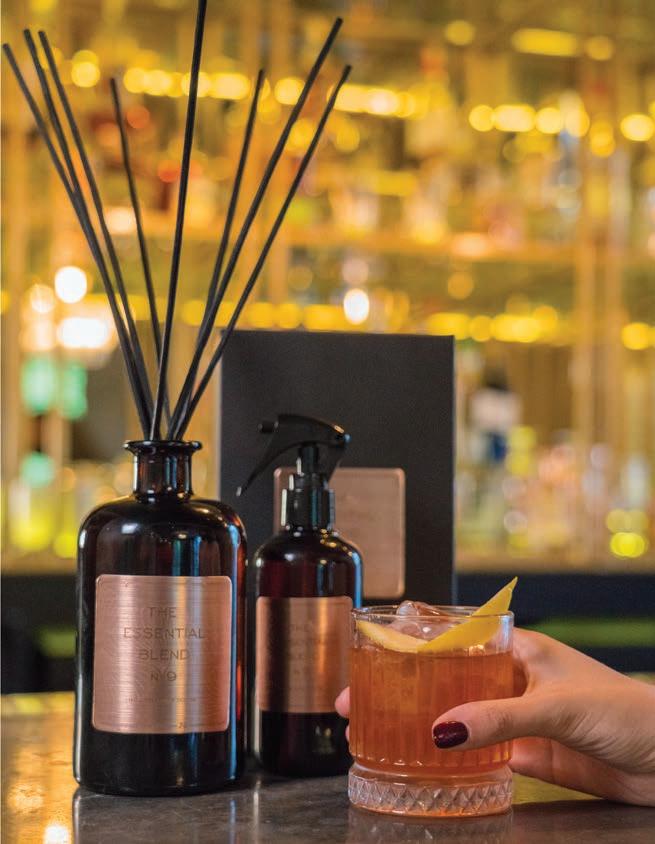
The Essential Blend Exclusive at Campomarzio70 Via della Condotta 65/r, Firenze 055 0516656 - campomarzio70theessentialblendfirenze@campomarzio70.it
JEFF KOONS AND HIS MASTERPIECE IN STAINLESS STEEL 2.
 text FRANCESCA LOMBARDI
text FRANCESCA LOMBARDI
Koons is a great contemporary artist who came to Florence in 2015 for the Pluto and Proser pina is on display in Piazza della Signoria, not far from the marble reproduction of Michelangelo’s David. It is a majestic work, almost four metres high, in mirror in a sensual embrace and shine in the light of the sun, in stark contrast to the points out: “talk about transcendence and mortality in an eternal place such as Piazza della Signoria.”
Koons è il grande artista contemporaneo che arriva a Firenze nel 2015 per la prima edizione di In Florence: in Piazza della Signoria, a poca distanza dalla copia in marmo del David di Michelangelo viene esposta una delle più celebri sculture di Koons, Pluto and Proserpina. Si tratta di un’opera monumentale, alta quasi quattro metri, in acciao inox, lucidata a specchio e con una cromatura in color luce atmosferica in stridente contrasto con le sculture rinascimentali della Piaz e mortalità in un luogo eterno come Piazza della Signoria.”
Pluto and Proserpina, (2010-2013) mirror-polished stainless steel with transparent (c) Jeff Koons.
biennaleantiquariato 23

50123 Firenze Via de’ Tornabuoni 72r +39 055 212075 53100 Siena Via Pianigiani 12 +39 0577 280456 www.fanishops.it
HENRY TRIBUTEMOORE,TOMICHELANGELO 3.
text FRANCESCA LOMBARDI
In Florence 2022 pays tribute to Henry Moore: until March 31, Family Group and Large Interior Form will be exhibited respectively in two sym bolic places of the city, Piazza della Signoria and also exceptionally in the courtyard of the Abbey of San Miniato al Monte in harmony with the historical, architectural and artistic heritage of Florence. “The per ception of form is an inner sensation for a sculptor: every form, regardless of its size and complexity is perceived as if contained in the hollow of his hand, and visualised mentally in the multitude of its aspects”, the artist stated during the famous exhibition that the city dedicated to him in 1972.
In Florence Family Group e Large Interior Form saranno esposte rispettivamente in due luoghi simbolo della città, Piazza della Signoria ed eccezionalmente sul Sagrato dell’Abbazia di San Miniato al Monte, in dialogo con il patrimonio storico-artistico-archi tettonico di Firenze. “La percezione della forma è per lo scultore una sensazione interiore: ogni forma, infatti, indipendentemente dalle sue dimensioni e dalla sua complessità, viene da lui percepita come se fosse contenuta nell’incavo della sua mano, e visualizzata mentalmente nella molteplicità dei suoi aspetti” affermò l’ar tista nel corso della celebre mostra che nel 1972 la città dedicò all’artista.
Large Interior Form (1953-54), Henry Moore’s sculpture placed in Piazza della Signoria on the occasion of the 50th anniversary of the historic 1972 exhibition

biennaleantiquariato 25
www.angelacaputi.comph.alessandrobencini.com

1. Andy Warhol.

La pubblicità nella forma - Milan
2. Reaching for the Stars. Da Maurizio Cattelan a Lynette Yiadom-Boakye - Florence

3. Marina Abramovi - London

4. Helmut Newton - Milan

5. Olafur Eliasson: Nel tuo tempo -

Painting, photography and sculpture. The great stars of the past and the most avant-garde contemporary artists come together for an art season that promises to be unforgettable. Our “Grand Tour” starts in Florence, of course. In the days when the city welcomes exhibitors and visitors to the 32nd International Antiques Biennale, Palazzo Strozzi houses an exclusive solo exhibition of works by Olafur Eliasson: Nel tuo tempo is the most extensive exhibition ever held in Italy by one of the most original and visionary contemporary artists of our time. But the city’s most innovative museum continues its focus on contemporary art with Reaching for the Stars. From Maurizio Cattelan to Lynette YiadomBoakye starting from March 4, 2023, an exhibition showcasing a selec tion of today’s major contemporary artists, including Maurizio Cattelan, Damien Hirst, Lara Favaretto, Cindy Sherman, Rudolf Stingel and many more. Showing until June 18. Our next stop is Milan, with its amazing series of unique art exhibitions. Palazzo Reale, the city’s pivotal location for art, is where the public will be able to admire the wonders by Fran cisco Goya (from October 31, 2023 to March 3, 2024), Ruggero Savinio (from May 26, 2023 to September 4,2023), Bill Viola (from October 2023 to January 2024). And the amazing works by photographers such as Oliviero Toscani ( from June to September 2022), Gabriele Basilico (from October 2023 to January 2024), Helmut Newton (from April 2023 to June 2023) and Richard Avedon (from September 21,2022 to January 29,2023). Palazzo Reale will also be the magical setting for Max Ernst, painter, sculptor, etcher, poet and art theorist (from October 4, 2022 to February 26, 2023). Fabbrica del Vapore houses, until March 26, 2023, a great retro spective exhibition devoted to the King of Pop Art, titled Andy Warhol. La pubblicità nella forma, curated by Achille Bonito Oliva. One beauty after another, we shift our focus to Paris, with its heterogeneous range
agli artisti più all’avanguardia, per una stagione dell’arte che ha tutte le carte in regola per divenire imperdibile. Il nostro Grand Tour non poteva iniziare che da Firenze. Nei giorni in cui questa città accoglie gli espositori e i visitatori della XXXII edizione della Biennale Internazionale dell’Antiquariato, Palazzo Strozzi ci invita a un’esclusiva personale dedicata a Olafur Eliasson: Nel tuo tempo, è la più grande mostra mai realizzata in Italia dedicata a uno degli artisti contemporanei più originali e visionari
polo museale più votato al contemporaneo della città non si ferma e ospita dal 4 marzo 2023, Reaching for the Stars. Da Maurizio Cattelan a Lynette Yiadom-Boakye, mostra che propone una selezione di opere dei più importanti artisti contemporanei internazionali, tra cui Maurizio Cattelan, Damien Hirst, Lara Favaretto, Cindy Sherman, Rudolf Stingel e molti altri. Fino al 18 giugno. Destinazione Milano, con il suo rendez-vous di esposizioni uniche. Luogo cardine dell’offerta espositiva milanese è sicuramente Palazzo Reale, dove il pubblico potrà ammirare le meraviglie di Francisco Goya (dal 31 ottobre 2023 al 3 marzo 2024), Ruggero Savinio (dal 26 maggio 2023 al 4 settembre 2023), Bill Viola (da ottobre 2023 a Oliviero Toscani (da giugno a settembre 2022), Gabriele Basilico (da ottobre 2023 a gennaio 2024), Helmut Newton (da aprile 2023 a giugno 2023) e Richard Avedon (dal 21 settembre 2022 al 29 gennaio 2023). Ed è ancora in questo luogo magico che verrà ospitata anche la prima retrospettiva in Italia di Max Ernst, pittore, scultore, incisore, poeta e teorico dell’arte (dal 4 ottobre 2022 al 26 febbraio 2023). Stepalla Fabbrica del Vapore
re della Pop Art, intitolata Andy Warhol. La pubblicità nella forma. A cura di Achille Bonito Oliva. Bellezza dopo bellezza, incontriamo Parigi che the top art exhibitions are all here Firenze a New York, l’arte da vedere è tutta qui
biennaleantiquariato 27
MUSEUM-BOUNDFromFlorencetoNewYork,
Da
Florence1.3. 4. 2.5.

055 28.17.56
1. Joan Mitchell - Paris Philip Guston - London Edvard Munch - Paris Jasper Johns - New York Georgia O’Keeffe - New


of art exhibitions. Showing until January 22, 2023 at the Musée d’Or say is the solo exhibition of works by the famous Norwegian painter Edvard Munch. His tragic sense of life and death, which he assimilated from Scandinavian literature, made him one of the greatest exponents of expressionism. Showing at La Fondation Louis Vuitton until February 27, 2023 is a dual exhibition devoted to Joan Mitchell and Claude Monet Their artistic feeling for light and color is highlighted in the remarkable vi sual and thematic similarity between the two artists, through about sixty works. Also London offers a rich program of art exhibitions throughout 2023. The Royal Academy of Arts hosts a unique event bringing together the major works by , an exhibition that explores the artist’s 50 year-career through works in various forms. Showing from September to December 2023. On show at the National Gallery, After Impressionism, from March 25 to August 13,2023, displaying the works by the great masters of art between the late 1800s and the early 1900s and illustrating the dawning of the modern era through their most inno vative artwork: Van Gogh and Matisse, Cézanne and Picasso, Kandinskij and Mondrian, and also Degas, Gauguin, Klimt, Rodin, Munch, a journey through over 100 milestones of art. The Tate Modern closes its 2023 art season with Philip Guston, to the artist in the past twenty years. The exhibition, on view until Oc
and existential painting style. New York, the city where everything is pos sible, offers a mix of subcultures and Old Masters art. One of the most eagerly-awaited exhibitions of the year will be showing at the Whitney Museum, Jasper Johns, a journey through the artist’s over sixty-year ca reer constantly focusing on research and innovation. When talking about surrealism, what comes most readily to mind is early twentieth-century Europe, but Surrealism Beyond Borders at the Met takes visitors on a tour of works by artists from Eastern Europe to the Caribbean, from Asia to Africa, from Australia to South America. In 1946, New York’s MoMA
American painter Georgia O’Keeffe, and her use of a new style called Precisionism. Now, after about seven

galleries from April 9 to August 12, 2023.
incanta per il suo ventaglio eterogeneo di esposizioni. Fino al 22 gennaio 2023 il Musée d’Orsay dedica una personale al famoso pittore norvegese Edvard Munch. Il senso tragico della vita e della morte, che ha assimilato dalla letteratura scandinava, ha fatto di lui uno dei maggiori esponenti dell’espressionismo. Fino al 27 febbraio 2023, La Fondation Louis Vuitton presenta una duplice mostra dedicata a Joan Mitchell e a Claude Monet, la loro sensibilità alla luce e al colore è evidenziata in notevoli corrispondenze visive e tematiche, attraverso una sessantina di opere. Una nutrita agenda di mostre si appresta a far brillare il 2023 dell’affascinante Londra. Alla Royal Academy of Arts un evento unico che raccoglierà le principali opere di , ripercorrendo i 50 anni di carriera di attraverso opere di varia natura. Da settembre a dicembre 2023. Alla National Gallery, After Impressionism in programma dal 25 marzo al 13 agosto

Novecento che racconteranno l’alba dell’era moderna attraverso le loro opere più innovative. Vedremo insieme Van Gogh e Matisse, Cézanne e Picasso, Kandinskij e Mondrian, e poi Degas, Gauguin, Klimt, Rodin, Munch, in un percorso scandito da oltre 100 pietre miliari dell’arte. Giungiamo
con Philip Guston, al centro della prima retrospettiva inglese degli ultimi venti anni. La mostra, visitabile dal 5 ottobre, ripercorrerà cinque decenni di carriera dell’artista, portando alla ribalta la sua pittura ermetica ed esistenziale. Un intreccio di subculture e maestri dell’arte classica, a New York tutto è possibile. Iniziamo con una delle mostre più attese dell’anno quella di Jasper Johns al Whitney Museum. Un racconto completo di una carriera lunga oltre sessant’anni e costantemente caratterizzata da ricerca e innovazione. Quando si dice Surrealismo si pensa all’Europa di inizio secolo, ma Surrealism Beyond Borders al Met porta il visitatore alla scoperta di artisti dall’Europa dell’Est ai Caraibi, dall’Asia all’Africa, dall’Australia al Sud America, verso un surrealismo davvero inedito. Nel 1946 il MoMA di New York allestì la prima retrospettiva su una donna artista: si trattava di Georgia O’Keeffe , celebre a distanza di oltre sette decenni, l’istituzione museale ha annunciato il retrospettiva-focus in programma nelle gallerie del terzo piano dal 9 aprile al 12 agosto 2023.

biennaleantiquariato 29
2.
3.
4.
5.
York1.4. 2.5. 3.

1. 2. The Warrior Pope Giuliano della Rovere and Anghiari’s Soldiers of Fortune (ph. Stefano Casati)
3. 4. Pietro Benvenuti in the Age of Canova in Arezzo (ph. Stefano Casati)
5. Eve Tempted by the Serpent in Portoferraio on the Island of

TUSCANY, A SCATTERED MUSEUM
Fondazione CR Firenze !
Piccoli Grandi Musei and
Anghiari until 25 September

The Warrior Pope Giuliano della Rovere and Anghiari’s Soldiers of Fortune andfor
Pietro Benvenuti in the Age of Canova. Paintings and drawings from public and private collections at the until 23



Piccoli Grandi Musei e
Anghiari bre Il Papa Guerriero Giuliano della Rovere e gli uomini d’arme di Anghiari
Pietro
until 8 January 2023 at the
Stories from the Life of St Peter Martyr and Christ the Man of Sorrows
Storie di San Pier Mar tire Cristo in pietà

biennaleantiquariato 31
The major Terre degli Uffizi exhibitions that add value to the region Le grandi mostre di Terre degli Uffizi che valorizzano il territorio
Elba1.3. 4. 2.5.
3.
1. Nel segno della vita. Donne e Madonne al tempo dell’attesa in Poppi (ph. Stefano Casati)
2. Trittico of Nicolas Froment (ph. Cristina Andolcetti); 3. Penitent Magdalen

4. Masaccio and the Masters of the Renaissance (ph. Antonio Mulas); 5. Stories from the Life of St Peter Martyr (ph. Stefano

for Masaccio and the Masters of the Renaissance, in dialogue to celebrate six centuries of the San Giovenale Triptych until 23 Oc


painter Beato
Storie of in ber at the in on the Elba Penitent Magdalene Eve Tempted by the Serpent and the Repudiation of Agar
Jacopo Vignali at San Casciano. Carlo del Bravo open 2

Masaccio e i Maestri d’Arte del Rinascimento a confron to per celebrare i 600 anni del Trittico di San
ro, Marta e Maria è
Maddalena penitente Eva tentata dal serpente Ripudio di Agar
in ricordo di Carlo del Bravo
32 biennaleantiquariato in o
TritticoGiovenale
Casati)1.
4. 2.5.
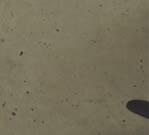
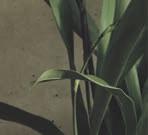

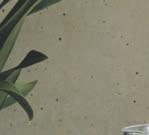




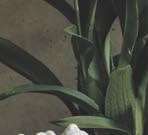


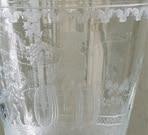




















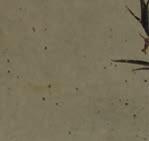

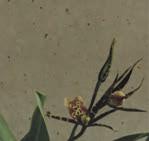



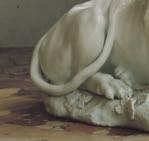

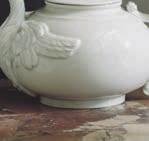
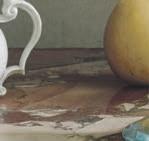




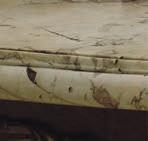
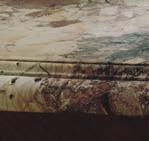





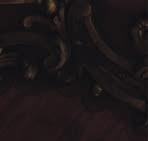









In vista delle prossime aste di Londra e Parigi, i nostri esperti di dipinti antichi, ceramiche europee, arredi, sculture e oggetti d'arte sono a disposizione per valutazioni gratuite e Consegnalo a BonhamsPerinformazionieappuntamenti Milano e Italia Settentrionale Giulia Berbotto via Boccaccio 22 - 20122 Milano Roma e Italia Centro Meridionale Emma Dalla Libera






He was supposed to make a faithful copy, but instead he turned the Venus Pudica into a sensual modern young woman. This was typical of Antonio Canova (1757-1822), an artist who lived in the Age of Enlightenment and anticipated the future by rediscovering classical art. And like Donatello, Michelangelo or Bernini, he did not limit himself to copying. He brought new vitality to the art of antiquity, making it current. And he also polished his statues with wax, turning cold Carrara marble - polished using pumice - into warm ivory, and even suggesting the position of the candles that would illuminate his works so that their oblique light would accentuate their shape. Canova found immediate fame, and was universally acclaimed for works such as Psyche Revived by Cupid’s Kiss, The Three Graces and Hebe. He was the most sought-after artist among a large portion of European nobility, loved by the Papal Court and a favourite of Napoleon. But he was also loved by those who recovered some of his works, which had been moved to Paris after the fall of Bonaparte. One of these was the Venus Pudica at the . Even though he had been asked to make a copy, Canova did things his own way, and left Florence a masterpiece, the Venus Italica (in the Galleria ). A young woman leaving the bath notices she’s being watched and tries to cover herself. She’s alive, sensual. Similarly lifelike and suffering is the impressive Italy who leans on the sarcophagus for support as she mourns with covered face the death of . The monument in the church of Santa Croce was commissioned by the writer’s companion, the Countess of Albany. Such monuments would quickly be considered distinctive to the work of an artist who died exactly two centuries ago, on 13 October 1822. And an opportunity to rediscover this comes in the form of the Antiques Biennale, where small and large masterpieces from the age of Canova are found halfway between Neoclassicism and Romanticism.
Avrebbe dovuto copiarla fedelmente e invece trasformò la Venus Pudica in una moderna, sensuale, ragazza. Era così Antonio Canova (1757-1822), un artista che visse nel secolo dei lumi e anticipò il futuro riscoprendo l’arte classica. E come Donatello, Michelangelo o Bernini non si limitò a copiare. Dette all’antico una nuova vitalità, lo rese attuale. E levigò le sue statue con la cera, trasformando il freddo marmo di Carrara, lucidato a pomice, in un caldo avorio, suggerendo anche la posizione delle candele che dovevano illumi nare le sue opere di luce radente per far risaltare le forme.
come Amore e Psiche, le Tre Grazie, Ebe. Fu l’artista più ricercato preferito di Napoleone. Ma anche colui che dopo la caduta di Bonaparte recuperò parte delle opere portate a Parigi. Tra queste c’era la Venus Pudica degli . Tanto che gli avevano chiesto di farne una copia, lui invece fece di testa sua, lasciando a Firenze un capolavoro: la Venere Italica (alla Palatina). Una fanciulla che uscendo dal bagno scopre di essere osservata e prova a coprirsi. E’ sensuale, viva. Così come sofferente e vera è la possente Italia che si appoggia al sarcofago per non svenire dal dolore mentre piange, coprendosi il volto, la morte di . E’ la contessa di Albany e compagna dello scrittore a incaricare Canova del monu mento in Santa Croce. Monumenti che diverranno presto un’altra delle caratteristiche peculiari dell’artista morto, esattamente due secoli fa, il 13 ottobre 1822. E l’occasione per riscoprirlo è offerta anche dalla Biennale dell’Antiquariato dove si trovano piccoli e grandi capolavori del tempo di Canova a metà strada tra neoclas sicismo e romanticismo.
 Venere Italica by Canova, Galleria Palatina
Venere Italica by Canova, Galleria Palatina
biennaleantiquariato 35
ANNIVERSARY CANOVA 200 years after his death we celebrate him like this A 200 anni dalla scomparsa lo celebriamo così
1.
2.
ABOUTREADINGART
With many thanks to Art&Libri, the international book store for the arts, architecture and antiques. Florence, Via dei Fossi 32/r
1. M. G. Bernardini, Bernini. Catalogo delle sculture, 2 volumes, Allemandi

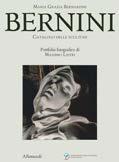
Based on the groundbreaking work published in 1955 by Rudolf Wittkower, this two-volume work further examines the entire sculptural output of Gian Lorenzo Bernini (1598-1680).
the past decade, archive acquisitions, important discoveries and Bernini’s art.The second volume, meanwhile, includes a catalogue of his sculptures. Each individual piece is presented with technical data, documentation and bibliography, in addition to its critical re ception. The volumes are embellished with superb photography, including a wonderful interpretative portfolio by Massimo Listri.
2. A. Ottani Cavina - E. Calbi, in Italia, Silvana Editoriale
The tumultuous Italy of the late 18th century is the setting for brilliant Grand Tour painter who died at the young age of 39, hav ing spent years in Rome, Florence and the ‘beautiful areas’ of the

impact on historical, landscape and portrait painting. A body of work that rapidly placed the French artist on the international stage, in conjunction with the avant-garde movements in France, Italy and England. The culmination of lengthy and complex phil ological and archive research, the book presents a well thought out catalogue of his paintings, accompanied by a thorough pho tographic report.

1. M. G. Bernardini, Bernini. Catalogo delle sculture, 2 voll., Allemandi Basandosi sul fondamentale lavoro di Rudolf Wittkower pubbli cato nel 1955, i due volumi tornano ad indagare nel suo com plesso l’opera scultorea di Gian Lorenzo Bernini (1598-1680). Il primo volume delinea il panorama dello stato più avanzato degli studi che si sono susseguiti incessantemente negli ultimi de cenni, delle acquisizioni archivistiche, di importantissime scoperte e di nuovi campi di indagini che hanno portato a una profonda rivisitazione dell’arte di Bernini. Il secondo volume comprende, invece, il catalogo delle opere. Le schede riportano di ogni sin sua vicenda critica. Correda i volumi una superba campagna fo di Massimo Listri.
2. A. Ottani Cavina - E. Calbi, in Italia, Silvana Editoriale
dido interprete dell’arte del Grand Tour morto giovanissimo a trentanove anni, dopo aver consumato i suoi giorni fra Roma, Firenze e le ‘belle contrade’ della penisola. Dotato di straordina
paesaggio e la ritrattistica. Un complesso di opere che proiettano rapidamente l’artista francese su un orizzonte internazionale, in rapporto con le avanguardie artistiche di Francia, Italia, Inghilterra.
chivio, presenta il catalogo ragionato dei dipinti accompagnato da
36 biennaleantiquariato




Vienna, Dorotheergasse 17, 1010 Vienna Milano, Palazzo Amman +39 02 303 52 41 Roma, Palazzo Colonna +39 06 699 23 671ANTICHIDIPINTIwww.dorotheum.com
3. M. Minardi, Come la bestia e il cacciatore. Proust e l’arte dei conoscitori,

To mark the centenary of the death of Proust, this is an origi nal look at the author of . What

with the exponents of the new art of attribution in the 19th and 20th centuries, such as Giovanni Morelli and Bernard Ber enson? Gaze and insight. The ability to penetrate the essence
sense of otherwise incomprehensible plots with the astuteness of a detective or an expert hunter scenting the prey. Navigating the cosmopolitan milieu of the culture and society of the age, among writers and connoisseurs, artists, dealers and aesthetes of the Belle Époque, this book places Proust and his work in an unprecedented and extremely fascinating context.
4. , Sir Arthur Gilbert. Collecting is a Message, Sillabe
a particular emphasis on events surrounding his extraordinary art collection, today preserved in London’s Victoria and Albert Museum; it also details his encounters with prominent collectors

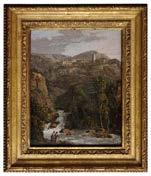
century. The text is accompanied by 300 large-format photo graphs illustrating aspects Gilbert’s life and many of the works he owned, thus offering a visual overview of his collection of decorative art, including the micro-mosaic pieces that are its crowning glory.
3. M. Minardi, Come la bestia e il cacciatore. Proust e l’arte dei conoscitori, In occasione del centenario della morte di Proust, uno sguardo inedito sull’autore della . Che cosa accomuna fra loro dell’attribuzione tra XIX e XX secolo come Morelli e Beren delle cose, di coglierne dettagli per i più trascurabili, dare senso a trame altrimenti incomprensibili con la sagacia del detective
e intenditori, artisti, mercanti ed esteti della Belle Époque, il libro cala Proust e la sua opera in un tessuto inedito e di grande fa 4.scinazione.
, Sir Arthur Gilbert. Collecting is a Message, Sillabe
gura di collezionista britannico, vissuto poi in America dal 1943, soffermandosi in particolare sulle vicende legate alla sua ricchis sima raccolta d’arte oggi conservata all’interno del Victoria and portanti collezionisti e personaggi pubblici che ebbe modo di corredato da 300 immagini di grande formato, relative a ele consentendo così d’abbracciare visivamente la sua collezione d’arti decorative che ha nei pezzi in micromosaico il proprio punto d’eccellenza.
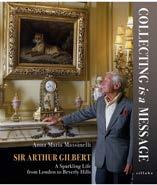 With many thanks to Art&Libri, the international book store for the arts, architecture and antiques. Florence, Via dei Fossi 32/r
3. 4.
With many thanks to Art&Libri, the international book store for the arts, architecture and antiques. Florence, Via dei Fossi 32/r
3. 4.
38 biennaleantiquariato

ARTSTUDIO SAS Giuliano Cappuzzo & C Via Maggio, 41 r 50125 Firenze tel. ANTONIOcell.cell.05528298734055749903298006946CALZA (Verona 1658 - Verona 1725) BATTAGLIA TRA CRISTIANI E TURCHI Olio su tela (cm 130x100) Scuola Veneta
5. Riccardo Scamarcio in Caravaggio’s Shadow


ART AND CINEMA
1. Munch. Love, Phantoms and Lady Vampires
The whole world is familiar with his Scream, but very few know about Munch’s other works or details about his life, a deeply fascinating and mysterious man.

2. Botticelli and Florence. The Birth of Beauty

In Florence at Renaissance workshops to explore the life and works by Sandro Botticelli, the inventor of an ideal and eternal beauty. From his debut
3. Caravaggio’s Shadow
shocking. A damned soul and brilliant artist, a sort of rock star ahead of his time. The cast includes Louis Garrel, playing the mysterious Shadow, Micaela
4. Dalì Land
years of the artist’s marriage with Gala, the love of his life and muse. A biopic told through the eyes of James, a young and ambitious assistant, who helps
5. Dante
1. Munch. Amori, fantasmi e donne vampiro Tutto il mondo conosce il suo Urlo, ma sono ben pochi quelli che conoscono altre opere o dettagli della vita di Munch, un uomo dal fascino profondo e gia interrogandosi sul tema principale del suo multiforme lavoro: la sua idea
2. Botticelli e Firenze. La nascita della bellezza e dell’arte di Sandro Botticelli, inventore di una bellezza ideale e eterna.
3. L’Ombra di Caravaggio
Un artista maledetto dal talento assoluto, una sorta di rockstar ante litteram.
4. Dalì Land monio con la Gala, compagna di vita e musa. Un biopic raccontato attraverso gli occhi di James, un giovane e ambizioso assistente, che aiuta l’eccentrico e
5. Dante

The men behind the greatest masterpieces ever created Gli uomini dietro alcuni dei più grandi capolavori di sempre Dante by Pupi Munch. Love, Phantoms and Lady Vampires Botticelli and Florence. Birth of Beauty
40 biennaleantiquariato
1.
2.AvatiDalì 3.
4.
The
1. 3. 4. 2.5.

PHILIPP PETER ROOS (DETTO ROSA DA TIVOLI) (Sanki Goar 1657-Roma 1706) SCENA PASTORALE Olio su tela (cm ARTSTUDIO130x95) SAS Giuliano Cappuzzo & C Via Maggio, 41 r 50125 Firenze tel. cell.cell.05528298734055749903298006946
He is Italy’s leading fashion photographer, and one of the greatest ever. The son of a dealer in luxury textiles, Gian Paolo Barbi eri was born in 1935 in Milan where, in 1964, he opened his studio aged just 26. Today the Lombardy capital is home to his Foundation, created to pro mote the artistic heritage of his archive, which contains over a million images as well countless publications, sculptures and paintings.This allows public access to an ex tremely useful research tool that extends from the 60s to the present day. Before fashion, as a young man you worked

I’ve always been attracted to theatre and
called “Trio”. I enjoyed acting, creating the costumes and the scenery and experi menting with the use of light, trying to im
every night, trying to sneak in with the bit players so I could see the shows several times. When I was 15 or so, the Teatro Manzoni in Milan was often looking for ex tras. I heard they wanted particularly tall people for the king’s guards in Medea, but when I got there, the head of casting said I was perfect to play the king’s son: I would be working with the great director Luchi no Visconti! This was followed by other ex periences and other encounters, like the him to play an extra, but he asked me to
di moda in Italia, e uno dei più grandi nella storia. Figlio di un commerciante di tessu ti di pregio, Gian Paolo Barbieri è nato a Milano nel 1935, dove nel 1964, appena 26enne, apre lo studio. Oggi nel capoluo go lombardo ha sede la sua Fondazione, nata per divulgare un patrimonio artistico costituito nell’archivio, che custodisce oltre un milione di scatti, oltre a innumerevoli pubblicazioni, sculture e dipinti, rendendo accessibile al pubblico uno strumento di ricerca molto potente che va dagli anni ’60 ad
Sonooggi.sempre
stato attratto dal teatro e dal cinema. Fin da piccolo ero solito ripro
amici con i quali avevo fondato un gruppo, il ‘Trio’. Mi divertivo a recitare, a fare gli abiti
Mi recavo tutte le sere a teatro cercando spettacoli più volte. Quando avevo 15 anni o giù di lì, il Teatro Manzoni di Milano era spesso alla ricerca di comparse. Capitò che ne cercassero di particolarmente alte per le guardie del re in La Medea, ma quando mi presentai il capo comparsa disse che
avrei lavorato con il grande regista Luchino Visconti! Seguirono altre esperienze e altri Ero andato da lui per fare solo la comparsa,
42 biennaleantiquariato
FROM WORK TO maestroLafashionLessonsMASTERPIECEfromtheItalianmaestroofphotographyGianPaoloBarbierigrandelezionediGianPaoloBarbieridellafotografiadimodatextTERESAFAVIphoto©GIANPAOLOBARBIERICOURTESYOFFONDAZIONEGIANPAOLOBARBIERIBARBIERIHASWORKEDWITHMONUMENTSOFWORLDFASHIONSUCHASDIANAVREELAND,YVESSAINTLAURENT,VALENTINOANDVIVIENNEWESTWOODGianPaoloBarbieri(ph.HermesMereghetti)
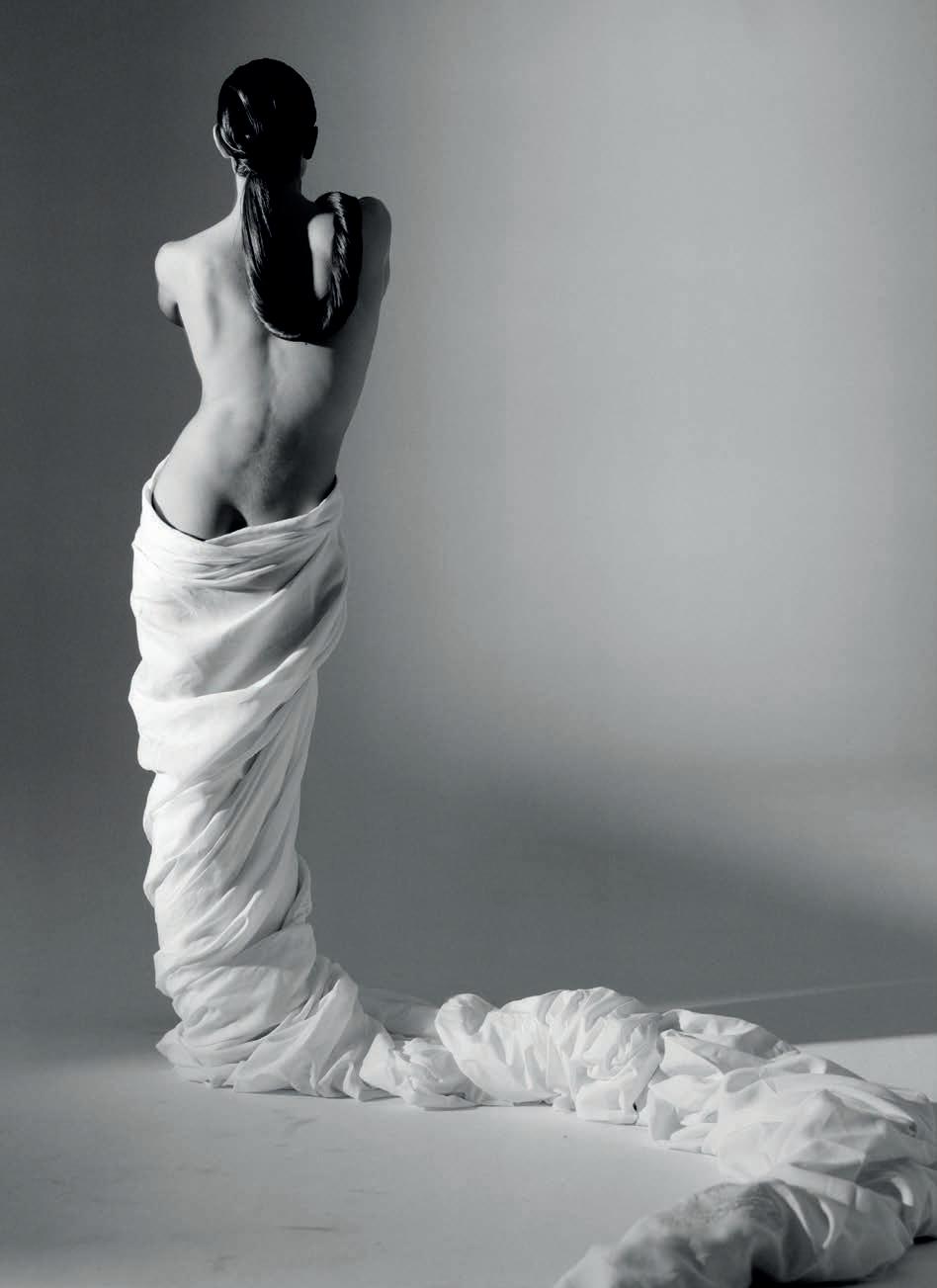 Catherine Noyes for Interview, Milano 1986
Catherine Noyes for Interview, Milano 1986
 Monica Bellucci, Milano 2000
Monica Bellucci, Milano 2000
catapulted into the Rome of Dolce Vita. I met a lot of people in that period, includ ing Pasolini.
It was a meeting with Gustave Zum
changed my life, He knew my father, and he asked me to show him the photos I was taking of the starlets who wanted to work at Cinecittà. I considered them to be amateur, but I showed them to him any
you’re cut out to work in fashion” was his comment. I didn’t even know what fashion was. In Italy, magazines used to buy photo graphic features ready-made from France. With this in mind, I returned to Milan and, as luck would have it, I was invited to Paris by Tom Kublin, a photographer working for Harper’s Bazaar assistant during the campaigns for the new collections. It was the hardest three weeks of my life, but I learned everything about photography and fashion.
ant, but I’d like to tell you about one of the crazy projects I did with another equally extraordinary designer, Vivienne West wood. In 1997 she’d created a collection inspired by pirates, and she asked me to do the campaign. So, drawing on what had motivated me during the time we’d known each other, I decided to use Géricault as the starting point for the collection. I
Dolce Vita. Conobbi tanti personaggi in quel periodo, tra cui anche Pasolini.
Fu uno l’incontro con Gustave Zumsteg, mi la vita. Conosceva mio padre, mi chiese starlette che volevano lavorare a Cinecittà. Le consideravo di qualità amatoriale, ma gliele feci vedere lo stesso. “Hai una sensibi lità pazzesca, sei tagliato per fare la moda” fu il suo commento. Non sapevo neanche cosa fosse la moda. In Italia le riviste com

Francia. Con quella idea nella testa tornai a Milano e il caso volle che venissi convocato a Parigi da Tom Kublin, fotografo che lavora va per Harper’s Bazaar fatto da assistente durante le campagne per le nuove collezioni. Furono i venti giorni più duri della mia vita, durante i quali però ho
Tutti quelli realizzati con Valentino sono contare una delle mie follie realizzate insie me ad un’altra stilista altrettanto fuori dagli schemi, Vivienne Westwood. Nel ’97 aveva realizzato una collezione ispirata ai pirati e chiamò me per la campagna. Così, attingen do a ciò che più mi aveva stimolato lungo gli anni di conoscenza, decisi di ispirarmi a Géricault per raccontare quella collezione.
una testa di squalo e realizzai la mia Zattera della Medusa.
 Versace for Callaghan, Milano 1976
Versace for Callaghan, Milano 1976
biennaleantiquariato 45
FROM ViviennePASSEDFAMOUSHEPBURN,TOBELLUCCIMONICAAUDREYJUSTTHEMOSTMODELSANDACTRESSESINFRONTOFHISLENSWestwood,London1998
without it, my view of the world would be
Beautylimited. of the soul.
In the 80s, when Italian fashion photography was in crisis, my inability to bear what felt like non-existence forced me to rediscover
managed to stop and ask myself if I was re ally happy. So I distanced myself, taking ref uge in the seas of southern Italy, places I’d had the fortune of visiting for fashion jobs years previously. I continued my research by studying the local people I found my self living with, and also reestablished con tact with nature, which helped to save me. Thanks to my attraction to nature, and thus for the human form, I embarked on a proj ogy, and then in erotic photography. I didn’t awareness, but rather a need to explore something else, and that’s how I started photographing nudes in all their purity and expressive simplicity. That research gave rise to two bibliographic projects,, Dark Memo ries and Skin.
I want to hand down the knowledge and cultural awareness which allows a work to become a masterpiece.
mondo ridotta.
La bellezza dell’animo.
italiana era in crisi, il limite di sopportazione di quella ‘inesistenza’ mi spinse a ritrovare me stesso. Riuscii per la prima volta dopo tanti anni a fermarmi e chiedermi davvero se fossi felice. Così mi allontanai, rifugiando mi nei mari del Sud, luoghi che avevo avuto la fortuna di visitare grazie a dei lavori di moda realizzati lì anni prima. Sviluppai le mie ricerche personali attraverso lo studio delle popolazioni locali con cui iniziai a vive re, ritrovando anche il contatto con la natu ra che aiutò a salvarmi. Grazie all’attrazione per la natura e di conseguenza per le forme umane, sviluppai un’indagine che dapprima si concretizzò nella trilogia dei tropici, poi
le attribuii questo nome, non esisteva una consapevolezza vera e propria, era piutto sto il bisogno di esplorare altro, e fu così che allora iniziai a fotografare corpi nudi nella loro purezza e semplicità espressiva. Questa ricerca poi sfociò in due progetti Dark Memories e Skin.

Vorrei riuscire a tramandare la conoscenza e la consapevolezza culturale grazie alla qua le un lavoro può diventare un capolavoro.
 La zattera della medusa, Vivienne Westwood, London 1997
head with me and created my own Raft of the Medusa.
La zattera della medusa, Vivienne Westwood, London 1997
head with me and created my own Raft of the Medusa.
46 biennaleantiquariato
GIAN REPRESENTEDBARBIERIPAOLOISTODAYBYTHE29ARTSINPROGRESSGALLERYINMILANLauraAlvarez,Venezuela1976
 Aly Dunne in Gianfranco Ferré, Milano 1991
Aly Dunne in Gianfranco Ferré, Milano 1991
 Large Square Form with Cut 1969-71, Rio Serra marble, on exhibition at the Forte di Belvedere, Florence, Italy, 1972 photo: Henry Moore Archive Reproduced by permission of The Henry Moore Foundation
Large Square Form with Cut 1969-71, Rio Serra marble, on exhibition at the Forte di Belvedere, Florence, Italy, 1972 photo: Henry Moore Archive Reproduced by permission of The Henry Moore Foundation
48 biennaleantiquariato
BACK TO THE FUTURE
Francesco Bonami’s look at Henry Moore and Florence Lo sguardo di Francesco Bonami su Henry Moore e Firenze
text ROSSELLA BATTISTA
The city looked different through that hole that pierced the blocks of white marble. That hole sucked in the an cient and forced it to measure itself against the contempo rary. Even Francesco Bonami, now interna tionally renowned curator of exhibitions and art critic, but at the time only a curious teen ager, was so impressed by Henry Moore’s 1972 exhibition at Forte Belvedere that he remained forever marked and fascinated by contemporary art, so much so as to make it his life’s work. On the occasion of the exhi bition Back to Moore. Forte Belvedere 1972, curated by Sergio Risaliti, we asked Bonami to tell us about those emotions.
“Moore’s exhibition opened up a world: he made it clear that it was still possible to make art, art of great impact, even in a place like Florence, so tied to the past”. Like all young people at the time, he was struck by the great works that created a new world, which dis rupted the art of the Renaissance without turning it upside down. What a revelationthey could co-exist, and indeed history could still feed the fascination of research.
“That exhibition and that artist had an over whelming effect on me because they made me passionate about art. At the time I was not involved in any artistic activity, but those monumental works, standing out and rede with me forever. It was a unique experience. Thanks to that exhibition, I began to think of art as something that was an opportunity. An art that could be something else, a different
La città appariva diversa attraverso quel buco che forava i blocchi di marmo candido. Quel buco risucchiava l’antico e lo costrin geva a misurarsi col contemporaneo. Anche Francesco Bonami, oggi curatore di mostre e critico d’arte di fama internazionale, ma al tempo solo un adolescente curioso, fu così colpito dalla mostra di Henry Moore a Forte Belvedere del 1972, da rimanere per sempre segnato e affascinato dall’arte con temporanea, tanto da farne una professio ne. In occasione della mostra Back to Moore.
Forte Belvedere 1972, curata da Sergio Risa liti, abbiamo chiesto a Bonami di raccontarci quelle emozioni

“La mostra di Moore aprì un mondo: fece capire che si poteva ancora fare arte, un’ar te di grande impatto, anche in un luogo come Firenze, così legato al passato”. Come tutti i giovani al tempo rimase colpito dal le grandi opere che creavano un mondo nuovo, che scardinavano, senza stravolgerlo l’universo rinascimentale. Che rivelazione: ci potevano convivere e anzi la storia poteva alimentare ancora la fantasia della ricerca.
“Quella mostra e quell’artista ebbero un effetto stravolgente su di me perché mi fecero appassionare all’arte. Al tempo non ero coinvolto in nessuna attività artistica, ma quelle opere monumentali che si stagliano
accompagneranno per sempre. Fu un’espe rienza unica.
Grazie a quella mostra cominciai a pensare all’arte come a qualcosa che fosse un’op portunità. Un’arte che poteva essere altro, un modo diverso di guardare la natura. Al
‘MOORE MADE IT CLEAR THAT IT WAS
Henry Moore, Florence, Italy, November 1971 permission of The Henry Moore
biennaleantiquariato 49
forHenryOFMAKEPOSSIBLESTILLTOART,ARTIMPACT,EVENINAPLACELIKEFLORENCE,SOTIEDTOTHEPAST’MoorevisitingtheFortediBelvedereasitevisitpriortotheexhibitionMostra di
(ph. ReproducedMarchioriby
Foundation)



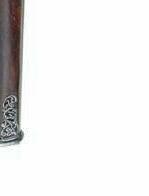



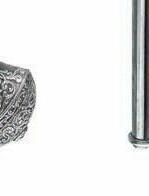

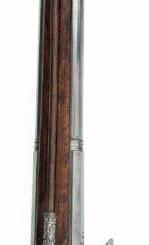






PIETRO ALZANO Coppia di pistole a due canne girevoli Ferro inciso e cesellato, radica di noce Brescia seconda metà del XVII secolo Misure: lunghezza 60 cm GALLORI TURCHI ANTICHITÀ Via Maggio n. 12/14/18/20 r. - 50125 Firenze Tel: +39 (0)55 28 22 79 | +39 (0)55 2776491 | +39 347 9337168 info@galloriturchi.com WWW.GALLORITURCHI.COMGALLORITURCHIGALLORITURCHI Gallori Turchi 1942 ANTICHITA’ FIRENZE
way of looking at nature. At the time I even thought it was easy to make contemporary art. And instead...”.
A big mistake, but at 15-16 everything seems easy. So much so that like many of his peers, Bonami too was fascinated by the great works without giving weight, at the time, to the draw ings. “Behind all of Moore’s sculpture, there is a great designer. Something I appreciated later, and it should not be forgotten that Michelan gelo was his inspiration. But if you don’t have the seed, you can be a great designer without ever becoming an artist. Certainly, a person can learn, but if the idea, the idea that makes the difference is not there, they will always re main a craftsman, as talented as they are cre ative, but not an artist “. Thoughts inevitably turn to Perugino to look to the past, or more recently to Annigoni. Very valid but without that idea that generates the difference, which transforms an object into something different, into a new life.

“Moore was attracted to plant and animal fos sils: he drew them on every occasion. From there he worked out his vaguely anthropo morphic forms, his abstract volumes, forms that followed a vision of art and research. Just as Michelangelo had done in his time, putting forward his vision of the earthly and celes tial world in his sculptures and designing his works accordingly”.
A great exhibition which also put the seal on a fortunate coincidence of events, such as the renewed economic pact with England, so much so that it was Princess Margaret her self who inaugurated the exhibition, or the relaunch of the stonecutting business (Moore
COINCIDENCEWHICHEXHIBITIONGREATALSOPUTTHESEALONAFORTUNATEOFEVENTS,SUCHASTHERENEWED
fare arte contemporanea. E invece...”. Un bell’errore, ma a 15-16 anni tutto ap pare facile. Tanto che come molti suoi co etanei anche Bonami fu ammaliato dalle grandi opere senza dar peso, al momento, ai disegni. “Dietro tutta la scultura di Moo re invece c’è un grande disegnatore. Cosa che ho apprezzato poi in seguito e non va dimenticato che il suo ispiratore fu proprio Michelangelo. Ma se non si ha il seme si può essere grandi disegnatori senza diventare mai degli artisti. Si può imparare certo, ma se uno non ha l’idea, lo spunto che fa la dif ferenza, rimarrà sempre un artigiano, bravis simo quanto creativo, ma non un artista”. Il pensiero va inevitabilmente a Perugino per guardare al passato o più di recente ad Annigoni. Validissimi ma senza quell’idea che genera la differenza, che trasforma un oggetto in qualcosa di diverso, in una vita “Moorenuova. era attratto da fossili vegetali e animali: li disegnava in ogni occasione. Da qui ne elaborava le sue forme, vagamente antropomorfe, i suoi volumi astratti. Forme che seguivano un visione dell’arte e della ri cerca. Così come a suo tempo aveva fatto Michelangelo che nelle sue sculture ripro poneva la sua visione del mondo terreno e celeste e progettava le sue opere in funzio ne di questa”.
Una grande mostra a suggello anche di una felice coincidenza di eventi, come un rin novato patto economico con l’Inghilterra, tanto che fu la stessa principessa Margaret a inaugurare la mostra, o il rilancio dell’atti
 Henry Moore drawing in Gildmore Graphics Studio, Perry Green, c.1982
Photos from the exhibition Back to Moore. Forte Belvedere 1972
Henry Moore drawing in Gildmore Graphics Studio, Perry Green, c.1982
Photos from the exhibition Back to Moore. Forte Belvedere 1972
biennaleantiquariato 51
A
was called to work at Henraux in Seravezza), but all this did not generate any innovative thrust for Florence. A great missed opportu
between wanting to be contemporary and staying anchored to the past is dominant. So even when it came to Moore the oppor tunity was not grasped. I am referring to the famous Buco (Square Form with Cut) that Florence failed to acquire, and which was bought by Prato, thanks to a group of wool manufacturers. But even then, it was placed anonymously and without enhancement in the middle of a roundabout - although it was still better than Florence had done. Unfortu nately, the city is anchored in the 19th centu ry - Bonami notes. A fruitful, vital period from an urban planning perspective, with the great transformation of the avenues, the creation of the Piazzale, but architecturally poor.
Just look at Piazza della Signoria - the nine teenth-century architecture is sad if you compare it with the mix of styles formed by Palazzo Uguccioni. Florence was what it was because it managed to relate different styles. We persist in not wanting to understand that cities thrive on contrasts. The sense of coex istence between different styles has been lost.
In the 1970s the city was much more creative. It was the period of radical architecture and it would be nice to go back to that spirit”. Instead it is enough for a work to be placed in the Signoria, even for just a few months, for a fuss to be kicked up - as it was for Urs Fisher’s Big Clay, brought by Bonami in 2017, and which divided the city.

CONTEMPORARYWANTINGTUSCANS,USTHECONFLICTBETWEENTOBEANDSTAYINGANCHOREDTOTHEPASTISDOMINANT’
vità lapidea (Moore fu chiamato a lavorare all’Henraux di Seravezza), ma tutto questo non generò alcuna spinta innovatrice per Fi renze. Una grande occasione persa.
voler essere contemporanei e rimanere an corati al passato è dominante. Così anche per Moore non fu colta l’opportunità. Mi riferisco al celebre Buco (Forma squadrata con taglio) che Firenze non acquistò, e che venne comprato da Prato, grazie a un soda lizio di industriali lanieri. Ma poi venne col locato in maniera anonima e senza valoriz zarlo in mezzo a una rotonda. E comunque sempre meglio di quanto non abbia fatto Fi renze. Purtroppo la città è ancorata all’800 - constata Bonami -. Periodo fecondo e fondamentale da un punto di vista urbani stico con le grandi trasformazioni dei viali, la creazione del piazzale, ma povero archi tettonicamente. Basta guardare piazza della Signoria: l’architettura ottocentesca è triste se si confronta con quel mix di stili formato
palazzo Uguccioni. Firenze è stata quella che è stata perché è riuscita a mettere in dialo go stili diversi. Ci si ostina a non voler capire che le città vivono di contrasti. Si è perso il senso della convivenza tra stili diversi. Negli anni ‘70 la città era molto più creativa. Era il periodo dell’architettura radicale e sarebbe bello tornare a quello spirito”
E invece basta che un’opera venga collocata in Signoria anche solo per pochi mesi che subito si grida allo scandalo. Come fu per la Big Clay di Urs Fisher, portata proprio da Bonami nel 2017 e che divise la città.
 Photos from the exhibition Back to Moore. Forte Belvedere 1972
Back to Moore. Forte Belvedere 1972
Photos from the exhibition Back to Moore. Forte Belvedere 1972
Back to Moore. Forte Belvedere 1972
52 biennaleantiquariato
‘FOR

LUCA GIORDANO (Napoli 1634-1705) “Ecce Homo” DUCCIFIRENZEROBERTO Firenze, via Maggio 47 rosso tel. +39 055 WWW.DUCCIROBERTO.COMducci.dipintiantichi@gmail.com0202786
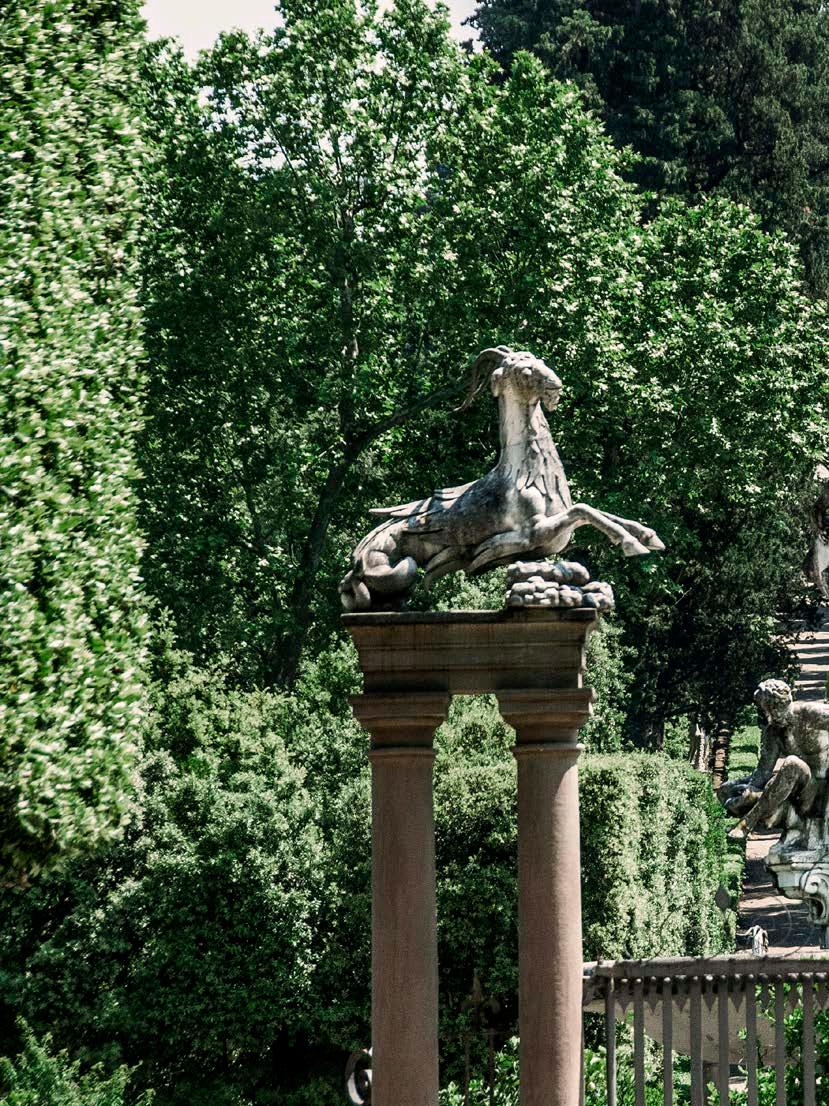 Boboli Gardens (ph. Lorenzo Cotrozzi)
Boboli Gardens (ph. Lorenzo Cotrozzi)
54 biennaleantiquariato

biennaleantiquariato 55 BROAD VIEWS Bruce Edelstein describes the fascinating figure of Eleonora di Toledo Bruce Edelstein ci racconta l’affascinante figura di Eleonora di Toledo text ROSSELLA BATTISTA
Beautiful, ethereal, as strong-willed as she was sweet. So Agnolo Bronzino immortalized her in the most famous of her portraits. But who was Eleonora di Toledo really? It is said of her that she was a beloved wife, who bought Pitti, who gave birth to a dynasty of princes. But Eleonora was much more. She was Cosimo I’s best business partner and the one who was be able to transform Tuscany into a kingdom, Florence into a court. As Bruce Edelstein, esteemed professor of Art History at New York University in Villa La Pietra tells us and explains in his impassioned book, Eleonora di Toledo and the Creation of the Boboli Gardens.
“Everything actually originated with that portrait. I have been fascinated by it since I was a student”. A passion that led him, as he became one of the most authoritative scholars on the subject, to
Spanish girl who arrived in Italy at 12, married by proxy at 17 and died of malarial fever at only 40. Five hundred years after her birth, the debate on her role is still open. Starting right from the marriage.
Professor, you speak of pragmatism - was it not, then a love match?
I’m not saying that, but I don’t think Cosimo fell in love with her when he went to Naples with his cousin Alessandro, the year before the Duke of Florence was assassinated. It was, as always, an arranged marriage carried out by proxy. Then in reality it turned out to be a great union: in fact, they become perfect accomplices in their common intent to reconcile power and money. They worked in tandem for the same goals. And this was their strength. In your book you also say that Cosimo considered himself a new Lorenzo
There are many points in common between the two: an important mother and a foreign wife. Lucrezia and Clarice for Lorenzo, Maria Salviati and a young age (by Giovanni dalle Bande Nere ed) and with a small son, but
Bella, eterea, volitiva quanto dolce. Così l’immortala Agnolo Bronzino nel più celebre dei suoi ritratti. Ma chi era veramente Eleonora di Toledo? Di lei si racconta che fu moglie amata, che comprò Pitti, che mise al mondo una dinastia di principi. Ma Eleonora fu molto di più. Fu la miglior socia in affari di Cosimo I e colei che riuscirà a trasfor mare la Toscana in un regno, Firenze in una reggia. Come ci racconta, e spiega nel suo appassionate volume Eleonora di Toledo and the Cre ation of the Boboli Gardens, Bruce Edelstein, stimato professore di Storia dell’arte alla New York University di Villa La Pietra.

quando ero studente”. Una passione che lo ha portato, divenendone uno dei più auto revoli studiosi, ad approfondire e sviscerare
arrivata in Italia a 12 anni, sposa per procura a 17 e morta per febbri malariche a soli 40. A cinquecento anni dalla nascita, il dibattito sul suo ruolo è ancora tutto aperto. A partire proprio dalle nozze. Non fu dunque matrimonio d’amore?
Non dico questo, ma non credo che Cosi mo se ne invaghisse quando andò a Napoli al seguito del cugino Alessandro, l’anno prima che il duca di Firenze fosse assassinato. Fu un matrimonio come sempre combinato e fatto per procura. Poi in realtà si rivelò un grande connubio: diventano infatti dei complici per fetti nel comune intento di conciliare potere e denaro. Lavorano all’unisono per gli stessi obiettivi. E in questo è la loro forza. Nel suo libro dice anche che Cosimo si considerasse un nuovo
Ci sono molti punti in comune tra i due: una madre importante e una moglie straniera. Lucrezia e Clarice per Lorenzo, Maria Salviati ed
SHE WAS COSIMO I’S BEST KINGDOM,ABLEPARTNERBUSINESSANDTHEONEWHOWASBETOTRANSFORMTUSCANYINTOAFLORENCEINTOACOURT
Boboli Gardens would be a model for the future palaces of Europe (ph. Lorenzo Cotrozzi)
56 biennaleantiquariato
 biennaleantiquariato
Eleonora di Toledo portrait by Agnolo Bronzino
biennaleantiquariato
Eleonora di Toledo portrait by Agnolo Bronzino
57




WWW.MAXMILIANCICCONE.COM MAXMILIAN CICCONE FINE ART STUDIO & FIRENZEGALLERY
she managed to keep the inheritance that would serve her son intact, a rare thing in her situation. She had an important diplomatic role in the Florence of the time, so much so that she would be fundamental both in choosing Cosimo as Alessandro’s successor and in choosing a daughter-in-law.
Of course. Because Eleonora not only brought the culture of the Spanish court to Florence - just consider that her mother had been lady-in-waiting to Isabella the Catholic - but she also managed to impose the etiquette, protocol and modus operandi of a royal court. And although the Spaniards were not loved because they were supporters of the sack of Prato, the siege of Florence and more, it was thanks above all to her that Florence became a principality. It was she who took care of the management of the Palazzo, which was a rather complex machine made up of people, supplies, equipment, and fabrics and clothes for every day of the year and for every single person.
But Eleonora was able do much more, right?
Of course. Eleonora had special role. Above all, she is the only one who expanded the territory by buying land in the city, but also and above all outside, in the Pisan area.
And here we come to your revolutionary
According to my studies, the landscape in the background would not in fact be that of Poggio a Caiano as has been believed up to now, but that of Pisa. A non-random choice. While the
piccolo, ma riesce a mantenere intatto, cosa rara nella sua situazione, tante nella Firenze del tempo, tanto che sarà fondamentale sia nella scelta di Cosimo a successore di Alessandro e sia nella scelta della Certo.nuora.
Perché Eleonora non solo porta a Firenze la cultura della cor te spagnola, basti pensare che sua madre era stata dama di Isabella la Cattolica, ma riesce anche a imporre l’etichetta, il protocollo e il mo dus operandi di una reggia. E benché gli spagnoli non fossero amati perché fautori del sacco di Prato, dell’assedio
‘SHE IS THE ONLY ONE
ALSOBUYINGEXPANDEDWHOTHETERRITORYBYLANDINTHECITY,BUTANDABOVEALLOUTSIDE,INTHEPISANAREA’
as a dynastic portrait - Eleonora and her son Don Giovanni as Cosimo’s property - the hypothesis of the Pisan marshes reverses Eleonora’s role - no longer an object but a subject. Because they are lands purchased by her. It is she who had herself portrayed together with her second son (the succession was assured), as an icon. It is she who controlled the new territories and who appeared as a lay Madonna: beauty, motherhood and
that surrounds her. With that dress where pine cones and pomegranates,
a lei che Firenze diventa un principato. È lei che si occupa della gestione del Palazzo che è macchina alquanto complessa fatta di per sone, di approvvigionamenti, di apparati e di tessuti e abiti per ogni giorno dell’anno e per ogni singola persona.

Ma Eleonora riesce a fare anche molto di più giusto?
Certo. Eleonora ha un ruolo speciale. È so prattutto l’unica che espande il territorio ac quistando terreni in città, ma anche e soprat tutto fuori, nel pisano, il Giglio.
E qui si arriva alla sua rivoluzionaria teoria
Secondo i miei studi, il paesaggio sullo sfondo non sarebbe infatti quello di Poggio a Caiano no. Una scelta non casuale. Mentre l’ipotesi poggese confermerebbe come proprietà di Cosimo, l’ipotesi delle paludi pisane ribalta il ruolo di Eleonora: non più oggetto ma soggetto. Perché sono terre acqui state da lei. È lei che si fa ritrarre insieme al secondogenito maschio ( la successione è assicurata), come un’icona. È lei che domina i nuovi territori e che appare come una Madonna laica: bellezza, maternità e ruolo gestionale sono fusi nello sguardo e confermati in quella sorta
Palazzo Pitti (ph. Dario Garofalo)
biennaleantiquariato 59
mother and wife.
She created a hanging garden in Palazzo Vecchio, had terraces and gardens painted in her apartments. It is no coincidence that she is always portrayed

family and her children healthy. And everything points to an increase in properties also for security reasons, as well as the primary function of gardens and water supply for the palace and the city. It was in her time
Neptune in Piazza della Signoria with the water
things she planted were wheat and vines. On the other hand, she had a monopoly on wheat and she sold the surplus to Spain So Boboli as an evolution of the Medici garden
I think it’s different. It is more connected to Pozzuoli where after the earthquake, Pedro (Eleonora’s father ed) bought land and a house to revive the city by bringing fresh water. Likewise, Boboli was a source of water. In Pozzuoli, Pedro planted wheat and grapes and so would his daughter in Boboli. From the beginning Boboli was one with the city. The garden that Tribolo created would be a model for the future palaces of Europe, starting with the Luxembourg Gardens in Paris created by Mary, Queen of France on the death of her husband. The amphitheatre of greenery, as it appears in the lunette by Giusto Utens made about forty years after Eleonora’s death, gives us a fairly true image of the Boboli she wanted - an agricultural, safe place.
Which is a place that has remained intact? I would say the Grotticina created for her and never transformed. It is an environment in perfect Eleonora style. Unlike the Buontalenti Grotto which
di aureola che la circonda. Con quell’abito dove pigne e melograni, frutti tipici della maternità e di apparati liturgici, ne confermano il ruolo di madre e moglie.
Certo per prima cosa va ricordato il suo forte legame con la terra. Lei crea un orto pensile a palazzo Vecchio, fa dipingere terrazzi e giardini nei suoi appartamenti. Non a caso è sempre ritratta come Cerere, Opi, Abbondanza. Il suo primo pensiero è sempre come mandare avanti, in
anche a motivi di sicurezza, oltre che alla funzione primaria di orti e approvvigionamento idrico per la reggia e la città. È con lei che si crea la prima fontana pubblica (il Nettuno in piazza della Signoria con l’acqua che viene da Boboli). Basti pensa re che le prime cose che pianta sono grano e viti. Del grano aveva peraltro il monopolio e l’eccedenza lo rivendeva alla Spagna. Quindi Boboli come evoluzione del giardino
Credo sia diverso. È più collegabile a Pozzuoli dove Pedro (il padre di Eleonora, ndr) dopo il terremoto acquista terreno e casa per far rinascere la città portando acqua fresca. Allo stesso modo è Boboli: fonte di acqua. Pedro a
a Boboli. Fin dall’inizio Boboli è un unicum con la città. Il giardino che creerà il Tribolo farà da modello alle future regge d’Europa a par tire dal Luxembourg di Parigi voluto da Maria,
appare nella lunetta di Giusto Utens realizzata dopo una quarantina dopo la morte di Eleonora, ci rimanda un’immagine abbastanza veritie ra del Boboli voluto da lei: un luogo agricolo e sicuro.
E un luogo rimasto intatto?
Direi la Grotticina creata per lei e non più trasformata. È l’ambiente eleanoriano perfetto. A differenza della Grotta del Buontalenti che al tempo era un invaso con vivaio ittico.
ph. Niccolò Rastrelli
‘HER HERCONCERNFIRSTWASALWAYSHOWTOKEEPHERFAMILYANDCHILDRENHEALTHY’
60 biennaleantiquariato



VIA MAGGIO, 13 | 50125 - FIRENZE | tel . +39 055 287519 www.gherardodeglialbizzi.com | info@gherardodeglialbizzi.com DEGLIALBIZZILAMPADARI GHERARDODEGLIALBIZZI GHERARDODEGLIALBIZZI
 Portrait of a Young Man by Bronzino
Portrait of a Young Man by Bronzino
ITALY IN THE WORLD
Keith Christiansen from the Met in New York, a distinguished member of the BIAF Vetting Committee Dal Met di New York, Keith Christiansen, autorevole membro del Comitato Vetting di BIAF
text VIRGINIA MAMMOLI photo COURTESY METROPOLITAN MUSEUM OF ART
Keith Christiansen’s career begins at one of the world’s most important museums, the Metropolitan Museum of Art in New York, where he was chairman of the department of European paintings. An art historian specialis ing in Italian painting, he has curated major Met exhibitions on prominent Italian artists from the Renaissance to the Baroque. He is invited to Florence to join the Vetting Committee of the International Antiques Biennale, whose role is to verify the authenticity of information pro vided by exhibitors about the works on offer, from the identity of the artist to more techni cal aspects. The committee has the power to the piece.

During your long career at the New York Met you have curated and coordinated a huge number of exhibitions by the greats of Italian art. Can you tell us about the most important ones?
Thanks to the collaboration of distinguished colleagues, many of them Italian, I have been able to coordinate exhibitions at the Met on Caravaggio, Mantegna, Tiepolo, and Orazio and Artemisia Gentileschi, but also on 15th-century painting in Siena, 16th-17th-century painting in Emilia, Italian portraiture of the 15th century and, most recently, portraiture at the court of Cosimo I de’ Medici (thanks to Carlo Falciani). And many other artists with links to Italy, such as El Greco, Ribera, Valentin de Boulogne and Poussin.
Your favourite Italian artist? I honestly don’t know… it depends on the day
La carriera di Keith Christiansen inizia da uno dei più importanti musei al mondo: il Metro politan Museum of Art di New York, a cui si
del Dipartimento di dipinti europei. Storico dell’arte specializzato nell’arte italiana, per il museo newyorkese ha curato grandi mostre dedicate ad alcuni dei più illustri nomi italia ni dal Rinascimento al Barocco. A Firenze è stato invitato a fa parte del Comitato Vetting della Biennale Internazionale dell’Antiquaria
delle informazioni fornite dagli espositori ri guardo alle opere proposte, a partire dall’au
tare l’opera. Nella sua lunga carriera al Met di New York ha curato e coordinato moltissime mostre con grandi autori dell’arte italiana. Ci rac conta le più importanti?
Grazia alla collaborazione con colleghi in signi, spesso italiani, ho potuto coordinare per il Met mostre su Caravaggio, Mantegna, Tiepolo, Orazio e Artemisia Gentileschi, ma anche sulla pittura del ‘400 a Siena, e la pit tura del ‘500/‘600 in Emilia, il ritratto italiano nel ‘400 e, ultimamente, il ritratto alla corte di Cosimo I de’ Medici (grazie alla collabora zione di Carlo Falciani). Oltre ad altri artisti legati all’Italia come El Greco, Ribera, Valentin de Boulogne, e Poussin. Sempre lavorando con un collega, che è un’esperienza unica. L’artista italiano che ama di più?
Francamente non saprei… dipende del gior no e dove sono. Simone Martini? Tiepolo? Poussin? Di recente sono stato a Venezia.
biennaleantiquariato 63
HASCOMMITTEETHETHEPOWERTOCORRECTSPECIFICATIONSOFTHEWORKSANDULTIMATELYTOREJECTTHEPIECEKeithChristiansen
and where I am. Simone Martini? Tiepolo? Pous sin? I was in Venice recently; so perhaps Giovan ni Bellini, a painter who touches the soul. And one associated with Florence?
gelico.
What kind of Italian art is most highly valued on the foreign market?

gious subjects, unfortunately. In general, I think European collectors are more open to works with a strong presence and distinctive quality, not necessarily by well-known artists.
Record-breaking sales in recent years?
In terms of Italian works by old masters, I be lieve it’s Orazio Gentileschi’s beautiful painting Danaë and an important Giovanni Segantini work, both acquired by the Getty Museum. In addition, Botticelli’s Christ sold in New York in
canvas sold in Paris almost three years ago; not to mention the Christ attributed to Leonardo da Vinci.
An unexpected attribution that shocked the art world?
Undoubtedly the Ecce Homo by Caravaggio, which was offered for sale last year in Madrid (at the Ansorena auction house). I can’t think of another example of an unknown work that gained the consensus of nearly all the experts so quickly. The conversation on WhatsApp was remarkable. But there are often noteworthy discoveries. If I may say so, I believe the small devotional panel by a 14th-century Bohemian artist bought by the Met at an auction in Dijon is one of the most unexpected and important discoveries of recent years.
Dunque, forse Giovanni Bellini, un artista che parla al cuore.
E quello legato a Firenze?
Fra’ Angelico?
A livello di mercato estero, cos’è più ap prezzato dell’arte italiana?
In America senz’altro grandi nomi e soggetti non religiosi, purtroppo. Credo che, in gene rale, i collezionisti europei siano più aperti a opere con una forte presenza e notevole
artista ben noto.
Le vendite record degli ultimi anni?
Parlando di opere italiane di antichi maestri penso al bellissimo quadro di Danae di pinto da Orazio Gentileschi e l’importante Giovanni Segantini comprati tutte e due dal Getty Museum. Inoltre, il Cristo di Botticelli venduto a New York a gennaio e certamente anche la piccola tavola dipinta da Cimabue venduta a Parigi quasi tre anni fa. Per non par lare del Cristo attribuito a Leonardo da Vinci. Un’attribuzione inaspettata che ha ‘scon volto’ il mercato?
Certamente l’Ecce Homo di Caravaggio messo in vendita a Madrid (alla casa d’asta Ansorena) l’anno scorso. Non conosco un altro esempio di un quadro sconosciuto che ha attirato così rapidamente il consenso di quasi tutti gli specialisti. La conversazione su WhatsApp è stata notevole. Ma ci sono spesso scoperte notevoli. Se posso dire, penso che la piccola tavola devozionale di un artista boema del Trecento comprata dal Met in asta a Digione sia una dei più inaspet tate e importanti scoperte degli ultimi anni.
 A room The Medici. Portraits & Politics, 1512-1570 exhibition at the Met
A room The Medici. Portraits & Politics, 1512-1570 exhibition at the Met
64 biennaleantiquariato
‘THE NECESSARILYPRESENCECOLLECTORSEUROPEANAREOPENTOWORKSWITHASTRONGANDQUALITY,NOTBYWELL-KNOWNARTISTS’CosimoIde’MedicibyBaccioBandinelli
Artista Italiano, sesto decennio del XVIII secolo. ros P etto della F ontana di t revi Matita, penna e inchiostro bruno e nero con rialzi a biacca, mm 860 x 1140
Il nostro disegno è un progetto per la sistemazione della Fontana di Trevi eseguito nell’ambito del concorso indetto nel 1732 da papa Clemente XII Corsini, per la realizzazione della ‘Mostra dell’Acqua Vergine’ poi vinto da Nicola Salvi.
a destra la Vergine da cui il nome dell’Acqua Vergine, e a sinistra Marco Agrippa, committente

VIA ALIBERT 16a (angolo via Margutta) - 00187 ROMA tel. +39 06 32651679 | cell. +39 3355631401 info@paoloantonacci.com - www.paoloantonacci.com STAND N.75 - PRIMO PIANO
P
ART HAS MADE ME A BETTER PERSON
Piero Chiambretti, special guest of the XXXII edition of the BIAF Piero Chiambretti, ‘padrino’ d’eccezione della XXXII edizione di BIAF
text VIRGINIA
AMAMMOLI
razor-sharp TV writer and presenter capable of pungent and hilarious dialogues, but also a man of culture. For the opening of this edition of the BIAF, Fabrizio Moretti has chosen Piero Chiambretti, one of the most beloved faces of Italian television. “I am very pleased to be at the Biennale of Florence as Chiara Ferragni by Fabrizio Moretti. I will try
That is how he answered, joking as usual, when we contacted him by phone a few days before the opening night. You and Fabrizio Moretti have known each other for a long time. Yes, we have been great friends for more than 20 years. I have great esteem for him as even today he is still an easy-going person, but at the same time I have seen him grow a lot professionally, and also artistically. I believe that you have to be an artist yourself to recognise art, to know what to buy and then resell it with the best results. Were you already passionate about art or did you come into contact with the art world thanks to this friendship?
I have always loved art and I think it is a necessary element in a country’s health. Looking at a painting, I can become completely absorbed. The aspect that most fascinates me is the artist’s creativity, that typical mix of talented they must always improve themselves and also because the competition who always try to judge and say that something if beautiful or ugly, but has Dalì used to say: “Drawing is sincerity in art. There are no chances to cheat.
explore the world of art, and this has also helped me to improve my taste as a television writer.
What is your opinion of the world of antiques?
I think it is a bit too closed. It needs events like the Biennale that has deep roots in the past but also an international reach and has the possibility of giving a contemporary look to this sector.
A comment on Florence?
Florence is a city that I know well thanks to some friendships, including the one with Fabrizio. Then there is the link with my city, Turin; they are sister cities, also in football. Two cities that have both been the capital of Italy in the past, and are still today two of the most important centres of culture.
Autore e conduttore televisivo acuto, pungente quanto basta, ed esi larante, ma anche uomo di cultura.
A dare il via a questa edizione di BIAF Fabrizio Moretti ha chiamato Piero Chiambretti, uno dei volti più amati della televisione italiana. “Sono molto lieto di essere alla Biennale di Firenze in qualità di Chia ra Ferragni di Fabrizio Moretti. Cercherò di dare il massimo e avrò
simpatia, quando lo raggiungiamo al telefono. Quella con Fabrizio Moretti è ormai una conoscenza di lunga data. Sì, siamo grandi amici da più di 20 anni. Lo stimo molto, perché è rimasto una persona semplice, ma allo stesso tempo l’ho visto cre scere professionalmente e quindi anche artisticamente. Credo infatti che occorra essere a sua volta artisti, per riconoscere l’arte, saperla acquistare e poi rivenderla con i migliori risultati. Era già appassionato o quest’amicizia ha contribuito a farla avvici nare al mondo dell’arte? Ho sempre amato l’arte e credo che sia fondamentale per la salute di un Paese. Un quadro è capace di assorbirmi completamente e l’aspetto che più mi affascina è la creatività, mix di energia talentuosa e disperazione cronica, quella tipica dell’artista, disperato perché deve trovare l’idea, perché deve ogni volta superare sé stesso e perché la concorrenza è sempre stata forte, anche in epoche lontane. Senza contare la critica, che cerca sempre di giudicare cosa è più bello e cosa più brutto, quando invece, come diceva Dalì: “Il disegno è la mondo dell’arte e questo ha migliorato la mia sensibilità anche come autore televisivo. Cosa pensa del mondo dell’antiquariato? Credo sia un po’ chiuso su sé stesso, e che abbia bisogno di eventi come la Biennale, con radici profonde nel passato ma dallo sprint internazionale, capace di dare una veste contemporanea al settore. Un suo pensiero su Firenze? Firenze la conosco bene grazie ad alcune amicizie, come quella con Fabrizio. Poi c’è il gemellaggio, anche calcistico, tra Firenze e la mia città,Torino. Due città che sono state capitali d’Italia e ancora oggi due poli culturali di primissimo ordine.
66 biennaleantiquariato
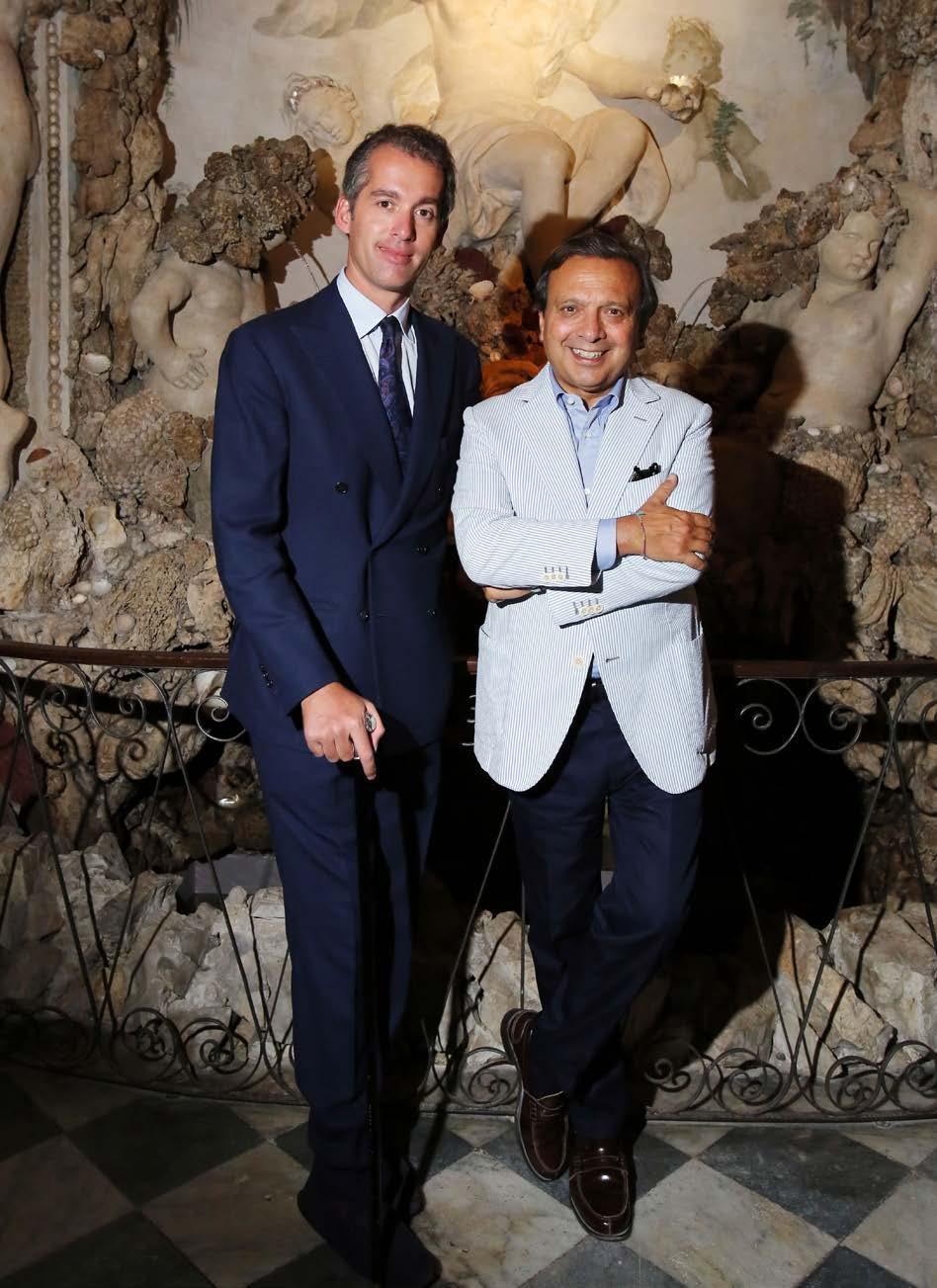 The great TV writer and showman Piero Chiambretti with Fabrizio Moretti
The great TV writer and showman Piero Chiambretti with Fabrizio Moretti
Family Group 1948-49 in Perry Hertfordshire.Green,
This sculpture returns to Florence, to the churchyard of the Abbey of San Miniato al Monte, for the Henry Moore in Florence exhibition (up to 31 March) (ph. HenryArchive)Moore
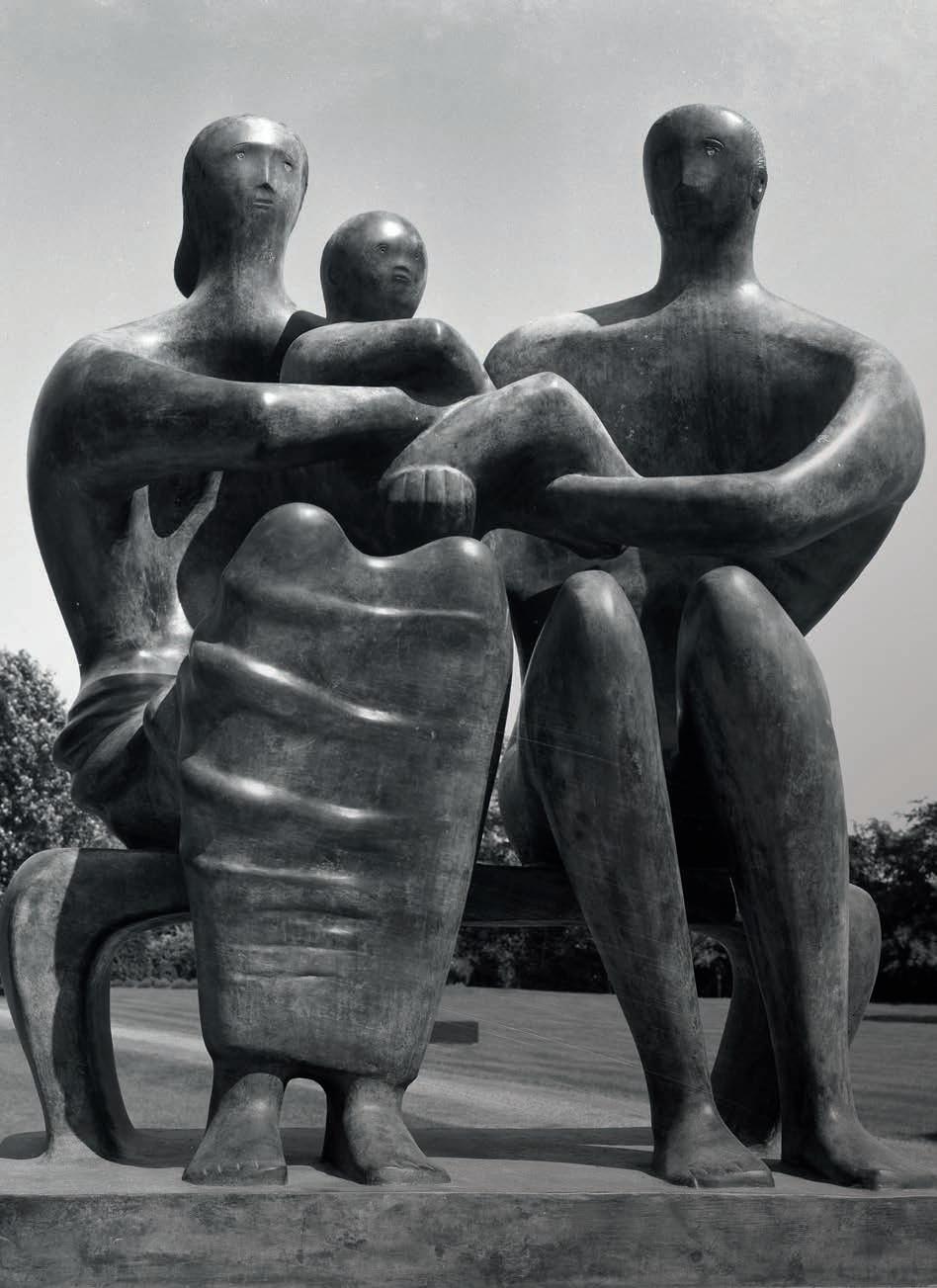
PASSION FLORENCE
Sergio Risaliti tells us about the Museo Novecento’s and city programme
Sergio Risaliti ci racconta il programma del Museo Novecento e della città
text FRANCESCA LOMBARDI
An event-packed calendar in which past and present seek out connections and reciprocal references. Intersecting interpretations and in-depth analysis of artworks from today and yesterday, conducted by Sergio Risaliti, director of the Museo Novecento.
What is the Effetto Novecento?
An extraordinarily rich programme of events, which we decided to concentrate during Florence Art Week, a time when Florence is the centre of global attention. We’re presenting ourselves to the world with a calendar that I’m per sonally very enthusiastic about. Which event is the conceptual starting point for this crescendo of art and culture?
The Henry Moore in Florence exhibition is certainly the continuation of a project that started in 2015 with the BIAF and Fabrizio Moretti, and which brought Jeff Koons and later Urs Fisher to Florence’s Piazza della Si gnoria. In this case it’s a double anniversary: 50 years since the unforgettable exhibition at Forte Belvedere in 1972, the city pays trib ute to the English artist with a project organ ised in collaboration with the Henry Moore
TwoFoundation.monumental works, Family Group and Large Interior Form, are displayed in two sym bolic sites in the city, the churchyard of the Abbey of San Miniato al Monte and Piazza della Signoria respectively, in dialogue with Florence’s historical and artistic heritage. These form a conceptual triangle that connects the two sites with Forte Belvedere, in the tradi tion of comparison followed in recent years by the Museo Novecento
Family Group links to the spiritual value of the work sited at San Miniato; while for the work located in Piazza della Si gnoria, the site was chosen for the dialectic comparison with the mon umental sculpture of the square itself. In particular, the serpentinata or spiral form employed by Michelangelo from David onwards - consider
Un calendario ricco di eventi, dove passato e presente rintracciano collegamenti e rimandi reciproci. Letture incrociate e analisi profonde di opere d’arte e artisti di oggi e di ieri portate avanti da Sergio Risaliti, direttore del Museo Novecento.
Cos’è Effetto Novecento?
Un palinsesto ricchissimo di eventi che abbiamo voluto concentrare nell’ambito della settimana della Florence Art Week, in un momento in cui Firenze è al centro dell’attenzione mondiale. Noi ci presentiamo al mondo con un calendario a cui personalmente tengo molto.
Qual è l’evento che idealmente apre questo crescendo di arte e cultura?
Sicuramente Henry Moore in Florence continua un progetto iniziato con BIAF e Fabrizio Moretti nel 2015, che portò a Firenze, proprio in Piazza della Signoria, Jeff Koons e poi Urs Fisher. In questo caso si tratta di una duplice ricorrenza: a cinquant’anni di distanza dalla memorabile mostra al Forte Belvedere del 1972, la città rende omaggio al maestro inglese con un progetto realizzato grazie alla collaborazione con la Henry Moore Foundation.
Due opere monumentali, Family Group e Large Interior Form, sono esposte rispettivamente in due luoghi simbolo della città, il Sagrato dell’Abbazia di San Miniato al Monte e Piazza della Signoria in dialogo con il patrimonio storico-artistico e architettonico di Firenze. Si forma così un triangolo ideale che unisce i luoghi citati con Forte Belvedere, nel solco del lavoro di confronto che il Museo Novecento sta portando avanti in questi anni. In particolare, la scelta di Family Group si lega al valore spirituale dell’opera che trova a San Miniato il suo luogo d’elezione; mentre per l’opera di piazza della Signoria, la scelta nasce dal confronto dialettico con la scultura monumentale della stessa piazza. In particolare, su quella dal David in poi – basta citare Il genio della Vittoria in Palazzo Vecchio
SITESININTERIORWORKS,MONUMENTALTWOFAMILYGROUPANDLARGEFORM,AREDISPLAYEDTWOSYMBOLICINTHECITY
biennaleantiquariato 69
Il genio della Vittoria in Palazzo Vecchio - alluding to lofty ideological and philosophical connotations that make Giambologna’s Loggia dei Lanzi one of the most celebrated and extreme expressions of Michelangelo’s sculptural language. Taking Buonarroti as his reference point, in Large Interior Form Moore returns to this spiralling form with a major evolution from Giambologna and subsequent works of the Baroque period: a large hole which allows the gaze to pass through the sculpture, as well as air and light. And this makes the dialogue between the sculpture and its setting deeper and more intense than that of classical works.
Linked with this event, at Palazzo Vecchio…
The Sala d’Arme at Palazzo Vecchio is due to host the exhibition Back to Moore. Forte Belvedere 1972, the fruit of a competition launched some two years ago by the Museo Novecento, during the exhibitions Henry Moore. Il disegno dello scultore and Henry Moore in Tuscany The open call to citizens, launched in the local press and on social media, resulted in an enormous archive of memories and personal stories which today, 50 years after the unforgettable 1972 Henry Moore ex hibition at Forte Belvedere, will be on show in the Sala d’Arme until 3 October 2022. More than 100 participants will have the opportunity to relive, through their own memories, an event that was highly sym bolic for the city of Florence, for art and for the community. How can we explain the success of that exhibition in a year like 1972, when contemporary art was not yet popular?
opportunityF
for the city to move beyond the weighty legacy of the past and open itself to new ideas. There was huge energy in terms of
to look to the future. It was an exceptional opportunity, and visitors came from all over Europe in response. Unfortunately, Florence did not make full use of the chance. In fact, a large-scale Moore piece was acquired by the nearby town of Prato, where I was born and grew up. Located in a large square close to my then home, Moore’s sculpture profoundly shaped my sensibility of art at a very young age.
Tony Cragg. Transfer, curated by you and Stefania Rispoli The relationship between Henry Moore and Tony Cragg is intense
opera di Giambologna, posta nella Loggia dei Lanzi, una delle più celebri esasperazioni del linguaggio di Michelangelo. Moore, che aveva come riferimento il Buonarroti, ripropone in Large Interior Form questa forma a spirale con una grande rivoluzione anche rispetto al Giambologna e alle successive ricerche in seno al Barocco: un grande foro che permette l’attraversamento dello sguardo ma anche dell’aria e della luce. Che si traduce in un dialogo più forte e profondo dell’opera con lo spazio circostante rispetto alle opere classiche. Legato a questo evento, una mostra a Palazzo Vecchio… Nella Sala d’Arme di Palazzo Vecchio è prevista l’esposizione Back to Moore. Forte Belvedere 1972, nata da un contest lanciato circa due anni fa dal Museo Novecento, mentre erano in corso le mostre Henry Moore. Il disegno dello scultore e Henry Moore in Toscana. Da quella open call lanciata ai cittadini attraverso la stampa locale e i social media, è nato questo vasto archivio di memorie e ricordi personali che oggi, a cinquant’anni dalla memorabile mostra di Henry Moore al Forte
ottobre 2022. Oltre cento partecipanti avranno l’occasione di rivivere, attraverso i loro stessi ricordi, quell’evento così emblematico per la città di Firenze, per l’arte e per la collettività. Come spiega il successo di questa mostra in un anno come il 1972 dove l’arte contemporanea ancora non era così popolare? Firenze stava uscendo dal post – alluvione: era una grande opportunità per andare oltre la pesante eredità del suo passato e aprirsi a nuovi stimoli. In città c’era una grande energia a livello culturale, con tanti giovani artisti che guardavano al passato per proiettarsi nel futuro. Fu una grande opportunità, a cui risposero visitatori da tutta Europa. Una chance che purtroppo Firenze non colse pienamente. Un’ opera monumentale dell’artista inglese fu infatti acquistata dalla vicina Prato, dove io sono nato e cresciuto. Posta in una grande piazza vicino a dove abitavo allora, la scultura di Moore ha profondamente plasmato la mia
mostra Tony Cragg. Transfer, proprio curata da lei e Stefania Rispoli… Il rapporto tra Henry Moore e Tony Cragg è forte e diretto, fanno entrambi parte della scuola inglese. A rafforzare questo legame il fatto
 Sergio Risaliti, Director of the Museo Novecento
Sergio Risaliti, Director of the Museo Novecento
70 biennaleantiquariato

 Above: Early Form #1, Tony Cragg
Below: Henry Moore with Reclining Figure: Arch Leg at Forte di Belvedere for the 1972 Mostra di Henry Moore exhibition. (ph. Henry Moore Archive)
Above: Early Form #1, Tony Cragg
Below: Henry Moore with Reclining Figure: Arch Leg at Forte di Belvedere for the 1972 Mostra di Henry Moore exhibition. (ph. Henry Moore Archive)
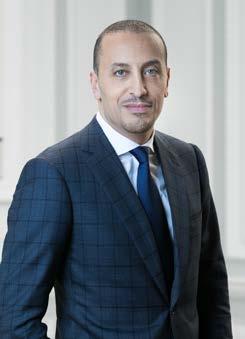
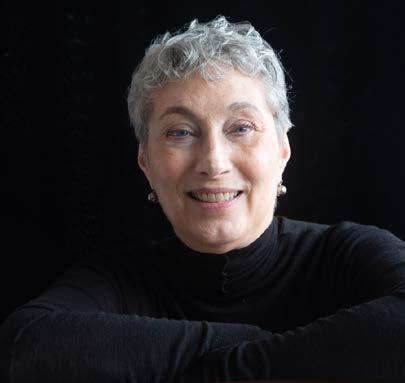


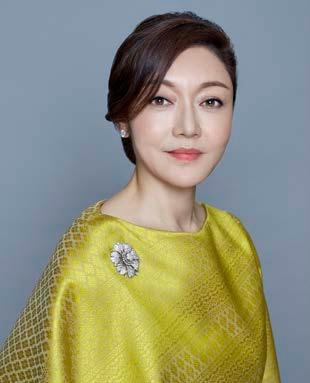
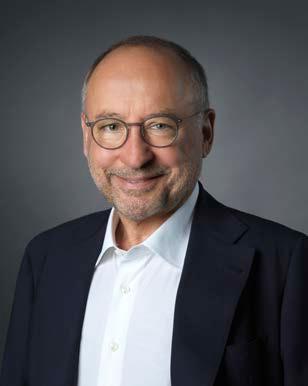
72 biennaleantiquariato The prize-winning collectors of Rinascimento+Prize: 1. Patrizia Sandretto Re Rebaudengo 2. Gianfranco D’Amato 3. Marisa Chearavanont 4. laura Mattioli 5. Fabrizio Moretti 6. Hussam Otaibi Next page: sketches of the award created by Emiliano Maggi for the Prize 2.1. 5. 6.6. 4.3.
and direct; both belong to the same British school. The connection is strengthened by the fact that the Cragg exhibition, at the Museo Novecento until 15 January 2023, is based on the sculptor’s drawings, thus underlining the exploration of graphic art that began with Moore. As Michelangelo taught us, drawing is the mother of all art forms Is the Cragg exhibition wholly at the Leopoldine?
One large sculpture will be located at the Istituto degli Innocenti in dialogue with Brunelleschi’s Cortile degli Uomini The others are sited at the Museo Novecento, where we have not only drawings but also sculptures, and in one room we recreate Cragg’s studio, to illustrate his creative process. This is an artist who, in the footsteps of Moore and also Leonardo da Vinci, constantly takes inspiration from, relates and compares the creative processes of nature, at both micro and macro level. A kind of positive, generous competition that leads him to address variation in the materials of nature itself, to which he adds
instance, his shift from bronze to stone and then to the new resins. Let’s talk about art collecting
With the RINASCIMENTO+ prize, the city of the Medici renews its passion for the collection of contemporary art, formalised in this pres tigious international award to leading patrons of our age. The prize is also linked to the history of the Museo Novecento, which originated with the bequest of an illustrious collector, Alberto della Ragione . I like to recall a quote of his that sounds like a strong declaration of intent: his “desire not to move blindly among the art of our own time, but to give the living artist the legitimate comfort of timely comprehension”. This year, the winning collectors and art patrons of this third edition of the award will receive a special prize, conceived by the artist Emi liano Maggi (Rome , 1977), who has created six one-off sculptures. Also related to collecting is the exhibition Passione Novecento. From Paul Klee to Damien Hirst, at Palazzo Medici Riccardi until 8 January 2023.
You work tirelessly for the city and in the city
Florence and get to know its art: I owe the city a debt of gratitude. But it’s only through the contemporary gaze that this legacy lives on and is renewed.
15 gennaio, sia basata sul disegno dello scultore, proprio a sottolineare

madre di tutte le arti, come ci insegnava Michelangelo. La mostra di Cragg di svolge tutta alle Leopoldine? Ci sarà una grande scultura all’Istituto degli Innocenti in dialogo con il Cortile degli Uomini disegnato da Brunelleschi. Il resto del percorso si snoda al Novecento, dove abbiamo non solo disegni ma anche sculture e dove in una sala rimettiamo in scena lo studio dell’artista, in modo da far vedere il processo creativo di Cragg. Un artista che, sulla scia di Moore ma anche Leonardo da Vinci, continuamente si ispira, rapporta e confronta con i processi creativi della Natura, a livello micro e macroscopico. Una sorta di competizione positiva e generosa che lo porta a confrontarsi con le variazioni della materia proprie della Natura stessa, a cui lui
Passando, ad esempio, dal bronzo ai materiali lapidei e alle nuove resine. Arriviamo al Collezionismo … Con il premio RINASCIMENTO+, nella città dei Medici, si rinnova la passione per il collezionismo di arte contemporanea, sancito da questo prestigioso riconoscimento internazionale conferito a grandi mecenati del nostro tempo. Un premio che si ricollega anche alla storia del Museo Novecento, che ha avuto origine grazie al lascito di un collezionista illuminato, Alberto Della Ragione, di cui mi piace ricordare un pensiero che risuona come una forte dichiarazione di intenti e racconta il suo “desiderio di non passare ad occhi chiusi tra l’arte del proprio tempo, ma di dare all’opera dell’artista vivente il legittimo conforto di una tempestiva comprensione”. Quest’anno, ai collezionisti e mecenati vincitori della terza edizione del premio verrà consegnato un premio speciale, ideato dall’artista Emiliano Maggi (Roma, 1977), che ha realizzato sei sculture, esemplari unici. Sempre in ambito di collezionismo si inserisce la mostra Passione Novecento. Da Paul Klee a Damien Hirst gennaio 2023 sarà ospitata a Palazzo Medici Riccardi. Il suo è un lavoro instancabile per la città e nella città… Da ragazzino la prima cosa che ho fatto appena ho avuto un motorino è venire a Firenze, a conoscere la sua arte: ho un debito di gratitudine verso questa città. Ma è solo attraverso lo sguardo contemporaneo che questa eredità vive e si rigenera.
biennaleantiquariato 73
aaa
ART DIALOGUES
text VIRGINIA MAMMOLI
Arturo Galansino, Director Gener al of Fondazione Palazzo Strozzi since 2015. His prestigious career includes museums such as Paris’s Louvre, London’s National Gallery and Royal Academy. Then he decid ed to come back to Italy, to Florence, where he held some of Italy’s most successful exhibitions, both contemporary and traditional art. We talk about a few of them following the opening of the new exhibition Olafur Eliasson: Nel tuo tempo, at Palazzo Strozzi until January 22, 2023. What is your guiding principle when deciding upon Palazzo Strozzi’s exhibitions?
Palazzo Strozzi’s mission is to bring to Florence unique events of international standing, exhibitions never held before and which probably had no chance of ever being held. Whether modern and contemporary, classical and renaissance art. As for contemporary art, we invite the greatest living art ists to show their entire or most part of their art work, but also to establish a dialogue with the city and its past. Exhibitions which introduce the public to contemporary art through wide-ranging retro spective never seen before in Italy, although we con tinue to work on classical and Renaissance art too.
inaugurated the Foundation’s new course under your direction. How was it welcomed? We brought one of the greatest names of contem porary art to Florence, giving him the chance to work on the most challenging exhibition he has ever had anywhere. As a very politically committed art ist, he had the brilliant idea of using Palazzo Strozzi as a megaphone for his messages which, back then, focused on the immigration and humanitarian crisis
INTERNATIONALTOMISSIONSTROZZI’S‘PALAZZOISBRINGTOFLORENCEUNIQUEEVENTSOFSTANDING’
Arturo Galansino, dal 2015 direttore generale della Fondazione Palazzo Strozzi. Nella sua importante carriera troviamo musei come il Louvre di Parigi, la National Gallery e la Royal Academy di Londra. Poi la decisione di ritornare in patria per il suo in sediamento a Firenze, dove ha portato alcune delle mostre di maggior successo in Italia, tra contempo raneo e antico. Ne ripercorriamo alcune all’indoma ni dell’inaugurazione della nuova esposizione Olafur Eliasson: Nel tuo temp gennaio 2023.

Come sceglie le mostre per Palazzo Strozzi?
La missione di Palazzo Strozzi è portare a Firen ze eventi unici e irripetibili di valore internazionale, mostre mai state fatte prima e che probabilmente non lo saranno mai. Sia riguardo l’arte moderna e contemporanea, ma anche antica e rinascimentale. Sul versante del contemporaneo invitiamo i più grandi artisti viventi non solo a presentare tutta o gran parte della loro carriera, ma anche a creare un vero dialogo con la città e il suo passato. Mostre, dunque, che educano al contemporaneo attraverso retrospettive di ampio respiro mai viste prima in Italia, pur continuando a lavorare sul Rinascimento e l’arte antica.
Cominciamo con Ai Weiwei, il nome con cui ha uf zione sotto la sua direzione. Com’è stata accolta? Abbiamo portato uno dei più importanti nomi del contemporaneo a Firenze dandogli la possibilità di lavorare alla più grande mostra che avesse mai rea lizzato. In quanto artista molto polito e impegnato, fu sua l’intuizione geniale di usare Palazzo Strozzi come un megafono per i suoi messaggi, che in quel momento erano incentrati sui temi dell’immigrazio ne e della crisi umanitaria. È stato il nostro primo exploit nel contemporaneo ed è stata la mostra di
Arturo Galansino and some of his most popular exhibitions at Palazzo Strozzi Arturo Galansino e alcune delle sue mostre più di successo a Palazzo Strozzi
Arturo Galansino (ph. Alessandro Moggi)
74 biennaleantiquariato
 Let’s get digital (ph. Ela Bialkowska OKNO studio)
Let’s get digital (ph. Ela Bialkowska OKNO studio)

and the most-visited contemporary art exhibition of all times in Italy back then. It was an explosive moment not only for Palazzo Strozzi, but also for the whole of Florence, which demonstrated that the city was able to speak of the “present” as well. Palazzo Strozzi enjoyed a special Renaissance: the electronic Renaissance of Bill Viola, the undisputed
he lived in Florence. It was an important exhibition, which highlighted the modernity of the past and the classicism of the present. A real philological dialogue.
a female artist, and not just any artist: Marina
I believe it is still, to this day, the most-visited con temporary art exhibition in Italy, owing to which Palazzo Strozzi was transformed into a living theater of performance. The talk show at Maggio Musical Fiorentino, a theater with a seating capacity of 2,000,
able to get everyone involved in her meditations, by creating a very moving moment of concentration.
exhibition?
The one that Tomás specially made for Palazzo Strozzi’s courtyard, which hopes for a new era for humanity allowing people to travel without using fossil fuels. It was 2020, the pandemic hit shortly after the opening of the exhibition. What we decid ed to do was to keep the courtyard open to allow Tomás’s work to be seen as a symbol of hope for a better future at a time when Florence was com pletely deserted because of the lockdown, Shine exhibition
PHILOLOGICALEXHIBITIONVIOLA’SWASTHEEXAMPLEOFAREALDIALOGUE’
allora, in Italia. Fu un momento detonante non sol tanto per Palazzo Strozzi, ma per tutta Firenze, che dimostrò di poter parlare anche del presente.
tutto particolare: quello elettronico di Bill Viola,
i suoi video con le opere che lo avevano ispirato cinquant’anni prima, quando viveva a Firenze. È stata una mostra molto importante, che ha messo in luce l’attualità del passato e la classicità del presente. Un
un’artista donna, e certo non una qualunque: Ma
Credo sia tuttora la mostra d’arte contempora nea più visitata in Italia, che ha visto Palazzo Strozzi trasformarsi in teatro vivente di performance art. Toccante fu sicuramente il talk al Maggio Musicale Fiorentino, un teatro con circa 2000 posti. Vendem mo i biglietti in un paio di ore e Marina riuscì a coinvolgere tutti nelle sue meditazioni, creando un momento di raccoglimento molto commuovente.

Quella che Tomás creò appositamente per il cor tile di Palazzo Strozzi, che auspicava una nuova era per l’umanità dove fosse possibile viaggiare senza combustibili fossili. Era il 2020, poco dopo l’inau gurazione ci fu l’arrivo della pandemia. Quello che decidemmo di fare fu lasciare aperto il cortile, in modo che nel deserto della Firenze del lockdown l’opera di Tomás potesse essere un simbolo di spe ranza per un futuro migliore.
Shine insieme a Jeff Koons?
Con Jeff si è creato un grande rapporto. Ama Firen

‘BILL
Olafur Eliasson, Firefly double-polyhedron sphere experiment (ph. Jens Ziehe)
Ai Weiwei (courtesy Ai Weiwei Studio)
biennaleantiquariato 77
Jeff and I established a great relationship. He loves Florence and Palazzo Strozzi. His exhibition was the
person and there was nothing better than his mir rored works which interact with viewers. Among all these contemporary geniuses, two ex
How did you manage the return to the past? As I said, our contemporary exhibitions are often speaking, I have never abandoned traditional art, city such as Florence, the Verrocchio and Donatello exhibitions had to be unprecedented in order to make an impact. And so it was. They changed the
WITHWORKS,MIRRORED‘KOONS’SWHICHINTERACTVIEWERS,WEREPERFECTFORTHERETURNTONORMALITY’


It is a technological revolution that is changing our world. I believe that the themes of works associat ed with blockchain documents and the relationship between the digital and physical worlds are going to be increasingly present in our lives, not only in the art world. Of course, all trends are short-lived, and we have already seen a fall in the value of NFT works, but this does not stop research.
art continues with How did this exhibition come to life? time and was struck by the Renaissance architec ture, thus, starting a long conversation between exhibition is the synthesis of this complex dialogue.
ze e Palazzo Strozzi. La sua è stata la grande mostra della ripartenza. Le persone avevano voglia di tor nare a godere di persona dell’arte e niente poteva essere più adatto delle sue opere specchianti che si attivano in presenza del visitatore.
riuscito a bilanciare questo ritorno al passato? Come detto le nostre mostre contemporanee dia logano spesso con il passato, ma in generale non abbiamo mai rinunciato all’arte antica, che rimane un’importante parte della nostra produzione. La vorando in una città come Firenze, perché fossero d’impatto, le mostre sul Verrocchio e Donatello do vevano necessariamente essere inedite. E così è sta to. Hanno cambiato il modo di vedere tutto il ‘400.
te perplessità e anche polemiche. Qual è la sua Si tratta di rivoluzione tecnologica che sta cambian do il nostro mondo. Credo che i temi delle opere legate a documenti blockchain e del rapporto tra
ti aspetti delle nostre vite, non soltanto nel mondo dell’arte. Poi certo, tutte le mode passano, e già si è visto un crollo di valore delle opere NFT, ma que
La serie di esposizioni dei maggiori protagonisti dell’arte del presente continua con Olafur Elias
. Come è nata questa mostra?
Nel 2015 Olafur visitò per la prima volta gli spazi di Palazzo Strozzi e rimase colpito dalla architet tura rinascimentale, cominciando così una lunga conversazione tra lui e il palazzo quattrocentesco. La mostra odierna è la sintesi di questo complesso dialogo.
alongside Jeff Koons?
Jeff Koons. Shine (ph. Tom Powel Imaging)
Marina (courtesyAbramovicMarinaAbramovic Archives)
78 biennaleantiquariato
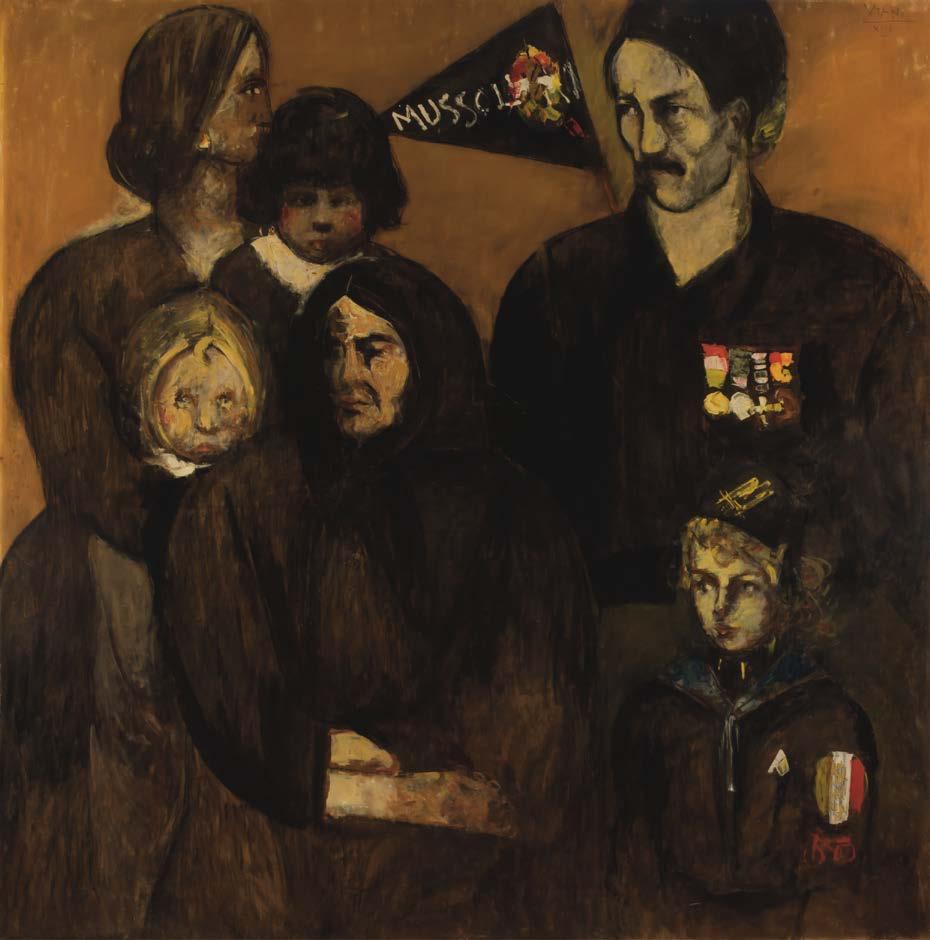



TREASURESNEWThelatestmajoracquisitionsbytheUffiziGalleryLeultimeimportantiacquisizionidelleGalleriedegliUffizitextFRANCESCALOMBARDI

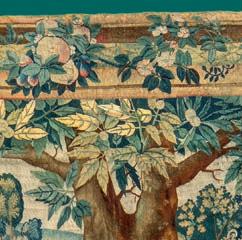
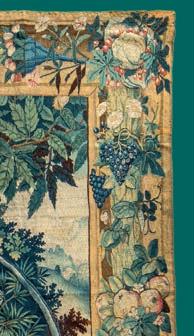



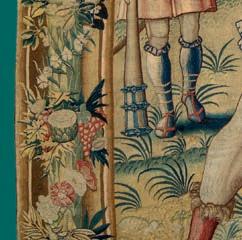

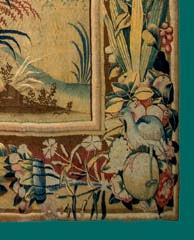
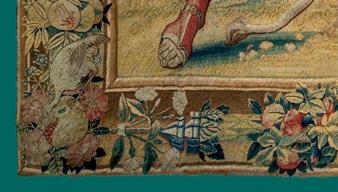
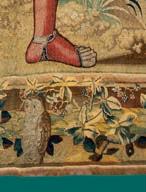
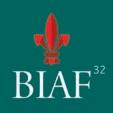
Via Manzoni, 12, Milano, It aly T / F +39 0276008959 info@mircocatt ai.com www.mircocatt ai.com ERCOLE E GLI UCCELLI DEL L AGO STINFALO ARAZZO, CM 336 X 257 OLE MIRCO C ATTAI STAND 31
Acquisitions that feel they belong, as great art works return after many years forgotten, to take their places in one of the world’s top mu
created. These are really important purchases - made possible by the efforts of Gallery Direc tor Eike Schmidt, tireless in his search for masterpieces with links to Florence, and by generous donations from the Amici degli
the Renaissance has been a part of the Florentine DNA, more than anywhere else on earth, and which have been consider ably stepped up over the past year. We begin the long list of wonders in reverse, with the most recent donation, in July this year: a small jewel that was thought to be lost, Ascension of Christ by the Floren tine Mannerist painter Tommaso Manzuoli, known as Maso da San Friano, which resurfaced from a private collection in northern Italy and was bought by the work was a model for an altarpiece for the chapel of the Florentine church of Santa Maria del Carmine, which remained un altarpiece was completed by the young Giovanni Battista Naldini (Fiesole 1537 - 1591), but was lost in a for the model, made by Maso himself, are now preserved in the The perplexed expression, the tense neck, the untidy strands of hair framing a perfectly oval Greek face: these are the distinctive traits of the exquisite sculpture which since June has graced the The marble bust
opere, dopo anni di oblio, riprendono posto in uno dei musei rettore delle Gallerie Eike Schmidt, instancabile nella ricerca di luogo al mondo e che in questo ultimo anno hanno assunto un passo sempre più deciso.

datata lo scorso luglio: un piccolo gioiello ritenuto perduto, l’Ascensione di Cristo Tommaso Manzuoli detto Maso da San Friano, rie
corso di un’accesa asta. L’opera, modello per la pala d’altare destinata alla cappella
Carmine, rimase però incompiuta a causa della morte prematura di Maso. A com pletarla fu il più giovane Giovanni Battista Naldini (Fiesole 1537 - 1591), ma andò di strutta in un incendio che devastò la chiesa nel 1771. I disegni preparatori per il mo
L’espressione accigliata, il collo teso, le ciocche dei capelli scom poste, ad incorniciare un perfetto ovale alla greca: sono i tratti
busto in marmo risalente alla seconda metà del I sec. a.C e
GREAT ARTWORKS TO TAKE THEIR PLACES IN ONE OF THE WORLD’S TOP MUSEUMSTHE UFFIZIIN THE CITY WHERE THEY WERE CREATED
Donato Mascagni, Il Conte Ugolino
biennaleantiquariato 83
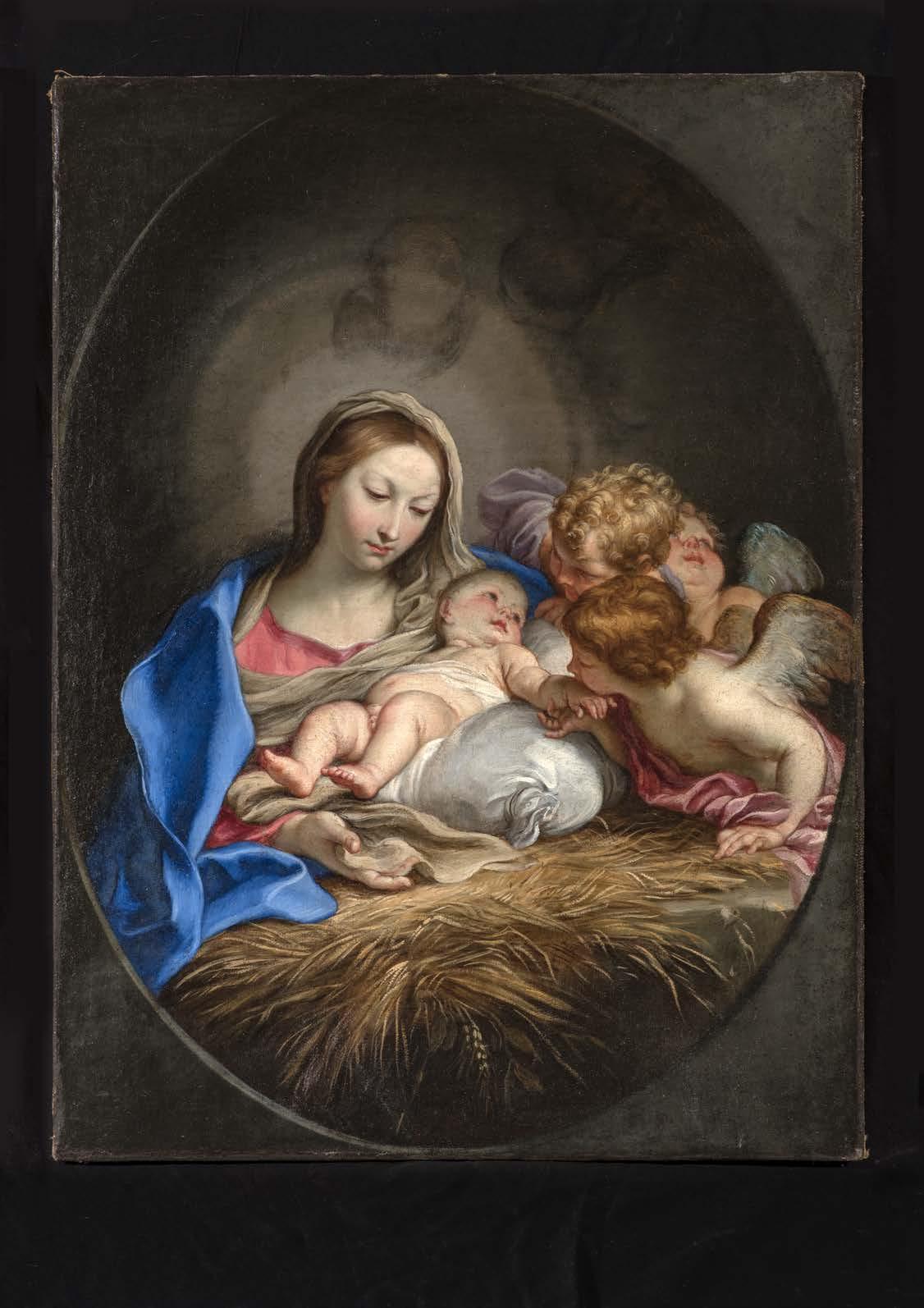
 Carlo
Carlo
STAND 14 alessandra dic astro.c om
Maratti (Camerano, 1625 Roma, 1713) Madonna con il Bambino e tre angeli Olio su tela 67,5 x 50,5 BIAFRoma,1658cm
dates back to the second half of the 1st century BC and the dynamic and powerful set of the head and the aesthetic sensibility in the light and shade of the surfaces accentuate the expressiveness of the face: all are inspired by the portraits of the Hellenistic dynasties in Ancient Egypt and Syria. May saw the arrival of a rare marble piece by the 19th-century Tuscan sculptor Giacomo Giovanni Papini. It is known as Bust of a Gentlewoman, and is signed and dated G G Papini 1875 Acquired by the Italian government for the permanent collection at the Gallery of collection was enriched by remarkable 17th-century painting, King Solomon Offering Incense to an Idol by the Florentine artist Bartolomeo Salvestrini. The painting was gifted to the museum by is dedicated to the memory of Daniela Salvadori Guidi Bruscoli, marking the 80th anniversary of her death.The subject is the Bible story in which the ageing Solomon surrounds himself with a great many foreign wives, for whom he builds temples
bra che accentuano la mimica del volto: sono tutti elementi ispi rati ai ritratti dei dinasti ellenistici dell’Egitto e della Siria.
re ottocentesco toscano Giacomo Giovanni Papini. Si tratta del Busto di Gentildonna, G G Papini 1875. La
THE PRACTICE OF ARTS
RENAISSANCETHATPATRONAGESINCETHEHASBEENAPARTOFTHEFLORENTINEDNA,MORETHANANYWHEREELSEONEARTH
the resulting estrangement from the Lord, brings harsh divine punishment upon Solomon: his kingdom is split into two parts. This explains the inscription on the canvas: “Mulieres apostatare faciunt sapientes” (“Women lead even wise men to deviate from the path”); it is signed and dated 1626 by the painter himself.
German-Jewish painter Rudolf Levy, painted the portrait of a young woman, Fiamma: painted in Florence and purchased by

È arrivato in primavera n
dipinto del Seicento: Salomone incensa gli idoli Bar tolomeo Salvestrini. L’opera, donata al scoli, è dedicata alla memoria di Daniela Salvadori Guidi Bruscoli, in occasione degli ottanta anni dalla sua nascita. Il soggetto è l’episodio biblico in cui si narra come Salomone da vecchio si circondò di uno stuolo di mogli straniere, per le quali co
idolatria, e il conseguente allontanamento dal Signore, portarono a Salomone una del suo regno in due parti. Così si spiega ti”),tes”
siglata e datata 1626 dal pittore stesso. Rudolf Levy, grande pittore ebreo tedesco del Novecento, ap Fiamma: acquistata dal museo, mostra sull’artista in programma per il 2023.
biennaleantiquariato 85
 From left Leonello Spada and Rudolf Levy
From left Leonello Spada and Rudolf Levy
in an exhibition of Levy’s work scheduled for 2023.
from the American , the transatlantic Coinciding the 700th anniversary of the death of Dante Alighieri is the arrival of Count Ugolino, painted by Fra’ Arsenio Mascagni in the early 17th century. The canvas is linked with one of the most famous episodes of the Divine Comedy, described in Canto 33 of the Inferno.The protagonist is Count Ugolino Della Gherardesca, found guilty of betraying his country. The other donated works are The Liberation of Saint Peter from Prison, painted in 1621 by Leonello Spada, accompanied by an angel who appears to radiate light, and Sicilian Countryside on a Rainy Day by Francesco Lojacono.
Last September saw a last-minute rescue: a large canvas depicting Saint Paul, painted from a cartoon by one of the 16th century’s most talented and versatile artists, Pellegrino Tibaldi, was about to leave Italy; today it is part of the collection
Lastly only in terms of time: to mark American Independence painting long believed lost in the United States. The Witch of Endor evokes the ghost of Samuel before Saul was painted in 1841 by the Romantic artist Giuseppe Sabatelli, who was born in Milan but moved to Florence at a very young age, teaching painting technique at the Florence Academy of Fine Arts from 1839.
, il ramo oltreoceano degli
Il Conte Ugolino opera di
degli episodi più celebri della Divina Commedia, descritto nel XXXIII canto dell’Inferno. Ne è protagonista il conte Ugolino Della Gherardesca, colpevole di tradimento della patria. Fan San Pietro liberato dal carcere, opera del 1620 di Le onello Spada, accompagnatodovedaun angelo che sembra emanare luce, e l’ottocentesco Campagna siciliana in un giorno di pioggia di France sco Lojacono.
“Le tre opere colmano lacune nelle col RisaleSchimdt.a settembre scorso un salvataggio rante San Paolo Pellegrino Tibaldi, uno dei maggiori e più versatili artisti del Cinquecento, stava per
Ultimo solo in ordine di tempo: in occa
tocentesco ritenuto perduto da molto tempo negli Stati Uniti. Si tratta de La maga di Endor evoca davanti a Saul lo spettro di Giuseppe Sabatelli, Dal 1839 Giuseppe Sabatelli insegna tecnica pittorica all’Acca
 Sicilian Countryside on a Rainy Day by Francesco Lojacono
Sicilian Countryside on a Rainy Day by Francesco Lojacono
“THE WORKS FILL GAPS IN THE COLLECTIONS”,MUSEUM’SDIRECTORSCHIMDTCONFIRMS
86 biennaleantiquariato


FRASCIONEENRICO Firenze-61/rFossideiVia4077705335+39.Cellenricofrascioneantiquario@gmail.com ANTIQUARIO Filippo Omegna -Voluttà olio su tela 167 x 95,5 cm. Firmato in basso a destra

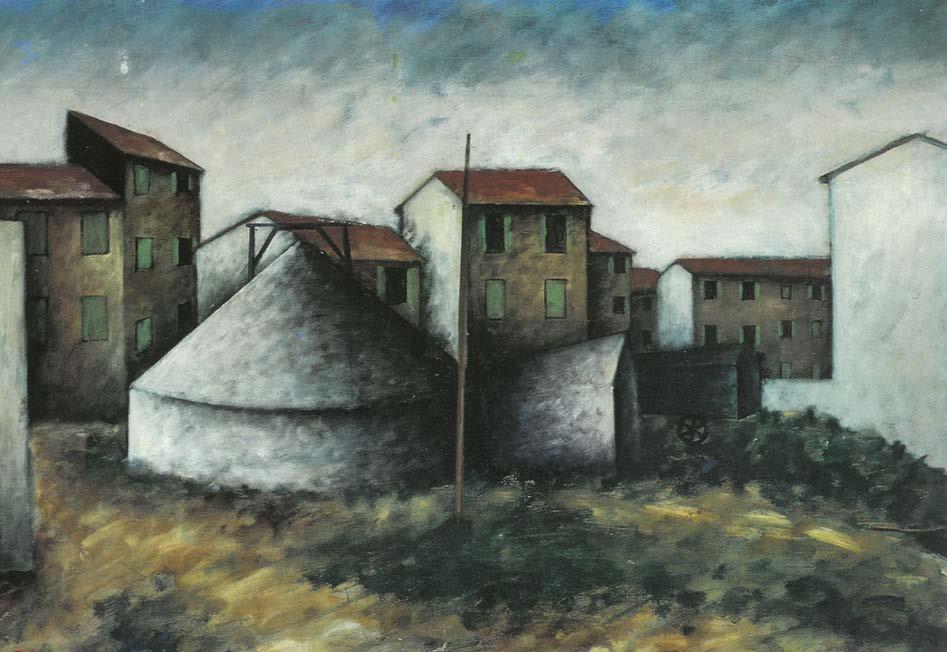
 From above clockwise: Cecily Brown, Couple, 2004; Ai Weiwei, Girolamo Savonarola, 2016; Ottone Rosai, Circo, 1933. These works are on display at Palazzo Medici Riccardi, Passione Novecento. Da Paul Klee a Damien Hirst until 8 Januar
From above clockwise: Cecily Brown, Couple, 2004; Ai Weiwei, Girolamo Savonarola, 2016; Ottone Rosai, Circo, 1933. These works are on display at Palazzo Medici Riccardi, Passione Novecento. Da Paul Klee a Damien Hirst until 8 Januar
FIL ROUGE
The new 20th century exhibition at Palazzo Medici Riccardi to learn about contemporary collecting La nuova mostra sul Novecento a Palazzo Medici Riccardi per conoscere il collezionismo contemporaneo
text ROSSELLA
WBATTISTA
hat would the world be without museums? And would Florence, a proud city that glories in its art and its history, still have been the cradle of the Renaissance if families like the Medicis, the Strozzis and the Rucellais
in established artists and emerging youngsters alike, nurturing their ambition? If that yearning for possession, that desire to showcase beautiful things, had not encountered the competitive spirit of rivals and allies vying for commissions, the history of Florence would probably have been very different. Because collecting art was one of the drivers that enabled the city to anticipate the future by becoming a part of it.
A system of art patronage which has never faded, according to Sergio Risaliti, director of the Museo Novecento and curator of the major exhibition at Palazzo Medici Riccardi, Passione Novecento.
From Paul Klee to Damien Hirst (until 8 January 2023). “There’s a ”, Risaliti explains, “which links ancient and modern art, the collectors of the past and those of today. The important thing is to ensure continuity, and fortunately private individuals have continued and will continue to acquire art. This didn’t end in the 19th century; they subsequently collected contemporary pieces, and avant-garde art in particular”. The exhibition contains some 40 works by universally renowned artists including and and, more controversially, a piece by Damien Hirst, who found fame in the 1990s (and was strongly criticised by animal rights groups) for preserving a shark in formaldehyde, having and The former draws extensively on medieval art, only to distort it in the style of and suffuse it with colour like Klee. And the latter portrays the banality of the everyday, such as an unmade bed or a tent embroidered with the names of everyone the artist shared her bed with upon. Similarly, she uses every means at her disposal to comment on human
CONTEMPORARYCOLLECTINGPHENOMENONTHEOFPRIVATEINARTTOLDINANEXHIBITION
della sua arte e della sua storia, sarebbe stata ugualmente culla del Rinasci mento senza che casate del calibro dei Medici, degli Strozzi o dei Rucellai non avessero collezionato antiche rarità, scommesso su giovani emergenti e artisti di provato successo, alimentandone l’ambizione? Se quella bramosia di possesso, quella necessità di sfoggiare il bello non avesse incontrato lo spirito competitivo di alleati e rivali, che parteciparono a quella gara di committen ze, la storia di questa città probabilmente avrebbe seguito un percorso ben diverso. Perché è stato anche il collezionismo il motore che ha permesso a Firenze di anticipare il futuro diventandone protagonista. Un mecenatismo che per Sergio Risaliti, direttore del Museo No vecento e curatore della grande mostra a Palazzo Medici Riccardi, Passione Novecento. Da Paul Klee a Damien Hirst 8 gennaio 2023) non si è mai esaurito. “C’è un spiega Risaliti - che lega l’arte antica a quella moderna, i collezionisti di allora con quelli di oggi. La cosa importante è dare continuità e per fortuna i privati hanno continuato e continuano a raccogliere. Non si sono fermati a Ottocento, sono andati avanti collezionando arte contemporanea e in particolare arte all’avanguar dia”. In mostra, infatti, ci saranno circa 40 opere, dagli universalmente celebrati
ai più controversi come un Damien Hirst divenuto celebre negli anni ‘90 (ma anche for temente criticato dagli animalisti) per aver messo sotto formaldeide uno squalo dopo averlo fatto
s e La prima che attinge a piene mani dal Medio Evo per distorcerlo alla maniera di immergerlo in un gioco di colori alla Klee. E la seconda, che rende la banalità del quotidiano, come un letto disfatto o una tenda con i nomi di quanti hanno dormito con lei, oggetti di uso quotidiano a cui non diamo peso e che lei ci costringe invece ad os
umana attraverso se stessa. Una mostra che dedica grande spazio alle donne
biennaleantiquariato 89
life through her own experience. There is plenty of space for women in the photography section too, which also features work by contemporary artists including , a key name in the winter season at Palazzo Strozzi Passione Novecento is therefore a rare opportunity to come into contact with what it is to collect art in the present day. Partly because, as one might imagine,
straight to the home of leading patrons of art. After all, without collectors there would be no great collections like those of or and the Museo del Novecento itself would not exist without the donation”. It is no accident that the exhibition focuses on modern and contemporary art, encompassing the entire 20th century and featu ring patrons of modern and contemporary art. Pe ople, as Risaliti points out, who are generally ahead of their time. “An art collector goes with what they love, choosing out of passion rather than calculation. They are more open and curious, and don’t wait for the historical perspective that’s brought by the critic
connection with the artist. There were many collec tors buying prior to its success”. Similarly, there have been art historians who, driven by curio sity, have succeeded in rediscovering and reevalua ting art that has been sidelined by time and fashion.
contemporanei, compreso protagonista della rassegna inverna le di Palazzo Strozzi per esempio. Passione Novecento si offre dunque come un’occasione rara per entrare in contatto con il collezionare contemporaneo. Anche perché, come è facile intuire, tutte o quasi le opere vengono esposte qui per la prima volta. Anima e specchio di gelosissimi collezionisti privati. Una passione intima che si dischiude a palazzo Medici. “Sede più appropriata non poteva esserci - conferma Risaliti - andiamo direttamente a casa dei grandi mecenati. Del resto senza collezionismo non sarebbero nate le grandi raccolte come quelle dello , di Horne e lo stesso Museo del Novecento non esisterebbe senza la donazione ”.

FOCUS ON MODERN
MODERNGIVINGCONTEMPORARYANDART,COVERINGTHE20THCENTURYANDSPACETOPATRONS
“Like Mina de Gregori and Piero Bigongiari”, Risaliti century art before it was recognised by the market and by academia”. Patrons past and present who contributed and continue to contribute to making history, who nurture creativity and support experimenta tion. And it is no coincidence that Risaliti himself conceived RINASCIMENTO+ the international prize for collectors and art patrons, now in its third edition and geared to the Florentine and Tuscan collectors who stand out for their support for art and artists. An eagerly-awaited ceremony which once again will grace the gala evening in the Salone dei Cinquecento in Palazzo Vecchio, organised in collaboration with the BIAF - the Florence International Antiques Biennale.
E non è un caso che la mostra si focalizzi proprio sull’arte moderna e contemporanea, coprendo l’ar co del Novecento, dando spazio ai suoi mecenati moderni e contemporanei. Persone che, racconta Risaliti, il più delle volte anticipano i tempi. “Il colle zionista si rivolge a ciò che ama, acquista per pas sione più che per calcolo. E’ più aperto, curioso e non aspetta la storicizzazione che ne fanno il critico e lo storico dell’arte. E’ lui, prima di loro, a trovarsi in sintonia con l’artista. Quanti appassionati hanno collezionato prima che avesse succes
che, spinti dalla curiosità, sono riusciti a riscoprire e rivalutare un’arte che il tempo e le mode aveva no accantonato. “Come Mina de Gregori e Piero Bigongiari - ricorda Risaliti - che avevano intuito la portata dell’arte del Seicento prima che fosse ri conosciuta dal mercato e dal mondo accademico”. Mecenati di ieri e di oggi che hanno contribuito e contribuiscono a creare la storia, che alimentano la creatività e sostengono la sperimentazione. E non è un caso infatti che proprio Risaliti abbia ideato il RINASCIMENTO+, il riconoscimento internazionale al collezionismo e mece natismo giunto ora alla sua terza edizione, e rivolto proprio a quei collezionisti che si sono distinti per il loro sostegno all’arte e agli artisti. Una cerimonia at tesa e che coronerà, anche stavolta, la serata di gala in Salone dei Cinquecento, Palazzo Vecchio realizzata in collaborazione con la BIAF - Biennale Internazio nale dell’Antiquariato di Firenze.
Palazzo Medici Riccardi
90 biennaleantiquariato



BIAF nel futuro grazie a EY, Innovation Partner di questa 32° edizione BIAF
text FRANCESCA LOMBARDI
The extension of the Biennale to encompass con temporary art has become a genuine strength of the event, whose recent history boasts wor ks by the likes of Henry Moore, Jeff Koons and Urs Fisher. It leads to increasingly intense crossfertilisation between past and future, in which EY, a world leader in professional services with particular experti se in digital transformation, uses technology to turn this year’s BIAF into a bridge between the classical art of the past and the new art of the future.The EY area at the Biennale creates a museum within the me taverse, in which paintings and artworks that have won prizes in previous editions of BIAF are displayed, offering an immer sive experience, albeit remotely, to all art lovers. The metaverse exhibition is packed with interactive digital activities and makes it possible to use neuroesthetic techniques to measure the emotional reactions arou sed when viewing art. As a record of their experience, visitors can also obtain a NFT (Non-Fungible Token).Alongside the me taverse, NFTs play a crucial role in the art world, allowing users to ascertain the uni queness, non-replicability and authenticity of digital artworks, or even authorised and authenticated copies. Indeed, the metaver se and NFTs constitute an innovative new ecosystem for the creation, enjoyment and trading of digital art.In order to further explore the role of technology in the art world, at 4 pm on 29 September EY will host a Biennale panel on the subject, as part of its programme to improve the accessibility of art. Within this undertaking, technology is a fundamental means to support the transformation of art to the digital realm.
L’apertura della Biennale al linguaggio contemporaneo è diventato un vero e proprio punto di forza della manifestazione, che vanta nella sua storia recente artisti come Henry Moore, Jeff Koons e Urs Fisher… Contaminazioni tra passato e futuro sempre più profonde che EY, le ader mondiale nei servizi professionali con forte expertise nella tra sformazione digitale, ha trasformato per questa edizione di Biaf in un ponte tra l’arte classica proveniente dal passato e il futuro attraverso la tecnologia.
Il corner EY presente in Biennale è costituito da uno spazio museale all’interno del Metaverso dove sono esposti quadri e opere d’arte premiate nelle prece denti edizioni della BIAF consentendo a tutti gli appassionati di vivere, anche da remoto, un’e sperienza immersiva. La mostra nel Metaverso è arricchita da attività interattive digitali con la possibilità di misurare, grazie a strumenti di neuroestetica, le reazioni emotive che sorgono ammirando le opere d’arte. A testimonianza della partecipazione alla visita, i visitatori hanno anche l’opportunità di ottenere un NFT (NonFungible Token).
OPPORTUNITYTHIS WAS THE POINTSTARTINGINASHIFTTOWARDSTHEWORLDOFART
Assieme al metaverso, gli NFT hanno un ruo lo fondamentale nella dimensione artistica in quanto consentono di assicurare l’unicità, non replicabilità e autenticità dell’oggetto d’arte digitale o anche delle sue copie autorizzate e autenticate. Il Metaverso e gli NFT creano infatti un ecosistema innovativo e nuovo che consente la creazione, la fruizione e la transazione dell’arte digitale.
Per approfondire il ruolo delle tecnologie nel mondo dell’arte, il 29 set tembre a partire dalle ore 16.00 EY ospita in Biennale un panel dedicato al tema che s’inserisce nel percorso avviato da EY e di avvicinamento all’arte. In tale percorso, la tecnologia è un mezzo fondamentale per supportare il processo di trasformazione artistica in ottica digitale.
92 biennaleantiquariato THE THATMUSEUMWASN’TBIAFinthefuturethankstoEY,InnovationPartnerforthe32nd edition


Borges claimed that forgetting is necessary so that the mind can select memories.
And in some ways it is this very selection that guides Eternal Memories approach art and a key moment of Florentine history in an interactive, playful manner. Eter
nal Memories pays homage to the city and its inexhaustible artistic heritage.
ic centre of Florence accompany the player in a moving story that begins and ends at Palazzo Corsini, and recounts subsequent hopeful days when the city was saved by the “Mud Angels”.
It’s a story that conveys Florence’s in ternational atmosphere, the passion for art it arouses and the spirit of solidar ity that brought young people from all over the world to Florence to save its Theart. video game comes with period footage and original music, making it unique in the gaming world.
It is produced for BIAF by Golem Multi media, in collaboration with TuoMuseo and with funding from Consultinvest.
“Available in Italian and English, Eternal Memories can be downloaded free on all smartphones and tablets”, explains journalist David Parenzo, who has been involved in the proj ect from the outset.
“It constitutes a new narrative format which can reach an audience of more that two billion regular users, bringing young people in particular into the world of antique art”.
Borges sosteneva che è necessario l’oblio perché la memoria riesca a selezionare i ricordi.
La stessa selezione che in un certo senso opera Eternal Me mories, il primo storico importante per Firenze in maniera ludica e interattiva.
Eternal Memories è un omaggio alla città e al suo inesauribile patrimonio artistico.
Le splendide illustrazioni del centro storico di Firenze ac compagnano il giocatore in una storia
Corsini, attraversa i giorni drammatici dell’alluvione e quelli pieni di speranza in cui la città fu soccorsa dagli angeli del ternazionalefango.
di Firenze, la passione per l’arte che la città ispira e lo spirito di solidarietà che segnò quei giorni in cui giovani da tutto il mondo giunsero a Fi renze e ne salvarono l’arte.
ti dell’epoca e musiche originali che lo rendono un esempio unico nel panora ma mondiale dei videogiochi. Il gioco è prodotto per BIAF da Golem Multimedia, con la collaborazione di TuoMuseo e il sostegno di Consultinvest “Giocabile in italiano e in inglese, Eternal Memories può essere ga il giornalista David Parenzo che ha voluto e pensato il narrativa in grado di raggiungere una platea di oltre 2 miliardi di giocatori abituali, avvicinando in particolare i giovani all’uni verso dell’arte antica”.
94 biennaleantiquariato
A NEW INMEMORIESWHICHFORMATNARRATIVECANBRINGYOUNGPEOPLEINPARTICULARINTOTHEWORLDOFANTIQUEARTTHEFUTUREEternalMemories,thedocu-gamecreatedforBIAFthatlaunchesanewwayoftellingstoriesEternalMemories,ildocu-gamepensatoperBIAFcheinauguraunnuovomododiraccontarestorietextFRANCESCALOMBARDI

 Some frames ftom Eternal Memories
Some frames ftom Eternal Memories

 Above: a picture of the setup Below: the monumental staircase completelyPalazzorestored,Corsini
SAVOIR TERESA FAVI
Above: a picture of the setup Below: the monumental staircase completelyPalazzorestored,Corsini
SAVOIR TERESA FAVI
Matteo Corvino, a renowned Venetian set and interior designer, but also an acclaimed organiser of memorable events around the world with a strong relationship with the Biennale Internazionale dell’Antiquariato of Florence. In 2013, he was a member of the Biennale’s hospitality committee and of a jury of experts appointed to select the most beautiful stand. In 2017, he was appointed to set up the event in collaboration with the seventeenth-century Palazzo Corsini, one of the most splendid private buildings in Florence, seat of the Biennale since 1997. A consistent project, designed to last for a long time,

old Florentine residence to better accommodate the stands of the exhibitors and the visitors’ itinerary.
Matteo Corvino, what were the main assets to your project?
When I was asked to think about a new project, I remembered something when I myself was a vis itor. That is, from the moment you came through the main door, the building almost completely disappeared from sight due to technical infra structural reasons. The same happened when you went onto the terrace, from where you could naturally see the roads alongside the River Arno, but the part in the courtyard, that is the wonderful view of the three seventeenth-centu ry facades, was hidden by the tensile structure.
thing that would bring out Palazzo Corsini. Then the desire to incorporate the layout into the structure of the building with out using too many materials and keeping the colour as neutral as possible. The real surprising thing is that when you go two thirds of the way, you reach the terrace and then you discover the Italian-style hanging garden
rather than a commercial one. What relationship did you establish with the sixteenth-century building
Matteo Corvino, veneziano, noto interior designer e scenografo, ma an che acclamato organizzatore di eventi memorabili in tutto il mondo, ha una lunga relazione con la Biennale Internazionale dell’Antiquariato di Firenze, di cui è stato membro del Comitato di accoglienza della Biennale e della Giuria di esperti incaricata, nel 2013, di selezionare lo stand più bello. Nel 2017 è stato incaricato di creare l’allestimento della manifesta zione in dialogo con il seicentesco Palazzo Corsini, uno tra i più sfarzosi palazzi privati di Firenze, sede della Biennale dal 1997. Un progetto con
stand degli espositori e il percorso dei visitatori. Matteo Corvino, quali sono stati gli asset del suo progetto?
Quando mi fu chiesto di ripensare in toto l’al lestimento per l’edizione 2017, che celebrava i 20 anni di permanenza della Biennale a Palazzo Corsini, mi venne in mente una cosa che avevo notato in precedenza da visitatore. E cioè, dal momento in cui si entrava dal portone princi pale, il palazzo spariva completamente per ra gionevoli motivi tecnici di infrastrutture. Que sto accadeva anche uscendo sulla terrazza, da dove si vedevano naturalmente i lungarni, ma la parte sul cortile, cioè la bellissima vista sulle tre facciate seicentesche spariva nella tenso struttura. Dunque, il primo pensiero fu quello di un intervento che svelasse Palazzo Corsini. Poi il desiderio di integrare l’allestimento nella struttura del palazzo senza soverchiarlo, con materiali e una cartella colori molto neutra. La vera sorpresa è quando, a due terzi del percorso, si arriva sulla terrazza e si scopre il giardino
luce, appare come il corso d’acqua di una fontana. Qui si percepisce l’atmosfera di un grande evento più che di una manifestazione com merciale.
Che rapporto ha instaurato con il palazzo di impianto cinquecentesco ma che mostra al suo interno una delle più affascinanti intuizioni del
Matteo Corvino
biennaleantiquariato 97
FAIRE An interview with Matteo Corvino, the influential designer of the Biennale dell’Antiquariato since 2017 Parla Matteo Corvino autorevole firma dell’allestimento della Biennale dell’Antiquariato dal 2017 text
which houses one of the most fascinating Baroque ideas of that period?
I did not go into rivalry nor was I too inspired by its architecture. Rather, I got back to basics, to its origin. What style did you choose for its layout?
The classic one is the most transversal style that exists in the history of architecture and in our case, it has also allowed a continuation with the previous structure.
Are there any updates planned for this new edition 2022?
After three years of stalemate since the last edition, we have decided to car ry out a minor intervention in the hanging garden as well as completing the
a sign that the project is working out very well and that the objectives have been instantly achieved. What emotions and sensations do you feel ev ery time you enter Palazzo Corsini?

I am fortunate to have known the Corsini fam ily for many years, and it is quite satisfying each
most important, wonderful and honest feeling is when I see the monumental staircase complete ly restored. I arrived, went into the entrance hall and greeted the guardian, who is now part of the splendour of this place. I then entered the court yard and when I turned the corner, not having remembered it had been restored and cleaned, I found the building ten times larger and brighter. and seeing the statues was a new feeling for me. And then there is the terrace overlooking the riv er arno, if you are lucky to see it at sunset... well, it’s a spectacular view, a real masterpiece.
Florence is full of surprises.
Florence is a city that also has a hidden side, especially if you walk through it early in the morning, preferably at dawn when the streets are still empty. Another thing that I love very much, which is similar to Venice, is that when you come out of the railway station, you are immediately overwhelmed and blown away by the beauty of its historic centre. In short, Florence is there and ready to welcome you with open arms.
Barocco dell’epoca?
tettura. Piuttosto sono tornato alla base, all’origine dell’oggetto. Che stile ha scelto per il suo layout? Il classico è quanto di più trasversale esista nella storia dell’architettura e nel nostro caso ha consentito anche una continuazione con l’assetto precedente.
Sono stati previsti aggiornamenti per questa nuova edizione 2022? Dopo tre anni di stallo dall’ultima edizione, si è deciso per un piccolo intervento nel giardino pensile oltre al completamento del percorso al piano terra con i grandi portali, segno che il progetto funziona molto bene e che gli obiettivi
Quali emozioni e sensazioni le trasmette ogni volta entrare a Palazzo Corsini?
tanti anni ed è molto appagante ogni volta var care la soglia della loro superba residenza. L’e mozione bella, vera e importante è stata, questa volta, vedere lo Scalone monumentale comple tamente restaurato. Sono arrivato, ho oltrepas sato la soglia, salutato il custode che ormai è parte lui stesso del fascino di questo luogo, sono entrato nel cortile e quando ho girato l’angolo, non ricordandomi che era stato restaurato e ripulito, l’ho trovato dieci volte più grande, lu minoso, leggere l’architettura, vedere le statue, quello è stato una nuova emozione. E poi c’è il terrazzo affacciato sull’arno, se uno ha la fortuna si arrivarci al tramonto… beh, è una visione mirabile, un capolavoro. La sua Firenze in una manciata di consigli.
mattina presto, meglio se all’alba quando le strade sono ancora vuote. Un altro aspetto che amo molto, e che l’accomuna a Venezia, è il fatto che quando esci dalla Stazione ferroviaria sei immediatamente assorbito e stordito dalla bellezza del suo centro storico. Insomma, Firenze è lì, pronta ad accoglierti a braccia aperte.
The hanging garden for BIAF at Palzzo Corsini
FOR THE 2022 EDITION WE HAVE DECIDED TO CARRY OUT A ININTERVENTIONMINORTHEHANGINGGARDEN
98 biennaleantiquariato
Lorenzo Lotto (Venezia 1480 – Loreto 1556/1557)
ECCE HOMO
Olio su tavola, cm 55,7 x 49
BIBLIOGRAFIA
E. Dal Pozzolo, Lorenzo Lotto. Catalogo generale dei dipinti, 2022, cat. n. I.104, pp. 332-333; R. Lorusso, in Restauri, 2019, pp. 159-161; A. Fiore, in Rinascimento visto da Sud, 2019, p. 186, p. 477;
B. Aikema, L’Ecce Homo di Lorenzo Lotto, in Artibus et Historiae, 34.2013, no. 68, pp. 29-37; P. Caretta, in Lorenzo Lotto. I volti e l’anima, 2013, pp. 70-74;
A. Donati, Lorenzo Lotto, Ecce Homo, in: Tiziano, Bordon e gli Acquaviva d’Aragona: pittori veneziani in Puglia e fuoriusciti napoletani in Francia, a cura di N. Barbone Pugliese, A. Donati, L. Puppi, catalogo della mostra, Bitonto, Galleria Nazionale della Puglia, 15 dicembre 2012 – 8 aprile 2013, Foggia 2012, cat. n. 8, pp. 258–263.
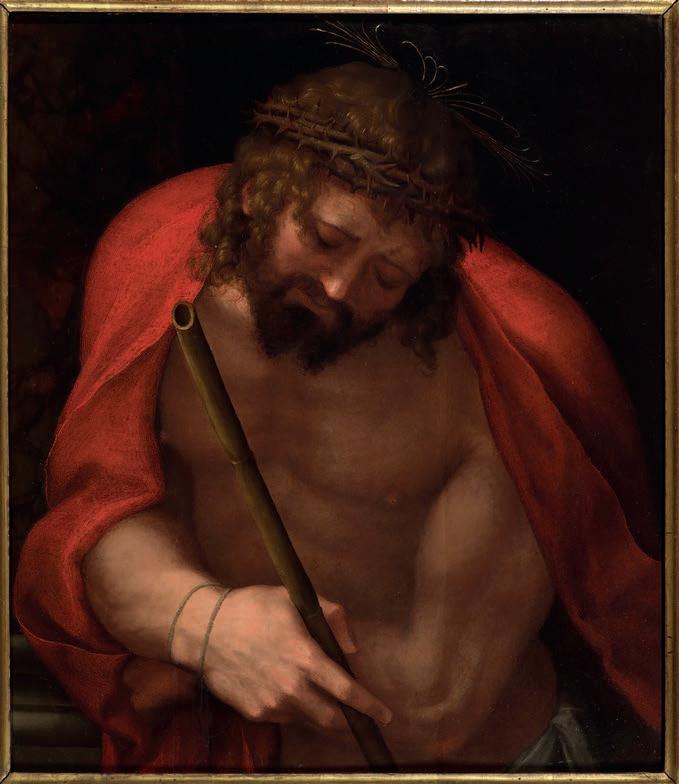
ESPOSIZIONI
Bitonto, Galleria Nazionale della Puglia, 15 dicembre 2012 – 8 aprile 2013, n. 8.
DYS 44 LAMPRONTI GALLERY LONDON
ART LOVER
Cristina Acidini, President of four invaluable Florentine institutions Cristina Acidini, Presidente di quattro preziose istituzioni fiorentine
 text VIRGINIA MAMMOLI
text VIRGINIA MAMMOLI
More than 30 years at the Minis try of Culture, formerly Super Pietre Dure and the State Art
Let’s begin with the Opera di Santa Croce: how do you carry on its role as a modern fabbriceria?
SAFEGUARDINGWHENARTISNOTJUSTAPASSION,BUTAREALVOCATION...
allora riuniti nel Polo Museale per un totale di 27 Cominciamo dall’Opera di Santa Croce: come porta avanti il suo ruolo di moderna fabbriceria?
Works not to be missed?
Opere da non perdere?
Legend of the True Cross
la Vera Croce
Un aneddoto curioso legato a Santa Croce?
Cristina Acidini
100 biennaleantiquariato
 Opera di Santa Croce (ph. Dario Garofalo)
Opera di Santa Croce (ph. Dario Garofalo)

Niccolò di Segna ABishopSainySiena,active1331 - 1345 Tempera on panel, 25,4 x 20 cm 13 Duke Street, st. james’s london sw1y enquiries@morettigallery.com6db WWW.MORETTIGALLERY.COM MORETTI
Enigma of an Autumn Afternoon.
The most captivating place in your Santa Croce?
tondi
That of the Arts of Drawing is the oldest Academy in the world. Maybe not everyone knows that?
EVERY ANSANTAANDCHAPELNAVE,CORNEROFTHECROCECOMPLEXISEXPRESSIONOFART
le, Enigma di un pomeriggio d’autunno Luogo più emozionante della sua Santa Croce?
Quella delle Arti del Disegno è la più antica Acca demia al mondo. Forse non tutti sanno che?
L’Accademia ospita anche mostre temporanee.
The Academy also hosts temporary exhibitions
L’opera per lei più affascinante di Casa Buonarroti moreo della Battaglia dei Centauri
The most fascinating work of Casa Buonarroti?

Brunelleschi’s Pazzi Chapel
 A curious anecdote about Santa Croce?
Academy of Arts of Drawing (ph. Elena Foresto)
A curious anecdote about Santa Croce?
Academy of Arts of Drawing (ph. Elena Foresto)
biennaleantiquariato 103
Can you give us a short tour inside the museum?
Battle Madonna of the Stairs

MICHELANGELOADOLESCENTTHEREALIZEDTHEBATTLEOFTHECENTAURSUNDERTHEKEENGAZEOFLORENZOTHEMAGNIFICENT
Un suo breve tour all’interno del museo?
Dopo la Sala dei Marmi, dove oltre alla Battaglia si Madonna della

Inclina tion
Can you also tell us about R. Longhi Foundation?
Boy Bitten by a Lizard,
Ci racconta anche dell’incredibile patrimonio del la Fondazione Roberto Longhi?
Ra gazzo morso dal ramarro
relief The Battle of the Centaurs
Casa Buonarroti (ph. Pasquale Paradiso)
Madonna of the Stairs, Michelangelo
104 biennaleantiquariato
InclinazioneScala

CARLO ORSI BiennaleFirenze 2022
Apupil of Mina Gregori who worked closely with Miklós Boskovits from 1983 to 1990, one of the leading experts on Italian painting and the author of numerous monographs, es says and articles. Following assistant director
(2009 to 2013), since May 2020 Angelo Tar tuferi has been director of the Museo di San Marco, and here he tells us about its wonders. How did your love of art come about? It had been there since high school, but the turning point was one afternoon - I had just started university and didn’t really know what I wanted to do - when I heard Mina Gregori take my degree with her.

co in Florence’s museum scene? It’s important in that it’s esteemed by a more educated audience, which Antonio Paolucci described explicitly as the “elite of Florentine tourism”. This place was loved by Cosimo de’ Medici the Elder and his family, and very dear to the Dominican order; over time it has been vonarola and Fra Bartolomeo. It’s a genuine
of manuscripts. The museum contains valuable testimonies of “old Florence” rescued from demolition in the 19th century. In many ways it’s a true museum of the city. gone major restoration. What’s the outcome,
ONE OF
Allievo di Mina Gregori, collaboratore diret to di Miklós Boskovits dal 1983 al 1990, tra i maggiori esperti di pittura italiana, e autore
Dopo esser stato vicedirettore della Galleria da maggio 2020 Angelo Tartuferi è il direttore del Museo di San Marco, di cui ci racconta tut ta la sua meraviglia. Come è nato il suo amore per l’arte? C’era sin dagli anni del liceo, ma la svolta è ca pitata un pomeriggio, quando - appena entrato all’università e con le idee ancora non del tut to chiare - ho ascoltato per la prima volta una sarei laureato con lei.
blico più preparato, che Antonio Paolucci de Vecchio de’ Medici e dalla sua famiglia; caro alle memorie dell’Ordine domenicano, abitato
Angelico, da Fra Girolamo Savonarola a Fra Bartolomeo. Autentica culla della cultura uma
ni ottocentesche. Si tratta per più versi di un autentico Museo della città.
ed importanti restauri. Quanti e come sono stati possibili?
106 biennaleantiquariato
BYSURROUNDEDOFANDONEXPERTSLEADINGTHEITALIANPAINTINGAUTHORNUMEROUSARTICLESANDSAYSBEAUTYAngeloTartuferi,directoroftheMuseodiSanMarcoAngeloTartuferi,direttoredelMuseodiSanMarcotextMARTINAOLIVIERIAngeloTartuferi
 Sala del Beato Angelico (ph. Antonio Quattrone)
Sala del Beato Angelico (ph. Antonio Quattrone)

and how was it possible?
The restorations carried out in direct connec tion with the refurbishment of the room af fect the Lamentation over the Dead Christ by the Company of St Mary of the Cross at the Temple, and a triptych painted by the Com pany of the Holy Cross, formerly in the main cloister of the Franciscan church of Santa Croce in Florence. Work is currently ongoing
directly linked to the refurbishment was the restoration of the Bosco ai Frati altarpiece, a remarkable achievement funded by the Friends of Florence.
What excites you most among the master
The fact that many of them are still in their original positions; consider the Fra Angelico

ter house, the celebrated series in the cells of the dormitory, or the surviving sections of the imposing San Marco altarpiece, painted by the master circa 1438-40 for the main altar of the church and today displayed in a dedicated room.
Let’s enter the museum together: what should we not miss?
no cloister and at the far end, you see the Fra Angelico fresco showing St Domenico at the to see everything by Fra Angelico! And, on the the only known three-dimensional image of

MASTERPIECESTHATEXCITINGMANYOFTHEMUSEUM’SARESTILLINTHEIRORIGINALPOSITIONS’
lestimento della sala sono stati quello del Com pianto sul Cristo morto dipinto per la Compagnia di Santa Maria della Croce al Tempio e quello del trittico eseguito per la Compagnia della Santa Croce che si trovava nel primo chiostro
del riallestimento è stato il restauro della Pala
Cosa la emoziona di più dei capolavori pre Il fatto che molti di essi sono tuttora nella loro del Beato Angelico - da quelli al piano terra,
capitolare al ciclo celeberrimo delle celle del Dormitorio - oppure le parti superstiti della grandiosa Pala di San Marco dipinta dal gran dissimo artista nel 1438-40 circa per l’altar maggiore della chiesa e oggi esposte nella sala a lui dedicata.
opere da non perdere?
Quando il visitatore appena entrato si trova nel chiostro di Sant’Antonino vede in fondo l’affresco dell’Angelico con san Domenico ai
Marco non si può perdere! E, al primo piano, dopo le celle affrescate, da non perdere l’unica immagine tridimensionale di Fra Girolamo Sa in terracotta dipinta, attribuito a Marco Della Robbia, accolto nel convento con il nome di Fra Mattia.

‘IT’S
Pala di Bosco ai Frati - Beato Angelico
Pala di San Marco - Beato Angelico
biennaleantiquariato 109
attributed to Marco Della Robbia, known in the monastery as Fra Mattia.
Is there a less famous work that’s really worth seeing?
The large canvas that we now know is by Piero del Pollaiolo - previously unfairly overshadowed by his more famous brother Antonio - depict ing St Antonino Pierozzi at the Foot of the Cruci and painted in 1483. The work was created for the tomb of the saint, much worshipped in Florence, in the church of San Marco, and was discovered in the monastery in 1907.
Do you think social media can be an effective way to get young people into art?
ity and duration of young people’s interest in art is a completely different matter. I’m well aware I’m expressing a minority opinion, but I much prefer quality over quantity.
Is there a project you’d like to develop in the future?
Having coordinated the refurbishment of the Fra Angelico Room, I’d like to do the same with the beautiful Refectory, which boasts a large fresco by Giovanni Antonio Sogliani painted in 1536 on the far wall, depicting the Miracle of the Dominicans Fed by the Angels, and an ex tensive collection of paintings by the so-called School of San Marco. I’d also like to organise an exhibition with a couple of colleagues, focusing on the fate of Fra Angelico in the 19th century and until the late 20th century.


Your Florence in a single image?
I can’t decide between the Baptistery and San Miniato al Monte… and I’m pretending I’ve forgotten about Santa Croce and Santa Maria Novella.
MUSEO DI SAN MARCO WAS LOVED BY ANDDE’COSIMOMEDICIVERYDEARTOTHEDOMINICANORDER
Pollaiolo - soprattutto in passato ingiustamen te oscurato dal più celebre fratello Antonio -, Sant’Antonino Pierozzi ai piedi del
riscoperta all’interno del convento nel 1907. Pensa che i social possano essere un modo
stri.È
Completamente diverso il discorso sulla qualità e sulla durata di tale avvicinamento dei giovani all’arte. So benissimo di esprime re un’opinione minoritaria, ma io preferisco di gran lunga la qualità alla quantità. Un progetto che le piacerebbe sviluppare in futuro?
Dopo aver coordinato il riallestimento della Sala del Beato Angelico vorrei riallestire an che la suggestiva Sala del Refettorio grande con il grande affresco di Giovanni Antonio Sogliani sulla parete di fondo dipinto nel Miracolo dei domenicani sfamati dagli angeli e con alle pareti un’im portante rassegna di dipinti appartenenti alla cosiddetta Scuola di San Marco. E poi mi una mostra dedicata alla fortuna del Beato Novecento. La sua Firenze in un’immagine. Non mi so decidere tra il Battistero e San Mi mi di Santa Croce e di Santa Maria Novella.
C’è un’opera meno conosciuta che vale as solutamente la pena vedere?
Beato Angelico at Museo di San Marco
Museo di San Marco
110 biennaleantiquariato


ERWIN WURM Trans Formam A cura di Helmut Friedel GALLERIAFIRENZEPOGGIALI Inaugurazione sabato 24 settembre 2022 ore 18 24.09.2022 / 18.03.2023 car)(FatConvertibleFat 133x240x430cmlacca,alluminio,difusione2022,, www,galleriapoggiali.com info@galleriapoggiali.com Galleria Poggiali è lieta di annunciare la sua partecipazione alla XXXII Biennale Internazionale dell’ Antiquariato di Firenze Claudio Parmiggiani Arnulf Rainer Palazzo Corsini, Lungarno Corsini 10, Firenze 24 settembre / 2 ottobre 2022
STILL IN TIME
Our interview with Tomaso Montanari, president of the Ginori Museum

La nostra intervista con Tomaso Montanari presidente del Museo Ginori
text TERESA
TFAVI
he Ginori Museum in Sesto Fiorentino is due to reopen in three years’ time. One of the world’s oldest industrial muse ums, it contains the most com prehensive collection of porce lain and tools, dating from the founding of the Manifattura di Doccia in 1737 to the present day. An industrial museum ante litteram and a museum of working life, as well as an extraor dinary depository for the city and the region. In the meantime, an inventory has been carried out of the more than 9.000 items in the collec tion, communication and the visual image have been revamped and the gardens reopened as a public space in advance of the museum as a common asset for the future. We discuss all this with the museum’s president Tomaso Mon tanari, as the BIAF (Florence Biennale of An tiques) makes a major donation to the museum. A museum preserved, with all its contents and history. The opening is planned for 2025; how do you envisage it?
As a public space, a cultural place open to all, where people can come and get involved in a cultural project. With staff on permanent con tracts. A museum about work and the local area; a lively, modern place, a crucial testament to the long story of a working community. While we’re waiting, what projects will keep us in touch with the Ginori Museum? We’ll be working through our digital channels with podcasts and videos. We’ll be promoting
Entro tre anni a Sesto Fiorentino po trebbe riaprire il Museo Ginori, uno dei più antichi musei industriali del mondo con la più completa raccolta delle por cellane e degli strumenti di lavorazione della Manifattura di Doccia dalla nascita,
di un museo d’impresa ante litteram ed anche un museo del lavoro, oltre che uno straordinario museo del territorio e della città. Nel frattempo, è stato completato l’inventario degli oltre 9mila pezzi della collezione, costruita l’immagine visuale, la comunicazione e riaperto il giardino, spazio pubblico che anticipa il futuro del museo pensato come bene comune.
Ne parliamo con il Presidente Tomaso Montanari in occasione di un’importan te donazione della Biaf ai capolavori del Museo.
Un museo in salvo con tutte le sue ope re e storie. Si parla di un’apertura nel 2025, lei come se lo immagina?
Come uno spazio pubblico, un luogo di cultura aperto a tutti dove si viene per partecipare a un progetto culturale. Con dipendenti assunti a tempo indetermina to. Un museo del lavoro e del territorio, un luogo vivo e moderno, testimone vi tale dell’epopea di una comunità di lavo ratori.
Quali progetti ci terranno legati al Mu seo Ginori nell’attesa?
Lavoreremo attraverso i canali digitali con podcast e video. Saremo promotori di
aaTomaso Montanari
112 biennaleantiquariato
ANANDWITHPRESERVED,INDUSTRIALMUSEUMALLITSCONTENTSHISTORY.THEOPENINGISPLANNEDFOR2025
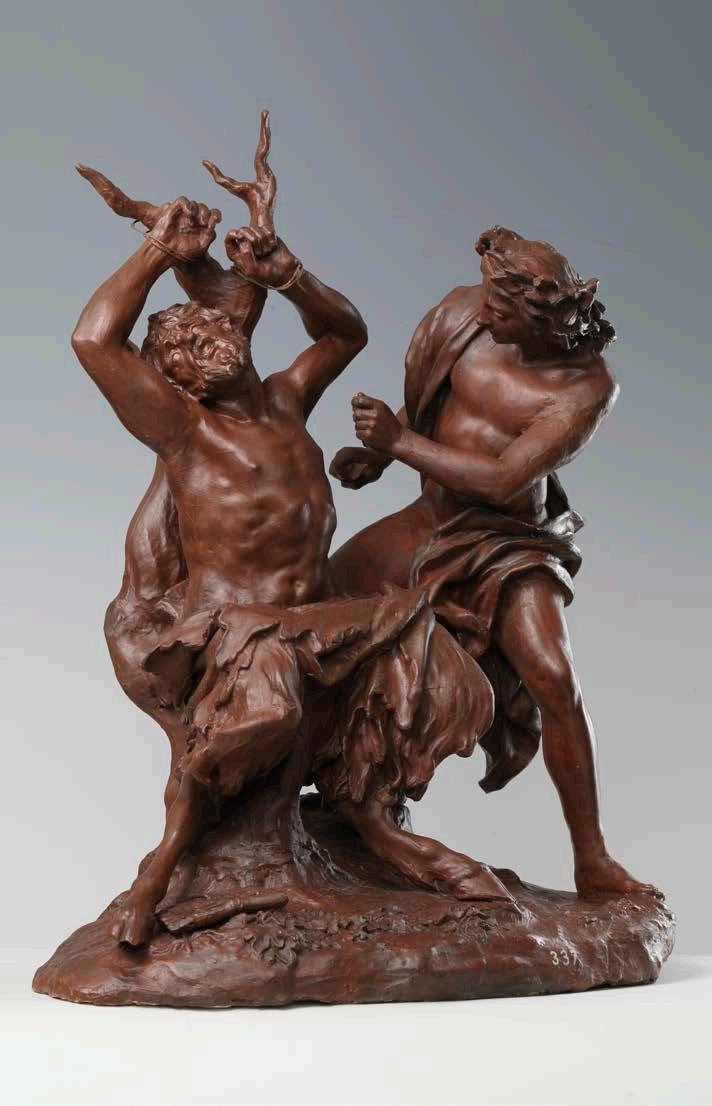 Vincenzo Foggini, Apollo and Marsyas (from Giovan Battista Foggini), 1748, wax and plaster, Sesto Fiorentino, Museo Ginori (ph. Arrigo Coppitz)
Vincenzo Foggini, Apollo and Marsyas (from Giovan Battista Foggini), 1748, wax and plaster, Sesto Fiorentino, Museo Ginori (ph. Arrigo Coppitz)
biennaleantiquariato 113
community initiatives, getting the collections out and about: we’ll be showing selections of items in various places in Florence on a rota tional basis. We have two exhibitions planned, one at Palazzo Poldi Pezzoli in Milan and an other in Florence in conjunction with our programme for promoting the collections and individual pieces.
What’s your recollection of the museum be fore you took charge?

I visited the museum many times in the past. But my clearest memory is when I arrived in 2015, 18 months after the closure, and saw the place in a mess, with buckets to catch the water coming in through the roof. It was a shock, and I even wrote an article in La Repubblica about it. Synergy between BIAF and the Fondazione Archivio Museo Richard Ginori della Mani fattura di Doccia gave rise to a major resto ration project. How does it work?
I’m grateful to the Antiques Biennale and to Fabrizio Moretti for choosing the Ginori Mu seum. It’s a bold project, and not an obvious one: restoration of an 18th-century wax mod el by Vincenzo Foggini, depicting a scene from mythology with Apollo and Marsyas. It was damaged due to exposure to a heat source. We got the news during the scorching sum mer just past, and it seemed to me like a met aphor for the ongoing climate crisis: we were literally melting at temperatures of 38 and 40 degrees, and there’s the possibility, however remote, that we’re still in time to stop it.

iniziative per la comunità, facendo uscire le collezioni: a rotazione esporremo se lezioni di opere in vari luoghi di Firenze.
Ci sono in programma due mostre, una a Milano a Palazzo Poldi Pezzoli e una a Fi renze in linea con il programma di valoriz zazione delle collezioni e dei singoli pezzi.
Qual è il suo ricordo del Museo prima di assumerne la presidenza?
L’ho visitato molte volte in passato. Ma il ricordo più vivo è quando ci sono entrato nel 2015, a un anno e mezzo dalla chiusu ra, e l’ho visto distrutto, con i secchi per raccogliere l’acqua che entrava dal tetto.
Fu uno shock, ne scrissi un articolo su La Repubblica Una sinergia tra BIAF e Fondazione Ar chivio Museo Richard Ginori della Mani fattura di Doccia ha dato avvio a un’im portante campagna di restauro. Di cosa si tratta?
Sono grato alla Biennale dell’Antiquariato e a Fabrizio Moretti per aver scelto il Mu seo Ginori. È un intervento coraggioso e non ovvio: il restauro di un modello sette centesco in cera di Vincenzo Foggini, una scena mitologica con Apollo e Marsia. Si è rovinato per l’esposizione a una fonte di calore. La notizia, arrivata nella caldissima estate alle spalle, mi ha rimandato a una metafora della crisi climatica in corso: noi che ci stavamo letteralmente sciogliendo a temperature di 38-40 gradi e la possi bilità, sia pure remota, di essere ancora in tempo per fermarla.
Giuseppe Piamontini and workshop (attr), Sacrifice of Isaac, 1722, terracotta, Sesto Fiorentino, Museo Ginori (ph. Arrigo Coppitz/Amici di Doccia)
‘IT WILL BE A
114 biennaleantiquariato
porcelain,CraterMODERNLIVELY,PLACE,ACRUCIALTESTAMENTTOTHELONGSTORYOFAWORKINGCOMMUNITY’vasewithviewoftheDocciaFactory,18511851,SestoFiorentino,MuseoGinori


LONDON In Pursuit of Caravaggio 21 Nov 2016 – 17 Feb 2017 MILAN White Marble and Painting. From Antiquity to Now 21 Feb – 7 Mar 2014
BETWEEN THE PAST AND FUTURE
A conversation with the director Andrea Di Lorenzo to learn about the present and the future of the Ginori Museum Una chiacchierata con il direttore Andrea Di Lorenzo per capire cos’è stato e cosa sarà il Museo Ginori TERESA

hat makes the histo ry of the Ginori man ufactory unique?
th th
When and how was the Ginori Museum born?
Qual è l’unicità della Manifattura Ginori nella storia? È stata
Quando e come nasce il Museo Ginori?
116 biennaleantiquariato
text
WFAVI
ONEWASMANUFACTORYGINORIFONUDEDIN1737.ITWASONEOFTHEFIRSTPORCELAINFACTORIESINEUROPEANDISOFTHEFEWSTILLACTIVEAndreaDiLorenzoaa
 Manifattura Ginori, Venus de’ Medici, ca. 1747, porcelain, Sesto Fiorentino, Museo Ginori (ph. Arrigo Coppitz)
Manifattura Ginori, Venus de’ Medici, ca. 1747, porcelain, Sesto Fiorentino, Museo Ginori (ph. Arrigo Coppitz)
biennaleantiquariato 117
The headquarters awaits renovation, the collection is safe and the front garden is already open to the public. What will the Museum be like when it reopens?
THE ARECARLOFOUNDERGINORIDECIDEDTOREPRODUCEANCIENTSCULPURES,THATTODAYAPRECIOUSTREASUREFORTHEMUSEUM

La sede è da restaurare, la collezione in salvo, il giardino antistante è già aperto al pubblico. Come sarà il Museo quando
The symbol of this history?
Venus of the MediciVenus
Ilriaprirà?simbolo
di questa storia?
Venere dei Medici
Venere
 Manifattura Ginori, David with the head of Goliath by Giovanni Battista Foggini, circa 1749, porcelain, Sesto Fiorentino, Museo Ginori (ph. Arrigo Coppitz/Amici di Doccia)
Gio Ponti for Richard-Ginori at Doccia, Urn The archaeological walk, 1925
Manifattura Ginori, David with the head of Goliath by Giovanni Battista Foggini, circa 1749, porcelain, Sesto Fiorentino, Museo Ginori (ph. Arrigo Coppitz/Amici di Doccia)
Gio Ponti for Richard-Ginori at Doccia, Urn The archaeological walk, 1925
118 biennaleantiquariato
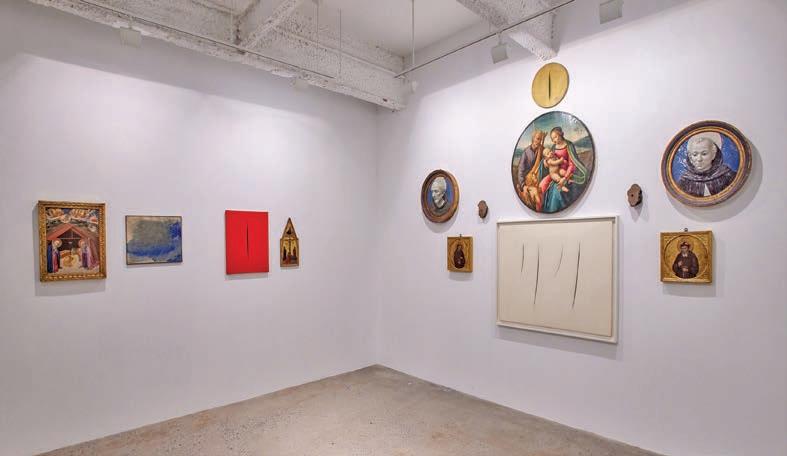

NEW YORK Lucio Fontana and The Gothic 4 May – 11 June 2022 PARIS Nero 22 Oct 2021 – 25 Mar 2022
THE ENERGY OF d’Italia Botticelli, il presidente d’Italia
text MARTINA OLIVIERI
Passionate about art since he was a child, Bruno Botticelli along with his sister Eleonora works in Italian sculp ture dating from the Middle Ages to today in his art gallery Botticelli An tichità. He has been president of the Associazione Antiquari d’Italia since the 1st of January.

Has the antiques market changed since the min isterial decree of May 2018 that streamlined the export of works of art?
The 2018 decree established that a work of art aged more than 50 years and a value of less than 13,500 euros can be exported with just a self-certi
makes life easier for the owners of antiques of little value who decide to move them outside the bor der. A leaner procedure that helps everyone’s work, but we are still far from the value thresholds used in other European countries. I love Italy and its cultural heritage, but I do not want to see it disconnected from the art market because of the lack of a clear agreement between State and Market on the mat ter of art export.
Are there any differences between being an art gallery owner in Italy and in another country?
Managing an art gallery in Italy means that you con stantly have to deal with the Ministry of Cultural Heritage that, more than any other European coun try, is formed by many valid scholars of ancient art.
In the art world, however, operators are sometimes referred to as enemies of the Cultural Heritage while they are actually essential to its preservation.
As the president of the Associazione Antiquari d’Italia, what are your objectives?
My wish is to do my part to preserve our image and make sure that one day we can have our rights
li insieme alla sorella Eleonora si occupa della scultura italiana dal Medioevo a oggi nella sua galleria Botticelli Antichità. Dal primo gennaio è presidente dell’Associazione Antiquari d’Italia. Come è cambiato il mercato dell’antiquariato dopo il decreto ministeriale del maggio 2018 che ha snellito l’export di opere d’arte?
Il decreto del 2018 ha sancito che sotto il tetto di 13500 euro le opere d’arte di oltre 50 anni di età possono essere esportate tramite
una rivoluzione che aiuta tutti i possessori di piccole opere antiche, che decidono di spostar
il lavoro di tutti ma siamo ancora lontani dalle soglie di valore europee. Io amo l’Italia e il suo Patrimonio, non posso però pensarla scolle gata dal mondo del mercato dell’arte a causa di un’assenza di un patto chiaro e possibile tra Stato e Mercato.
Ci sono delle differenze tra il gallerista in Italia rispetto ad un altro paese?
Fare il gallerista in Italia vuol dire confrontarsi costantemente con il Ministero dei Beni Cultu rali che vanta al proprio interno validi studiosi dell’arte antica.Tuttavia, gli operatori del mondo dell’arte sono allora talvolta additati come ne mici del Patrimonio Culturale mentre in realtà ne sono un motore fondamentale.
In quanto presidente dell’Associazione Anti quari d’Italia, che obbiettivi si è
Ho il sogno di contribuire a salvaguardare la nostra immagine e a far si che si possa un gior no essere protetti non come botteghe storiche, ma come produttori di cultura.
Bruno Botticelli (courtesy Guido Gozzi)
120 biennaleantiquariato
un’auè
GALLERYOWNER OFASSOCIAZIONEPRESIDENTANTICHITÀBOTTICELLIANDOFTHEANTIQUARID’ITALIA
SCULPTUREANCIENTBrunoBotticelli,thepresidentoftheAssociazioneAntiquari
Bruno
dell’Associazione Antiquari
protected not as historic shops, but as producers of culture.
How is the collecting industry changing?
We are experiencing the change that all sectors have undergone since the beginning of the new millennium. The new generations of collectors have grown up in an open-minded world where all the old points of reference are gone from fashion to sentimental relationships. Most of the one hundred thousand visitors of the Donatello exhibition in Palazzo Strozzi are the same people who go to see the Marina Abramovich or Jeff Koons’ sculptures. We need to restart from them.
During the BIAF, an altarpiece by Durante Alberti will be returned to the Cathedral of Sansepolcro: why this decision?

We bought the altarpiece of Durante Alberti many years ago together with Fabrizio Moretti, the Sec retary of the Biennale. It is a beautiful painting. At the time, we lent it to the Cathedral of Sansepol cro – where it comes from – for the pastoral visit of Pope Ratzinger. A well-known local businessman wanted to buy it to donate it to the church, but he did not go ahead with it and I took it back. Today, 20 years later, Fabrizio and I have been appointed at the same time two jobs full of meaning for our profession. What better time to return a piece of everything we have taken from the art world, and above all to thank our parents who brought us into this special world?
What does BIAF represent internationally for this sector and what are the characteristics that make it such an important event?
It is the most important exhibition in the world for ancient Italian Art. Art in the context of the Art of a city that lives on Art. A defensive wall against hitand-run tourism and the market of counterfeit items.

BIAF IS THE WALLEXHIBITIONIMPORTANTMOSTINTHEWORLDFORANCIENTITALIANART.ADEFENSIVEAGAINSTHIT-AND-RUN
Come vede cambiare il collezionismo?
Stiamo vivendo lo scollamento che tutti i set tori subiscono dal salto nel nuovo millennio. I openminded dove le vecchie categorie di riferimento sono saltate, dall’abbigliamento alle relazioni emotive. I centomila e più che hanno visitato Donatello a Palazzo Strozzi sono in buona par te gli stessi visitatori della Marina Abramovich o di Jeff Koons. Da loro dobbiamo ripartire. In occasione di BIAF verrà restituita alla Cat tedrale di Sansepolcro una pala d’altare di Du rante Alberti: come mai questa scelta?
Abbiamo acquistato la pala d’altare di Duran te Alberti molti anni fa insieme al Segretario della Biennale Fabrizio Moretti. É un quadro bello, lo abbiamo prestato all’epoca al Duomo di san Sepolcro, da dove proviene, per la visita Pastorale di papa Ratzinger. Sembrava che un noto imprenditore locale lo volesse acquista re per donarlo alla chiesa, ma non successe e l’ho ripreso. Oggi, 20 anni dopo, io e Fabrizio abbiamo in contemporanea due incarichi pieni
glior momento migliore per restituire qualcosa di tutto quello che abbiamo avuto dal mondo dell’arte e ringraziare i nostri genitori che ci hanno introdotto per mano in questo mondo?
Cosa rappresenta BIAF per il panorama mondiale del settore e quali sono le carat teristiche che la rendono un appuntamento così importante?
È la mostra più importante del mondo per l’Arte Italiana antica. Arte nell’Arte di una cit turismotà mordi e fuggi e contro il mercato del contraffatto.
Stand Palazzo Corsini - Botticelli (2009)
Altarpiece of Durante Alberti
biennaleantiquariato 121

BIAF 32 24 SETTEMBRE - 2 OTTOBRE PALAZZO CORSINI FIRENZE STAND N.49 ARTE MODERNA E CONTEMPORANEA Firenze - Lungarno Cellini, 3 +39info@tornabuoniarte.it0556812697 Milano - Via Fatebenefratelli, 34/36 +39milano@tornabuoniarte.it026554841 Forte dei Marmi - Piazza Marconi, 2 +39fortedeimarmi@tornabuoniarte.it0584787030 ARTE ANTICA Firenze - Via Maggio, 40r +39 055 2670260 Firenze - Via de’ Tornabuoni, 5 + 39 055 antichita@tornabuoniarte.it2398813 WWW.TORNABUONIART.COM STAND N. 49
The Ministerial Decree No. 246 of 17 May 2018 streamlined the export of art works, but only in the case of pieces produced less than 70 years ago or older items of lesser value. What is the current situation regarding the circulation of works of ancient art?
There is no doubt that the 2017 Reform, which also regarded works of ancient art of lower value – precisely, those with a value not exceeding 13,500 euros – streamlined the proce dures relating to the export of this type of goods through the
Il Decreto Ministeriale n. 246 del 17 maggio 2018 ha snellito l’export di opere d’arte ma solo per gli oggetti che hanno meno di 70 anni e per quelli antichi di minor valore. Come è la situazione per la circolazione di opere di arte antica? Certamente la Riforma del 2017, anche con riferimento alle opere di arte
di opere che, a prescindere dal loro valore economico, possano rivestire
reform has helped to create a virtuous circle of enhancement Instead, regarding the most valuable ancient works, we have
In the last years, there has been an increase in cases of cancel earlier. Could this trend have any effects on the market of ancient art?
It is of course normal that administration can annul one of the such cancellation can be made, so as to prevent the Italian ex Regarding this matter, we are very pleased with the recent rul
Negli ultimi anni si è assistito ad un aumento dei casi di annullamento di Attestati di libera circolazione rilasciati diversi anni prima.Tale fenomeno può avere degli effetti sul mercato dell’arte antica?
Quel che, però, è indispensabile è la previsione di un tempo massimo entro il quale tale annullamento possa essere fatto, allo scopo di evitare
biennaleantiquariato 123
ANDSAFEGUARDINGFREEDOMFrancescoSalamone,universityprofessorandinternationallawyertellsusabouttheexportofartworksinItalyFrancescoSalamone,docenteuniversitarioeavvocatointernazionale,ciraccontal’exportdiopered’arteinItaliatextFRANCESCALOMBARDI
no later than 12 months from its date of issue, except in cases
13,500 euro and older than 70 years provided important in ensuring an easier export procedure? Undoubtedly, the introduction of a value threshold has been
Italian threshold is much lower than that recommended by the in 2017 – a threshold of 13,500 eu very low threshold, even in comparison
euros: more than ten times higher than the Italian one!
It would therefore be desirable to amend the sector legislation by bringing the Ital ian thresholds, at least, closer to those ad
At the same time, do you believe it is important to regulate the circulation of works of important value?
It is essential! But it is also essential to limit the restrictions only to those works of art that are really important for our culture,
We all agree that safeguarding our cultural heritage is an invio lable principle, but can we make this happen without impover ishing our cultural heritage?
It would be enough to use the current system but with a dif ferent approach: in short, abandoning the concept of “when in doubt, limit” and adopting a system based on the idea of “limit
una storia superiore ai 70 anni è un aiuto importante per un export più snella? consi
ta in molti Stati comunitari ricchi di beni artistici
Inoltre, è a mio avviso concettualmente sbagliato una soglia
re mani alla normativa di settore prevedendo,
Allo stesso tempo è importante secondo lei regolamentare la circolazione di opere di va lore importante? È fondamentale! Quel che però è altrettanto fondamentale è limitare le importanti per la nostra cultura sulla scorta di elementi oggettivi e di
rare il nostro patrimonio culturale? rente: passare, in poche parole, dal concetto “nel dubbio, vincolo” al con
‘IT WOULD CLOSERTHRESHOLDS,BYDESIRABLEBEBRINGINGTHEITALIANTOTHOSEADOPTEDBYTHEEUROPEANCOMMUNITY’
124 biennaleantiquariato


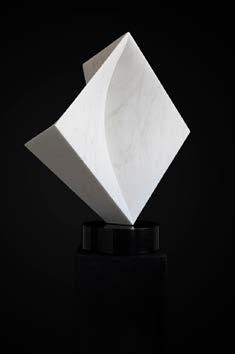


DUBAI | FORTE DEI MARMI | FIRENZE S T E F A N O B O M B A R D I E R I F L A V I O L U C C H I N I A N T O N I O S I G N O R I N I G U S T A V O V E L E Z DUBAI R29 Bluewaters Boulevard Bluewaters Island, United Arab Emirates +971 4 232 2071 info@oblongcontemporary com OBLONG CONTEMPORARY ART GALLERY NUOVA APERTURA FIRENZE FIRENZE Piazza del Carmine 8/R 50124 +39 3475640902 firenze@oblongcontemporary com FORTE DEI MARMI Via Giosuè Carducci 45 55042 +39 3357055914 fortedeimarmi@o blongcontemporary com
www. gallo neart.com www. gallo neart.it




GIAMBATTISTA TIEPOLO (Venezia 1696 - 1770 Madrid) Submersio Pharaonis Olio su tela cm 37,2 x 75,2Stand 10
The event has grown year on year Un evento cresciuto anno dopo anno

How has it changed in recent years?
Come è cambiata in questi ultimi anni?
W s
How important are initiatives like the Biennale during this much-needed period of recovery?
Quanto e come sono importanti queste inizia tive come la Biennale in un momento di neces saria ripresa?
Patronage of the arts is part of our city’s DNA. How important is it to continue investing in modern and contemporary art?
Il mecenatismo fa parte del Dna della nostra cit tà. Quanto è importante continuare a investire nell’arte moderna e contemporanea?
128 biennaleantiquariato
BANDCONTINUITYOFBASSILICHI,LEONARDOPRESIDENTOFTHEFLORENCECHAMBERCOMMERCEEXCELLENCEtextFRANCESCALOMBARDI

BIAF, landmark on the antiques scene Punto di riferimento nell’antiquariaro

ondazione CR Firenze, led by you, once again makes a decisive con tribution to the Antiques Biennale. What do you think of this year’s edition?
La Fondazione CR Firenze dai lei guidata, as sicura ancora una volta il suo determinante contributo alla Biennale dell’Antiquariato. Cosa pensa di questa nuova edizione?
A cosa si riferisce in particolare?
But the Biennale also wants to leave a tangible sign of its presence in the city…
Ma la Biennale vuole anche lasciare un segno tangibile della sua presenza in città…
130 biennaleantiquariato
FINFLORENCEFONDAZIONESALVADORI,LUIGIPRESIDENTOFCRFIRENZETHEWORLDtextFRANCESCALOMBARDI




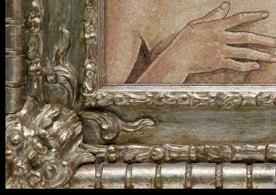

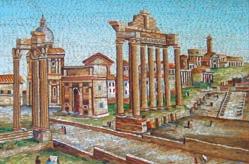

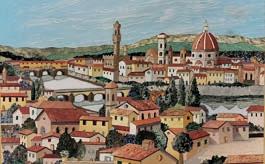
Florence Downtown Shop DOMO ART WORKS IN MOSAIC - HOME PRODUCTION SINCE 1870 WORLDWIDE DELIVERY
BIAF &
What does EY’s journey into the art world look like?
ITALYCEOANTONELLI,MASSIMOOFEYINANDCOOOFEYEUROPEWEST
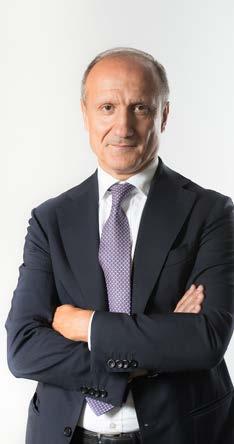
Can you tell us more about the collaboration be tween EY and BIAF?
In cosa consiste questo percorso di EY nell’arte?
Ci racconta la collaborazione tra EY e BIAF?
What will be the visitor’s experience in the metaverse?
Che esperienza vivranno i visitatori nel metaverso?
132 biennaleantiquariato
TCOLLABORATIONEYNewlanguagesinthenameofartNuovilinguagginelnomedell’artetextFRANCESCALOMBARDI

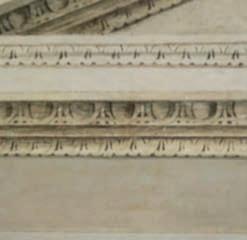



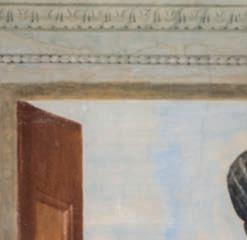
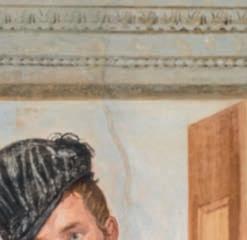


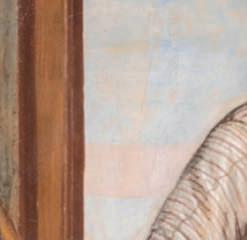
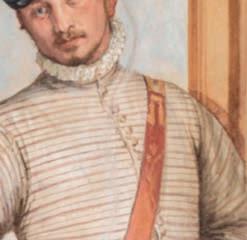
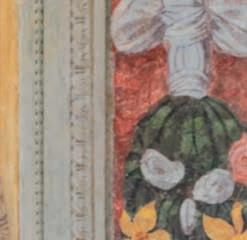
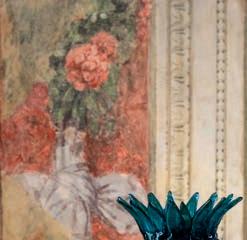

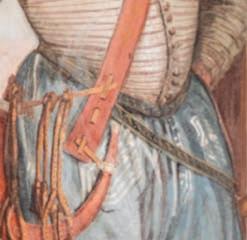







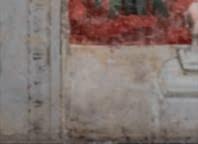
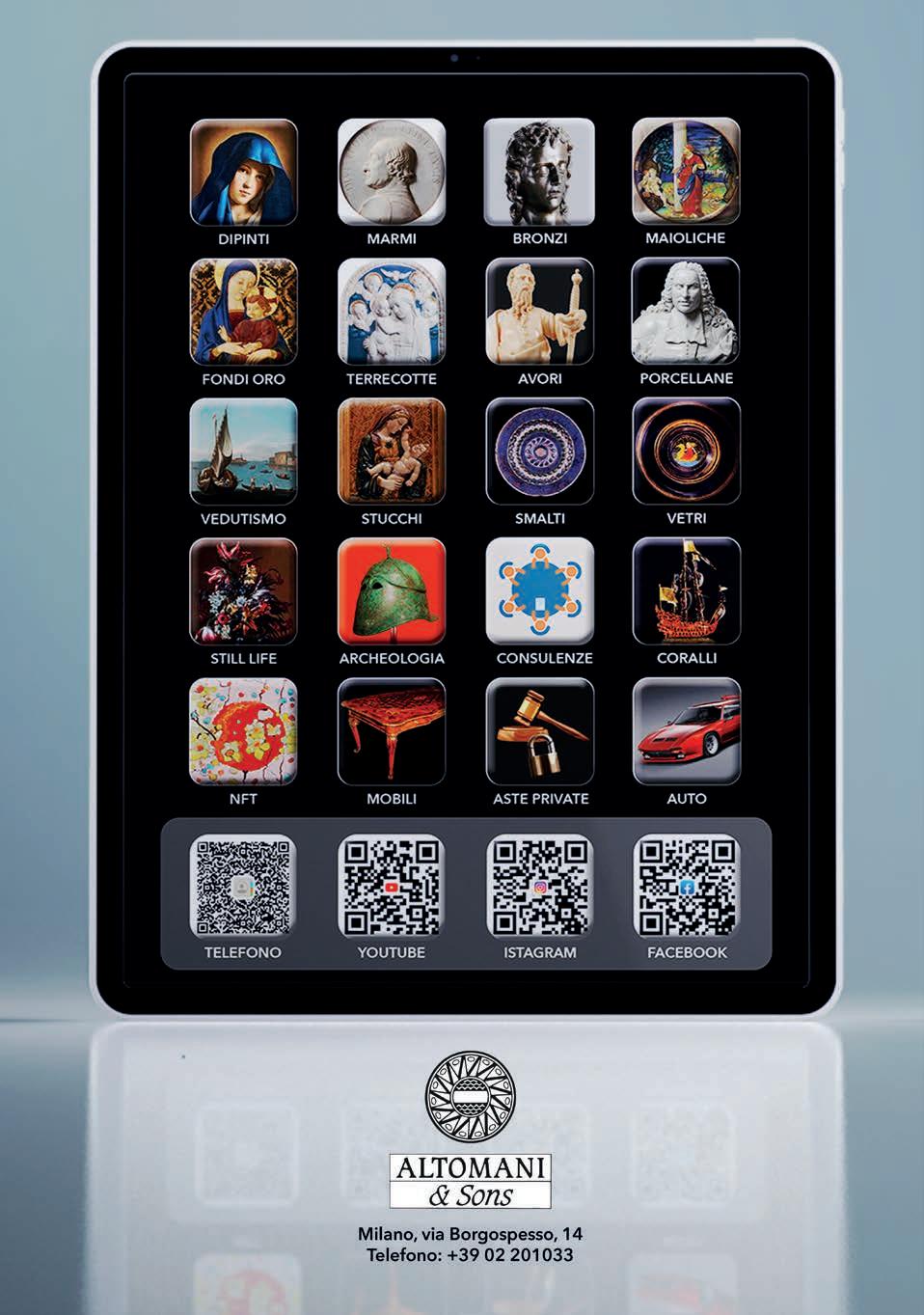

C A L E N D A R I O A S T E

+ 3 9 0 1 0 2 5 3 0 0 9 7 | i n f o @ w a n n e n e s g r o u p. c o m | wannenesgroup.com hbldlldlldOGIVANNIMIGLIARALapiazzaeDuomococopertoeiFiginie'isoatoeReeccino S t i m a € 1 0 . 0 0 0 1 5 . 0 0 0 7 19 settembre | O N L I N E | Arredi, Sculture e Oggetti d‘Ar te 15 27 settembre | O N L I N E | Cornici Antiche 20 settembre | G E N O VA | Giovanni M igliara: Dipinti, Disegni e Fixés sous verre 20 21 settembre | G E N O VA | Arredi, Sculture e Oggetti d‘Ar te Ceramiche Europee 22 settembre 4 ottobre | O N L I N E | Dipinti Antichi e del XIX Secolo 23 settembre 5 ottobre | O N L I N E | Opere Moderne e Multipli d’Autore 30 settembre 12 ottobre | O N L I N E | Gioielli 6 18 ottobre | O N L I N E | Design 7 19 ottobre | O N L I N E | Dipinti del Realismo Sovietico 27 ottobre | M I L A N O | Asian Ar t 28 ottobre 9 novembre | O N L I N E | Orologi da Tasca e da Polso 4 15 novembre | O N L I N E | Tappeti e Tessuti Antichi 9 21 novembre | O N L I N E | Wine & Spirits 17 29 novembre | O N L I N E | Manifesti 19 novembre | F I E R A M I L A N O R H O | Auto e Moto Classiche & Youngtimer 22 23 novembre | G E N O VA | Arredi, Sculture e Oggetti d‘Ar te Ceramiche Europee 23 novembre 6 dicembre | O N L I N E | Dipinti Antichi e del XIX Secolo 24 novembre | G E N O VA | Dipinti Antichi e Dipinti del XIX Secolo 1 dicembre | M I L A N O | Ar te Moderna e Contemporanea 7 8 dicembre | M O N T E C A R LO | Horlogerie & Bijoux 2 9 dicembre | O N L I N E | Argenti e Icone 12 dicembre | M I L A N O | Orologi da Tasca 13 dicembre | M I L A N O | Argenti, Icone e Oggetti d‘Ar te Russa 14 15 dicembre | G E N O VA | Design e Stile I taliano
M I L A N O | G E N O V A | R O M A | M O N T E C A R L O
800/900 ARTSTUDIO - Stand 27
AL FINE ART ANTONACCI LAPICCIRELLA - Stand 8
ALTOMANI & SONS - Stand 24
ANTICHITA’ GIGLIO - Stand 71-73
PAOLO ANTONACCI - Stand 75
GIOVANNI ASIOLI MARTINI ANTIQUARIO - Stand 59
BACARELLI ANTICHITÀ - Stand 16
GIORGIO BARATTI ANTIQUARIO - Stand 77-78
GUIDO BARTOLOZZI ANTICHITÀ - Stand 37
JEAN-LUC BARONI - Stand 4
BOTTEGANTICA - Stand 76 BOTTICELLI ANTICHITÀ - Stand 63
MAURIZIO BRANDI ANTIQUARIO - Stand 36
BRUN FINE ART - Stand 42
BUTTERFLY - Stand 29
CALLISTO FINE ARTS - Stand 38
ROBERTO CAMPOBASSO - Stand 41
CANTORE GALLERIA ANTIQUARIA - Stand 52
CARETTO&OCCHINEGRO - Stand 74
MIRCO CATTAI FINE ART & ANTIQUE RUGS - Stand 31
ATTILIO CECCHETTO ANTIQUARIO - Stand 79
ALESSANDRO CESATI - Stand 44
COPETTI ANTIQUARI - Stand 28
CORTONA FINE ART - Stand 54
DE JONCKHEERE - Stand 12
ALBERTO DI CASTRO - Stand 5
ALESSANDRA DI CASTRO - Stand 14
MIRIAM DI PENTA FINE ARTS - Stand 64
ENRICO GALLERIE D’ARTE - Stand 69
FONDANTICO di Tiziana Sassoli - Stand 65
ENRICO FRASCIONE - Stand 45
FRASCIONE ARTE - Stand 67
GALERIE CANESSO - Stand 7
GALLERIA BERARDI - Stand 55
GALLERIA CONTINUA - Stand 11
GALLERIA D’ARTE FREDIANO FARSETTI - Stand 68
GALLERIA GOMIERO - Stand 23
GALLERIA MARLETTA - Stand 25-26
GALLERIA POGGIALI - Stand 30
GALLERIA RUSSO - Stand 46
GALLERIA CARLO VIRGILIO & C. - Stand 20 GALLO FINE ART - Stand 10 MICHELE GARGIULO “ANTIQUARIO” - Stand 33 DARIO GHIO - Stand 39
GIACOMETTI OLD MASTER PAINTINGS - Stand 60 IOTTI ANTICHITÀ - Stand 53
MATTEO LAMPERTICO Arte Antica e Moderna - Stand 17 DYS44 LAMPRONTI GALLERY - Stand 6 LAOCOON GALLERY - Stand 13 LEONE - Stand 43 LONGARI ARTE MILANO - Stand 47 SANDRO MORELLI - Stand 56-57 MORETTI - Stand 66
MAURIZIO NOBILE - Stand 48 CARLO ORSI - Stand 2 ORSINI arte e libri - Stand 21 WALTER PADOVANI - Stand 9 A. PALLESI ART GALLERY - Stand 40 PARRONCHI DIPINTI ‘800-‘900 S.r.l. - Stand 19 PIVA & C. - Stand 61 PORCINI - Stand 18 REVE ART - Stand 72 ROBERTAEBASTA - Stand 70 ROBILANT+VOENA - Stand 15 ROMANO FINE ART - Stand 58 ROMIGIOLI ANTICHITÀ - Stand 62 SALAMON & C. - Stand 50 SANTA TECLA - Stand 32 GIOVANNI SARTI - Stand 3 SCULTURA ITALIANA di Dario Mottola - Stand 51 SECOL-ART ANTICHITA’ di Masoero Davide & C. - Stand 35 SOCIETÀ DI BELLE ARTI - Stand 34
SPERONE WESTWATER - Stand 1 TETTAMANTI ANTICHITÀ - Stand 22 TORNABUONI ARTE - Stand 49
biennaleantiquariato
137
EXHIBITORS32THEDITION-BIENNALEINTERNAZIONALEDELL’ANTIQUARIATODIFIRENZE p. 139 | p. 141 | p. 143 | p. 145 | p. 147 | p. 149 | p. 151 | p. 153 | p. 155 | p. 157 | p. 159 | p. 161 | p. 162 |
WELTKUNST magazine

free
issue Order www.zeit.de/wk-biafhere:
800/900 ARTSTUDIO
Stand 27 Via Roma 63-67 57126 Livorno
Tel. +39 0586 815 200 Via del Battistero 22/24 55100
www.800artstudio.comstudioarte800@libero.itpostamaster@800artstudio.com;post@800artstudio.comLucca
ASTOLFO DE MARIA (Rome 1891 - Venice 1946)

Piccola commedia
Tempera on slab, 50 x 145 cm ca, (1933) Piccola commedia Tempera su lastra, 50 x 145 cm ca. (1933)

AL FINE ART LAPICCIRELLAANTONACCI
Stand 8 Via Margutta 54 00187 Roma Tel. +39 06 4543 www.alfineart.cominfo@alfineart.com3036
ANTONIO CANOVA (Possagno 1757 - Venezia 1822) Giorgione’s self portrait Oil on panel, 72,5 x 64 cm

Autoritratto di Giorgione Olio su tavola, 72,5 x 64 cm
ALTOMANI & SONS Stand 24 Via Borgospesso 12/14 20121 Milano Tel. +39 02 201033 Via Baviera 18/20 61100 www.altomani.commail@altomani.comPesaro
ANTICHITA’ GIGLIO
Stand 71-73
Via C. Pisacane 53 20129 Milano Tel. +39 02 294 031 46 Cel. +39 335 637
www.antichitagiglio.itinfo@antichitagiglio.it9151
GIOVANNI ERMANS
Commode Rosewood, violet wood, gilt bronze and jasper 92,5 x 152 x 64 cm, (1765 ca)

Commode Legno di rosa, legno violetto, bronzo dorato e 92,5diasprix152 x 64 cm, (1765 ca.)
PAOLO ANTONACCI Stand 75 Via Alibert 16a 00187 Roma Tel. +39 06 326 516 www.paoloantonacci.cominfo@paoloantonacci.com79
FRANÇOIS (FRANZ) KEISERMAN (Yverdon, Switzerland, 1765 - Rome, 1833) A view of the Pantheon Watercolour and Indian ink on paper, 760 x 1220 mm, (1803 -1805 ca) Veduta del Pantheon Acquerello e inchiostro a china su carta, 760 x 1220 mm, (1803 -1805 ca.)
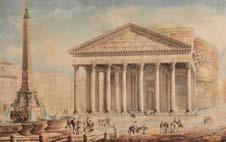
BROTHERS GIACOMO FILIPPO AND DAMIANO DA GONZATE (Parma 1490-1520) Saint Matthew the Evangelist Bronzo, (165 ca) San Matteo Evangelista Bronzo, (165 ca.)
GIOVANNI ASIOLI MARTINI ANTIQUARIO Stand 59 Via Emilia 3 40026 Imola (Bologna) Tel. +39 335 817 94 36 asiolimg@libero.it A Thecuprape of Proserpina (1525-40 ca) IlCopparatto di Proserpina (1525-40 ca.)
biennaleantiquariato 139

The art of seeing clearly

Subscribe to Apollo magazine from just £1 a week for the best writing about art, incisive commentary and exclusive reviews Subscribe here: www.apollo-magazine.com/BIAF
BACARELLI ANTICHITÀ
Stand 16
Via dei Fossi 45r 50123 Firenze
Tel. +39 055 215 www.bacarelli.combacarelli@bacarelli.com457
GIUSEPPE TORRETTI (Pagnano d’Asolo, Treviso 1664 - Venice 1743)
Bust of a philosopher Carrara marble, 59,5 x 29,5 x 16 cm, (1730 ca)
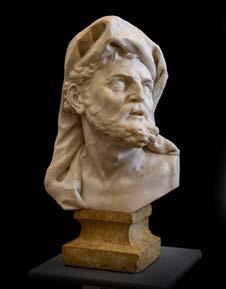
Marmo di Carrara, 59,5 x 29,5 x 16 cm, (1730 ca.)
GIORGIO BARATTI ANTIQUARIO Stand 77-78 Via Bigli 11 20121 Milano Tel. +39 02 367 064
www.giorgiobaratti.itgiorgio.baratti@libero.it46
BARTOLOMEO MENDOZZI
(Leonessa, RI ca 1600 - Rome, active until the mid 1650s)

Saint Judas Thaddaeus

Oil on canvas, 129 x 97 cm, (1625-1630 ca)
alla metà del quinto decennio del XVII secolo)
San Giuda Taddeo Olio su tela, 129 x 97 cm, (1625-1630 ca.)
GUIDO BARTOLOZZI ANTICHITÀ
Stand 37 Via Maggio 11 50125 Firenze
Tel. +39 055 215 www.guidobartolozzi.cominfo@guidobartolozzi.com602
ITALO NUNES VAIS (Tunis 1860 - Florence 1932)
The regiment is parading Oil on canvas, 169 x 280 cm
In a gilt and carved frame, 221 x 330 cm
Passa il reggimento Olio su tela, 169 x 280 cm

In cornice intagliata e dorata 221 x 330 cm
JEAN-LUC BARONI & MARTY DE CAMBIAIRE
Stand 4 7-8 Mason’s Yard, Duke Street, St. James’s SW1Y 6BU Londra
Tel. +44 207 930 5347
16 Place Vendome 75001 Parigi Tel. +33 1 49 26 07 03 www.jlbaroni.cominfo@jlbaroni.comwww.jlbmdc.cominfo@jlbmdc.com
SEBASTIANO RICCI (Belluno 1659 - Venice 1734) Cleopatra and the asp Oil on canvas, 102 x 73,5 cm Cleopatra e l’aspide Olio su tela, 102 x 73,5 cm
BOTTEGANTICA Stand 76
Via Manzoni 45 20121 Milano Tel. +39 02 626 954 89
Via D’Azeglio 96/a 40123 Bologna Tel. +39 051 331 www.bottegantica.cominfo@bottegantica.com338
GIOVANNI BOLDINI
(Ferrara 1842 - Paris 1931)
A gallant scene in the park at Versailles Oil on panel, 14,5 x 24 cm, (1877)
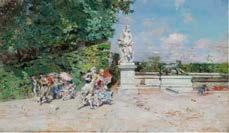
Scena galante nel Parco di Versailles Olio su tavola, 14,5 x 24 cm, (1877)
BOTTICELLI ANTICHITÀ Stand 63 Via Maggio 29 50125 Firenze
Tel. +39 055 230 20 www.botticelliantichita.comeleonora@botticelliantichita.combruno@botticelliantichita.com;95
LORENZO MAITANI (Siena, last quarter of the thirteenth centuryOrvieto, documented on September 16th 1310 as the chief-mason of the Duomo; died in June 1330)
Wood of a fruit tree (pear tree), 68 x 68 cm (81 cm including the arms), (1325-1330 ca) (Siena, ultimo quarto c. del XIII secolo - Orvieto, doc. il 16 settembre 1310 come capomastro del Duomo; morto nel giugno 1330)
Legno di frutto, 68 x 68 cm (altezza con le braccia 81 cm), (1325/30 ca.)
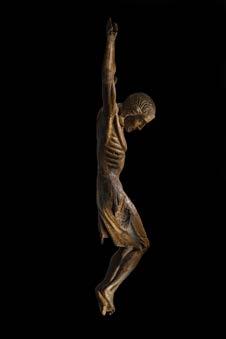
biennaleantiquariato 141
MAURIZIO BRANDI ANTIQUARIO
Stand 36
Via D. Morelli 9 80121 Napoli
Tel. +39 081 764 3882
Via Bisignano 24 80121 www.antiquarinapoletani.it/brandimauriziobrandi@live.comNapoli
PACETTI FILIPPO (Rome 1809 - 1857)
Oil lamp Melted, embossed and chiseled silver, Lucerna Argento fuso, sbalzato e cesellato, Altezza 95cm

BRUN FINE ART
Stand 42 38 Old Bond Street
W1S 4QW Londra
Tel. +44 207 7493 0195
Via Gesù 17 20121 Milano Tel. +39 02 295 180 31
www.brunfineart.comwww.brunfineart.itinfo@brunfineart.cominfo@brunfineart.it
REAL FABBRICA FERDINANDEA
Naples (19th century)
A pair of terracotta vases depicting portraits

Coppia di vasi in terracotta con ritratti di Clemente di Sassonia e di sua sorella Maria Josefa Amalia di Sassonia
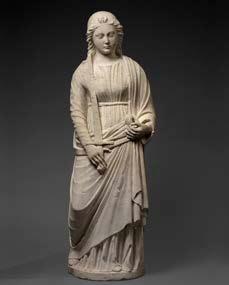
BUTTERFLY Stand 29 Viale Giuseppe Cattori 5A 6900 Lugano Tel. +41 91 682 www.butterflyinstitute.cominfo@butterflyinstitute.com6222
JOHN WILLIAM GODWARD (Wimbledon 1861 - London 1922)
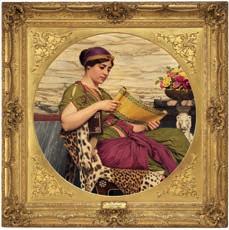
CALLISTO FINE ARTS
Stand 38 44 Duke Street, St. James’s SW1Y 6DD Londra Tel. +44 207 839 www.callistoart.comcallistofinearts@gmail.cominfo@callistoart.com;7037
JACOPO DELLA PILA (Lombardy - Naples 1502) Justice Marble, Giustizia Marmo, altezza 108 cm ca. (1473)
ROBERTO CAMPOBASSO Stand 41 Via Carlo Poerio 17 80121 Napoli Tel. +39 081 764 www.robertocampobasso.comrobertocampobasso3@gmail.com0770
LORENZO BARTOLINI (Savignano (Prato) 1777 - Florence 1850)
Alessandro I Zar di Russia Marmo, altezza 71 cm, (1807)

CANTORE GALLERIA ANTIQUARIA Stand 52 Via Farini 14 41121 Modena Tel. +39 059 225 www.galleriacantore.itinfo@galleriacantore.it400
UBALDO GANDOLFI (San Matteo della Decima 1728 - Ravenna 1781)
The Visitation Oil on canvas, 131 x 98 cm, (1765 ca) La Visitazione Olio su tela, 131 x 98 cm, (1765 ca.)
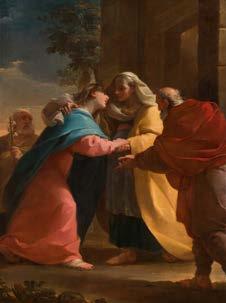
biennaleantiquariato 143


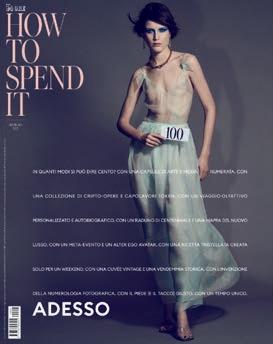


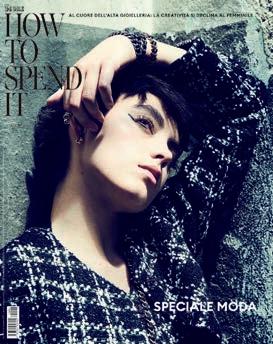
CARETTO&OCCHINEGRO
Stand 74 Via A. Massena 87 10128 Torino Tel. +39 338 871 www.carettoeocchinegro.cominfo@carettoeocchinegro.com2326
ABRAHAM TENIERS (Antwerp, 1629 - 1670)
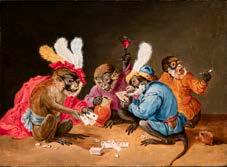
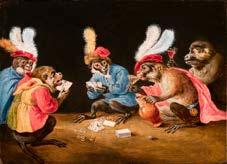
Oil on panel, 16 x 23 cm, (1650 ca)
Olio su Tavola, 16 x 23 cm, (1650 ca.)
MIRCO CATTAI FINE ART & ANTIQUE
RUGS Stand 31 Via Manzoni 12 20121 Tel.+39Milano02760 089 www.mircocattai.cominfo@mircocattai.com59

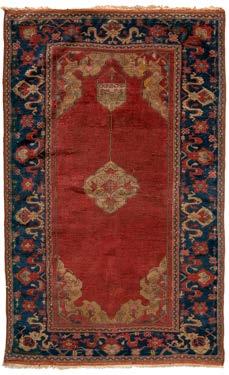

Ushak ‘Tintoretto’
167 x 102 cm, (mid-16th century) 167 x 102 cm, (metà XVI secolo)
ATTILIO CECCHETTO ANTIQUARIO
Stand 79 Piazza San Vito 3 31030 San Vito di Altivole (Treviso) Tel. +39 0423 72948 Cel. +39 348 721 8170; +39 349 075 www.cecchettoprior.itinfo@attiliocecchettoantiquario.com2540
VENETIAN MANUFACTURE (Beginning of the 18th century)
A dressing table with a carved, lacquered, gilt and faux tortoise shell wood frame, with motherof-pearl inlay work.
Specchiera con intarsi di madreperla Specchiera con cornice in legno intagliato, madreperla.
ALESSANDRO CESATI
Stand 44 Via San Giovanni sul Muro 3 20121 Milano Tel. +39 02 864 609 28
www.cesatiecesati.comacesati@tiscali.it
GIOVANNI DI BALDUCCIO (Pisa, documented from 1318 to 1349) Head of a prophet Candoglia marble, 31,5 x 14 x 43,4 cm height, (1340-1350 ca) (Pisa, documentato dal 1318 al 1349) Testa di profeta Marmo di Candoglia, 31,5 x 14 x 43,4 cm altezza, (1340-1350 ca.)

COPETTI ANTIQUARI
Stand 28 Via Natisone 1 33040 Premiaracco (Udine)
Tel. +39 0432 502 784 Cel. +39 335 809 6532 +39 392 559 8729 +39 340 977 www.copettiantiquari.cominfo@copettiantiquari.com7278
DINO BASALDELLA (Udine 1909 - 1987)
Prometheus 80 x 127 x 20 cm, (1956) Prometeo 80 x 127 x 20 cm, (1956)
biennaleantiquariato 145


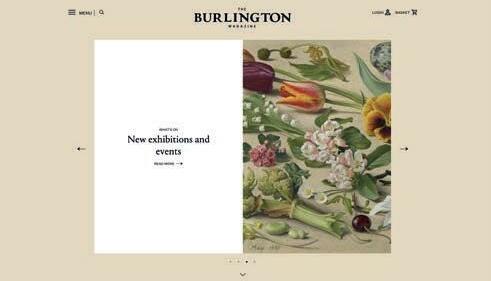



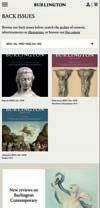
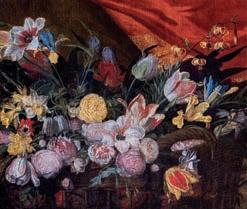




30% off for new readers Visit our website for more shop.burlington.org.ukinformation Terms and Conditions apply. This offer is applicable for new subscribers and for the first year only. For more information on our full pricing list and range of subscription packages available, please visit: shop.burlington.org.uk/subscriptions All individual subscriptions now include digital access to our complete archive: 1903 to present Art in Britain A Nathaniel Bacon discovery Turner and Ossian G.F. Watts and Pheidias In search of Edward Detmold Annibale Carracci in Madrid Boldini in Paris Louise Bourgeois in New York The Venice Biennale NEW RESEARCH ON ART AND ITS HISTORY JULY 20221432JULYMAGAZINEBURLINGTONTHE2022NOVOL164 The secrets of a revolutionary portrait A sculpture for Isabella d’Este Ter Brugghen’s ‘Roman Charity’ discovered With Sargent in the Alps Late Gothic in Berlin The Medici in New York The Museum of the Home in London In search of Van Eyck’s workshop Art of conservation: Jan Cornelis Traas and the Van Gogh family collection British portraits of a Danish king A Netherlandish altarpiece in Clerkenwell Hogarth, race and empire Sophie Taeuber-Arp in New York NEW RESEARCH ON ART AND ITS HISTORY FEBRUARY 202214272022FEBRUARYMAGAZINEBURLINGTONTHENOVOL164
CORTONA FINE ART 54 Corso Monforte 38 20122 Milano +39 02 784 617 Cel. +39 349 831 +39 339 838 federico@galleriacortona.com;enrico@galleriacortona.com;0048 www.galleriacortona.comgalleriacortona.com
GIULIO CESARE PROCACCINI (Bologna 1574 - Milan 1625) Repentant Magdalene with an angel Oil on panel, 102,5 x 67,3 cm Maddalena penitente e un angelo Olio su tavola, 102,5 x 67,3 cm
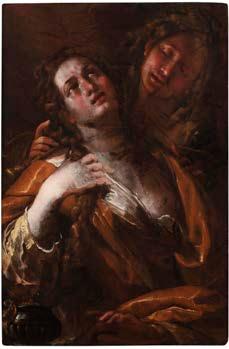
DE JONCKHEERE Stand 12 7 rue de l’Hotel de Ville 1204 Ginevra Tel. +41 22 310 www.dejonckheere-gallery.comgeneve@dejonckheere-gallery.com8080
JAN BRUEGHEL THE YOUNGER (Brussels 1601 - Antwerp 1678)
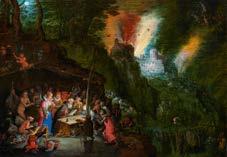
Panel, 31,2 x 45 cm
La tentazione di Sant’Antonio Tavola, 31,2 x 45 cm
ALBERTO DI CASTRO Stand 5 Piazza di Spagna 5 00187 Roma
Tel. +39 06 679 www.dicastro.cominfo@dicastro.com2269
FRANCESCO DE POLETTI, ATTRIBUTED TO (Rome 1779 -1854)
Micro mosaic, 15 x 19 cm with a gilt bronze frame, (1805/1810 ca) Paesaggio ideale con Fuga in Egitto Mosaico minuto, 15 x 19 cm con cornice in bronzo dorato, (1805/1810 ca.)

ALESSANDRA DI CASTRO
Stand 14 Piazza di Spagna 3-4 00187 Roma Tel. +39 06 699 231 www.alessandradicastro.cominfo@alessandradicastro.com27
GIOVANNI BATTISTA PIAZZETTA (Venezia 1683 - 1754)
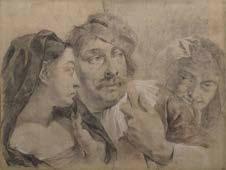

White and black chalk on paper, 390 x 515 bianco e nero su carta, 390 x 515
MIRIAM DI PENTA FINE ARTS Stand 64 Via di Monserrato 34 00186 Roma Tel. +39 388 849
www.miriamdipentafinearts.commiriam@mdpfinearts.cominfo@mdpfinearts.com;6554
LUCA GIORDANO (Naples 1634 - 1705)
A philosopher - alchemist Oil on canvas, 109 x 89 cm
Filosofo - alchimista Olio su tela, 109 x 89 cm
ENRICO GALLERIE D’ARTE Stand 69 Via Senato 45 20121 Milano Tel. +39 02 8723 5752 Via Garibaldi 11 16124 Genova Tel. +39 010 247 www.enricogallerie.comangelo@enricogallerie.comenricogallerie@iol.it;0150
ADOLFO WILDT (Milan 1861 - 1931)
The protection of little children Marble, 22,6 x 25,2 x 5,2 cm, (1919)
La protezione dei pargoli Marmo, 22,6 x 25,2 x 5,2 cm, (1919)
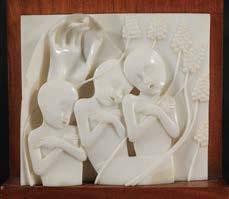
biennaleantiquariato 147
mm Gesso
mm
Stand
Tel.
0803;
info@

FONDANTICO di Tiziana Sassoli
Stand 65 Via de’ Pepoli 6/e 40125 Bologna
Tel. +39 051 265 www.fondantico.itinfo@fondantico.it980
GIOVANNI FRANCESCO BARBIERI
DETTO IL GUERCINO (Cento 1591 - Bologna 1666)
Red chalk on laid paper, 256 x 235 mm, (1638-1639)

La carità romana Sanguigna su carta vergellata, 256 x 235 mm, (1638-1639)
ENRICO FRASCIONE
Stand 45
Via dei Fossi 61/r 50123 Firenze
Tel. +39 055 709 info@enricofrascione.comenricofrascioneantiquario@gmail.com;365
ZANINO DI PIETRO
Tempera and gold on panel, (1425 ca) Sposalizio mistico di Santa Caterina Tempera e oro su tavola, (1425 ca.)
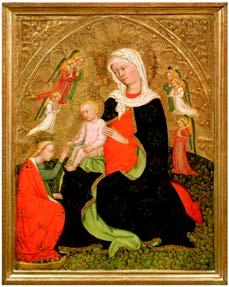
FRASCIONE ARTE Stand 67
Via Maggio 5/7 50125 Firenze
Tel. +39 055 239 www.frascionearte.cominfo@frascionearte.com9205
BERNARDO STROZZI, DETTO IL CAPPUCCINO (Campo Ligure or Genoa 1582 - Venice 1644)
Oil on canvas, 38 x 50,5 cm, (1610-1615) Olio su tela, 38 x 50,5 cm, (1610-1615)

GALERIE CANESSO Stand 7 26 rue Laffitte 75009 Parigi Tel. + 33 1 4022 info@galleriacanesso.artTel.20121Viawww.galleriacanesso.chinfo@galleriacanesso.chTel.6900PiazzaGalleriawww.canesso.artcontact@canesso.com6171CanessoLuganoRiforma2Lugano+410916828980Borgonuovo24Milano+390291555544
LOMBARD SCULPTOR (active between the end of the 16th and the beginning of the 17th century)

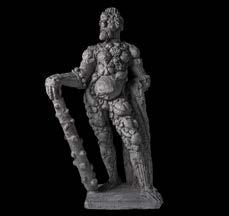
Viggiù stone, 197 x 72 x 81 cm Il Custode dell’orto Pietra di Viggiù, 197 x 72 x 81 cm
GALLERIA BERARDI
Stand 55 Corso Rinascimento 9 00186 Roma Tel. +39 06 976 061 galleria.berardi@gmail.com;27 info@ www.berardiarte.itberardiarte.it
FERRUCCIO FERRAZZI (Rome 1891 - 1978)
Oil on canvas, 155 x 125 cm, (1925) Viaggio tragico Olio su tela, 155 x 125 cm, (1925)

GALLERIA CONTINUA Stand 11 Via del Castello 11 53037 San Gimignano Tel. +39 0577 943
www.galleriacontinua.comhabana@galleriacontinua.comTel.BarrioRayolemoulin@galleriacontinua.comTel.7716946beijing@galleriacontinua.comTel.100015JiuxianqiaoDashanzisangimignano@galleriacontinua.commilo@galleriacontinua.com;134ArtDistrict798#8503,2Road,ChaoyangDst.Pechino+861059789505RuedelaFertéGaucherBoissy-le-Chatel+33164203950108entrelaZanjayDragonesChino,CentroL’Avana+5358692922;+5355516507
ANISH KAPOOR (Mumbai, India, 1954)
Magenta Stainless steel and enamel, 90 x 90 x 9,5 cm, (2020)
Magenta Acciaio inossidabile e smalto, 90 x 90 x 9,5 cm, (2020)

biennaleantiquariato 149
Italian handmade luxury
instagram: kover_luxury We will be presenting at BIAF 2022 www.k-over.com

GALLERIA D’ARTE FREDIANO FARSETTI
Stand 68
Via della Spiga 52 20121 Milano
Tel. +39 02 794 274; +39 02 760 132 28 www.galleriafredianofarsetti.itinfo@galleriafredianofarsetti.it
MAX ERNST (Brühl 1891 - Paris 1976)
Quasimodo genetis Oil on canvas, 61 x 46 cm, (1956) Quasimodo genetis Olio su tela, 61 x 46 cm, (1956)
GALLERIA GOMIERO
Stand 23 Corso Terme 4 35036 Montegrotto Terme (Padova) Tel. +39 348 263 info@galleriagomiero.com7330
MAURICE CONSTANT FAVRE (Saint Maurice 1875 - Paris 1919)
Portrait of Heinrich Schliemann Carrara marble, 75 x 100 x 63 cm, (1918) Ritratto di Heinrich Schliemann Marmo di Carrara, 75 x 100 x 63 cm, (1918)
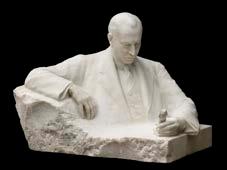
GALLERIA MARLETTA Stand 25-26 Piazza S. Felice, 10r 50125 Firenze Tel. +39 055 294 www.alessandromarletta.comam@alessandromarletta.cominfo@alessandromarletta.com592
LORENZO BARTOLINI (Savignano (Prato) 1777 - Florence 1850)
White marble, 67,5 cm, (end of the second decade of the 19th century)

GALLERIA RUSSO Stand 46 Via Alibert 20 00187 Roma Tel. +39 06 678 info@galleriarusso.com;9949 fabrizio.russo@ www.galleriarusso.itgalleriarusso.com
UMBERTO BOCCIONI (Reggio Calabria, 19 October 1882 - Verona, 17 August 1916)
Oil on canvas, 40 x 60 cm, (1909) Periferia Olio su tela, 40 x 60 cm, (1909)
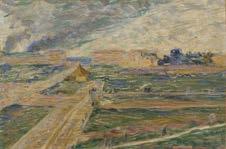
GALLERIA POGGIALI
Stand 30
Via della Scala 35a Via Benedetta 3r 50123 Firenze
Tel. +39 055 287 748
Foro Buonaparte 52 20121 Milano Tel. +39 02 7209 5815
Via Garibaldi 8 Via Marconi 50 55045 Pietrasanta Tel. +39 334 923 wwwgalleriapoggiali.cominfo@galleriapoggiali.com6625
CLAUDIO PARMIGGIANI (Luzzara, 1943)
Icon Oil on canvas, 150,5 x 120 cm, (1975)

Icona
Olio su tela, 150,5 x 120 cm, (1975)
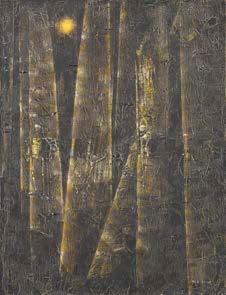
GALLERIA CARLO VIRGILIO & C. Stand 20 Via della Lupa 10 00186 Roma
Tel. +39 06 687 1093 59 Jermyn Street, flat 5 SW1 6LX Londra Cel. +39 338 242 www.carlovirgilio.itinfo@carlovirgilio.itinfo@carlovirgilio.co.uk7650
DUILIO CAMBELLOTTI (Rome 1876 - 1960)
The ancestor Bronze, 45 x 45 x 15 cm, (1924) L’avo Bronzo, 45 x 45 x 15 cm, (1924)
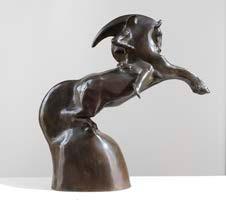
biennaleantiquariato 151
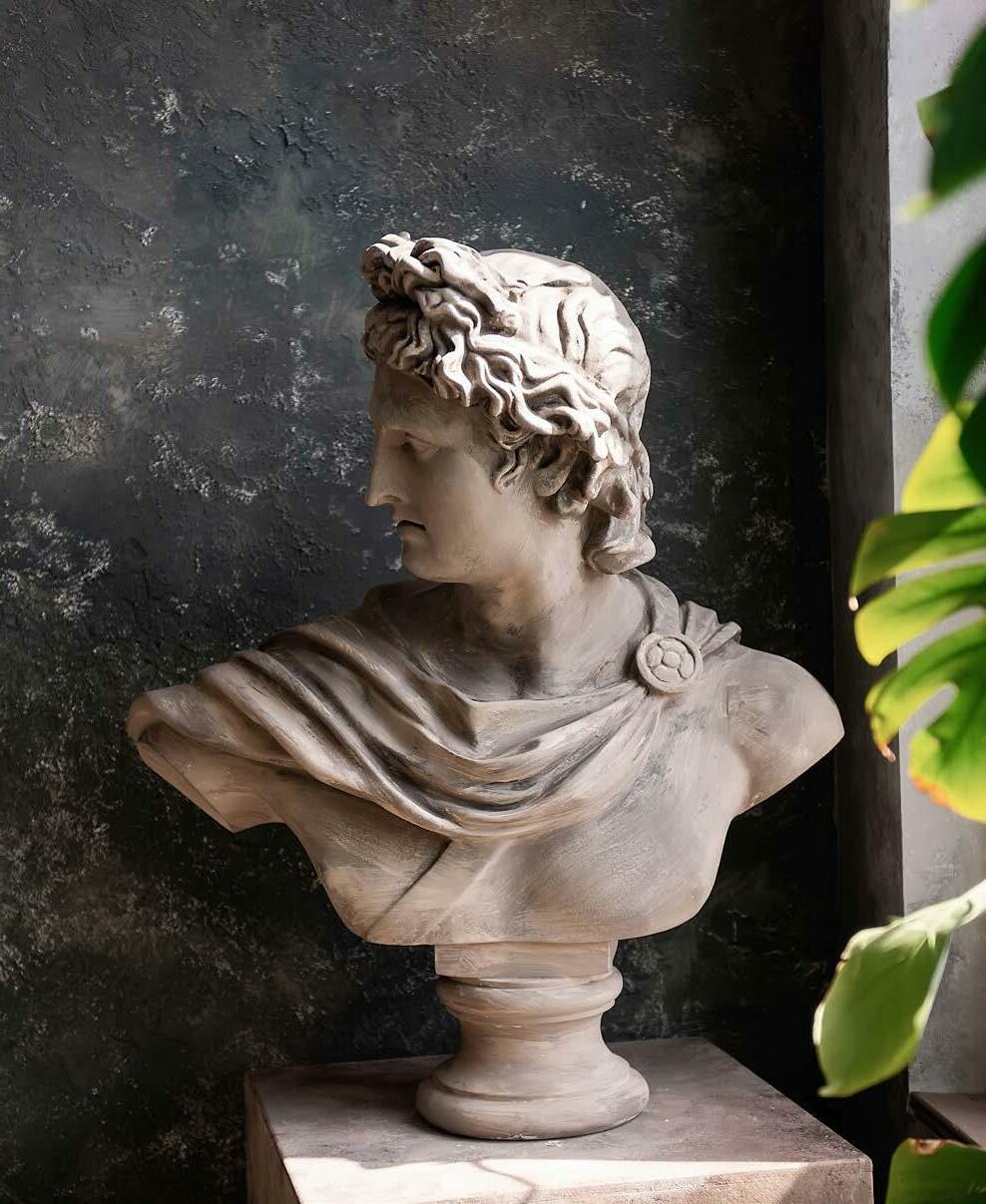

GALLO FINE ART Stand 10 Palazzo Olivazzi Trivulzio - Via Bigli 21 20121 Milano Tel. +39 02 359 463 70 Via XXVIII Aprile 486 35047 www.gallofineart.itwww.gallofineart.cominfo@gallofineart.itinfo@gallofineart.comSolesino
FRANCESCO MONTELATICI, CALLED CECCO BRAVO (Florence 1601 - Innsbruck 1661)

Oil on canvas, 40 x 60 cm
Olio su tela, 40 x 60 cm
MICHELE GARGIULO “ANTIQUARIO” Stand 33 Via C. Poerio 32 80121 Napoli Tel. +39 081 764 graziagalanterie@alice.itmichelegargiulo5@gmail.com3854
GIUSEPPE RUOPPOLO (circa 1630 - circa 1710) cherries and pumpkin Oil on canvas, diameter 100 cm
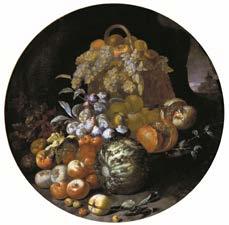
Olio su tela, diametro 100 cm
DARIO GHIO Stand 39 25 Boulevard Princesse Charlotte 98000 Monte Carlo Tel. +377 977 040 www.darioghio.cominfo@darioghio.com18

VENETIAN WORKSHOP Wood cabinet with ivory and mother-of-pearl inlay work, (17th century) BOTTEGA VENEZIANA Cabinet in legno con intarsi in avorio e madreperla, (XVII secolo)
GIACOMETTI OLD
Stand 60 Via D. Morelli 24 80121 Napoli Tel. +39 320 372 www.giacomettiomp.comumbertogiacometti@gmail.cominfo@giacomettiomp.com0492
ANTONIO MANCINI
(Albano Laziale 14 November 1852 - Rome 28 December 1930)
Self-portrait as a mad person Oil on cardboard mounted on canvas, diameter 32 cm, (1881/1882)

Autoritratto da pazzo Olio su cartone montato su tela, diametro 32 cm, (1881/1882)
IOTTI ANTICHITÀ
Stand 53
Via Amendola 55/a 42100 Reggio Emilia Tel. +39 0522 552 siottiantichita@libero.it838
BIANCONI CARLO (Bologna 1732 - Milan 1802)
BaccoBacchus

MATTEO LAMPERTICO Arte Antica e Moderna Stand 17 Via Montebello 30 20121 Milano Tel. +39 02 365 865 www.matteolampertico.itinfo@matteolampertico.it47
PEDRO FERNÁNDEZ
Annunciation Oil on panel, 100 x 73,2 cm, (1525-30) Annunciazione Olio su tavola, 100 x 73,2 cm, (1525-30)

biennaleantiquariato 153
MASTER PAINTINGS

resto r ing passion building knowledge . e nhancing a wa r eness . The Museo Nazionale del Bargello is the world’s most important museum of RenaissanceItaliansculpture. itsandestablishedaThewww.friendsofthebargello.orgFriendsoftheBargelloisnot-for-profitorganisation,topromote,elevatesustaintheBargelloandexceptionalcollections. The Friends of the Bargello are pleased to support THE DIDELLINTERNAZIONALEBIENNALE’ANTIQUARIATOFIRENZE giambologna (1529–1608), Mercury c. 1580
DYS44 LAMPRONTI GALLERY
Stand 6 44 Duke Street, St. James’s SW1Y 6DD London
LAOCOON GALLERY Stand 13 2A-4 Ryder Street SW1Y 6QB Londra

Tel. +44 208 753 903 Via Monterone 13/13A 00186 www.laocoongallery.cominfo@laocoongallery.co.ukRoma
VINCENZO DE ROSSI (Fiesole 1525 - Firenze 1587)
LEONE Stand 43
Via S. M. a Cappella Vecchia 49 80121 Napoli Via D. Morelli 13 80121 Napoli
Tel. e Fax +39 081 764 4244 Cell. +39 336 846 580, +39 339 6457 827, +39 335 621 www.leoneantiquariato.comleoneantiquariato@libero.itinfo@leoneantiquariato.com4533

info@cesarelampronti.itTel.00187Viawww.cesarelampronti.cominfo@cesarelampronti.co.uk2977SanGiacomo22Roma+39063227194
Tel. +44 207 839
GIOVANNI ANTONIO CANAL, CALLED CANALETTO (Venice 1697 - 1768)
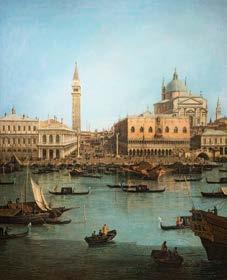
Saint Mark Oil on canvas, 130 x 135 cm, (1750 ca) di San Marco Olio su tela, 130 x 135 cm, (1750 ca.)
Laocoon Marble, x 210 x (1584
GIUSEPPE SANMARTINO (Naples 1720 - 1793) 25 cm, (18th century) Quattro puttini da presepe
LONGARI ARTE MILANO
Stand 47 Corso Monforte 23 20122 Milano
Tel. +39 02 896 978 48 Cel. +39 335 5929 www.longariartemilano.cominfo@longariartemilano.com301
MARIO NEGRI (Tirano 1916 - Milan 1987)
The old king - homage to Antelami Bronze, 55 × 26,5 × 38 cm, (1972-1973)
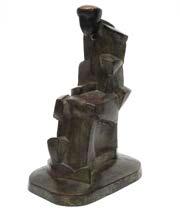
Il vecchio re - omaggio all’Antelami Bronzo, 55 × 26.5 × 38 cm, (1972-1973)
SANDRO MORELLI
Stand 56-57 Via Maggio 59r 50125 Firenze Tel. +39 055 282 sanmorelli@gmail.com789
MOSANA MANUFACTURE (mid-13th century) A cape clip Engraved, embossed silver foil, water-marked silver, engraved and cut bone, rock crystals and Fermaglio di piviale Lamina di argento incisa e sbalzata, argento

MORETTI Stand 66 13 Duke Street, St. James’s SW1Y 6DB Londra
Tel. +44 207 491 0533
Park Palace - 27 Avenue de la Costa 98000 Monte Carlo Tel. +377 999 909 www.morettigallery.comenquiries@morettigallery.com70
ANDREA BONAIUTI
(Florence, active from 1345-50 circa - 1379)
A Saint Bishop; Saint Bartholomew; in the top trefoil: a prophet
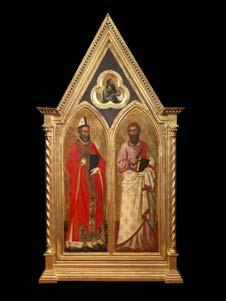
Tempera on panel, 157 x 75 cm Santo vescovo; San Bartolomeo;
Tempera su tavola, 157 x 75 cm
biennaleantiquariato 155
160
80 cm,
ca) Marmo,Laocoonte160 x 210 x 80 cm, (1584 ca.)
Inve oser.
An active community of forward-thinking investors enjoying unprecedented access to unique investment opportunities.
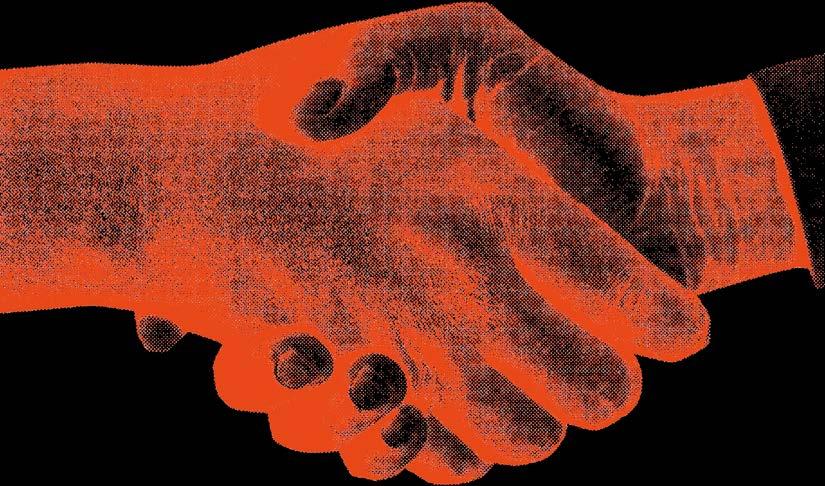
WWW.ATYPICALPARTNER.COM
MAURIZIO NOBILE
Stand 48
Via Santo Stefano 19/a 40125 Bologna Tel. +39 051 238 milano@maurizionobile.comCel.Tel.20121Viaparis@maurizionobile.comTel.750032www.maurizionobile.combologna@maurizionobile.com363rueChaponParigi+330145630775SantoSpirito7Milano+390250306384+393385796509
ERCOLE PROCACCINI (Bologna 1520 - Milan 1595)

Saints Catherine and Jerome Oil on canvas, 143 x 114,5 cm, (16th century)
e i santi Caterina e Girolamo Olio su tela, 143 x 114,5 cm, (XVI secolo)
CARLO ORSI Stand 2
Via Bagutta 14 20121 Milano
Tel. +39 02 760 022 www.galleriaorsi.cominfo@galleriaorsi.com14
LORENZO BARTOLINI (Savignano (Prato) 1777 - Florence 1850)
Napoleon Bonaparte Marble, 67 x 34 x 32 cm Napoleone Bonaparte Marmo, 67 x 34 x 32 cm

Stand 21 Via Cappuccio 18 20123 Milano Tel. +39 02 897 773 www.orsiniartelibri.itinfo@orsiniartelibri.it54
PELAGIO PELAGI (Bologna 1775 - Turin 1860)
Oil on canvas, 170 x 215 cm, (1810 ca) Ila rapito dalle Ninfe Olio su tela, 170 x 215 cm, (1810 ca.)

WALTER PADOVANI
Stand 9
Via Santo Spirito 26/a 20121 Milano Tel. +39 02 763 189 www.walterpadovani.itgalleria@walterpadovani.it07
FROM A MODEL BY GIOVANNI BATTISTA FOGGINI (Florence 1652 - 1725)

Saint Charles Borromeo in Adoration
White Porcelain, Ginori di Doccia Manufactory, 39,5 cm, (1755 ca)
San Carlo Borromeo in adorazione del Porcellana bianca, Manifattura Ginori di Doccia, altezza 39,5 cm, (1755 ca.)
A. PALLESI ART GALLERY Stand 40 Le Park Palace - 6 Impasse de la Fontaine 98000 Monte Carlo Tel. +377 977 715 www.galleria-pallesi.cominfo@galleria-pallesi.com77
ARTURO MARTINI (Treviso 1889 - Milan 1947)
Nena Terracotta, 30 x 29 x 44 cm, (1930 ca) Nena Terracotta, 30 x 29 x 44 cm, (1930 ca.)
biennaleantiquariato 157

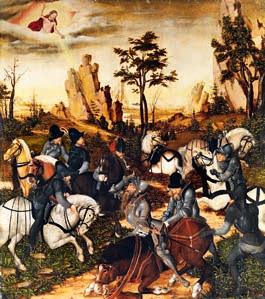




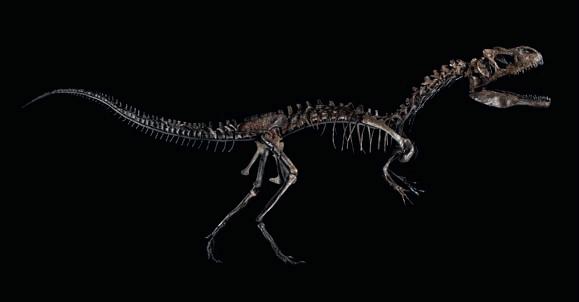

- Una delle principali case d‘asta in EuropaLE MIGLIORI AGGIUDICAZIONI A LIVELLO INTERNAZIONALE PER LE VOSTRE OPERE D‘ARTE Hampel Fine Art Auctions · Schellingstr. 44 · Villa Hampel · 80799 Monaco di Baviera · Germania BERNARDO BELLOTTO, DETTO ”CANALETTO” 1721 – 1780, olio su tela, 52,5 x 68 cm, monogramma Venduto: € 518.000 FRIEDRICH NERLY IL VECCHIO e datato Venduto: € 308.000 ALLOSAURUS JIMMADSENI DINOSAURO 148 – 154 milioni di anni, 200 x 458 x 80 cm, Wyoming, Stati Uniti Venduto: € 1.230.000 LUCAS CRANACH IL GIOVANE 1515 – 1586, olio su tavola, 93,5 X 83,1cm Venduto: € 816.000 PIETER BRUEGHEL IL GIOVANE 1564 – 1638 cm, olio su tavola, 39 x 57,2 cm, perizia Dr. Klaus Ertz Venduto: € 673.000 PIETER BRUEGHEL IL GIOVANE 1564 – 1638 cm, olio su tela, 117,5 x 164,3 cm Venduto: € 1.221.000 MAESTRO HIERONYMUS SYX Orologio da tavolo astronomico, 78,7 X 32,4 X 26,4 Venduto: € 671.000
PORCINI Stand 18 Piazza Vittoria 6 80121 Napoli Tel. +39 081 764
www.porcinigallery.cominfo@porcinigallery.com3550
PARRONCHI DIPINTI ‘800-‘900 S.r.l. Stand 19
Via dei Fossi 18r 50123 Firenze Tel. +39 055 215 www.galleriaparronchi.itinfo@parronchidipinti.it109
OSCAR GHIGLIA (Livorno 1876 - Florence 1945)
Oil on canvas 51,5 x 45,5 cm, (1925) Isa Ghiglia di spalle Olio su tela, 51,5 x 45,5 cm, (1925)
PIVA & C. Stand 61
Via Bigli 7 20121 Milano
Tel. +39 02 760 006 78
Via Meravigli, ingresso da Via San Giovanni sul Muro 20121 Milano Tel. +39 02 366 326 93 www.pivaec.itinfo@pivaec.it
ARRIGO MINERBI (Ferrara 1881 - Padua 1960) Mammina
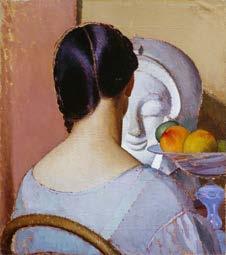
REVE ART Stand 72 Via dal Luzzo 4 40125 Bologna Tel. 348/2355901www.reveartgallery.cominfo@reveartgallery.com335/244706
ETTORE ZANETTI ZILLA (Venice 1864 - Milan 1946) Luggers
Oil on canvas glued onto a resin stone slab, 118 x 247 cm, (1914)
Olio su tela incollata su lastra lapidea resinata, 118 x 247 cm, (1914)
Carved Botticino marble, 145 x 70 x 30 cm, (1936) Mammina Marmo botticino scolpito, 145 x 70 x 30, (1936)

LUCA GIORDANO (Naples 1632 - 1705)

Oil on canvas, 152 x 204,5 cm Banchetto di Erode Olio su tela, 152 x 204,5 cm

ROBERTAEBASTA Stand 70 Via Fiori Chiari 2 20121 Milano Tel. +39 02 861 www.robertaebasta.comlondon@robertaebasta.comSW1W85info@robertaebasta.com593PimlicoRoad8PHLondon
CARLA ACCARDI (Trapani 9 October 1924 - Rome 23 February 2014)
Negative-Ideogram
Enamel and casein on canvas, 88,50 x 116,50 cm, (1954)

Negativo-Ideogramma Smalto e caseina su tela, 88,50 x 116,50 cm, (1954)
ROBILANT+VOENA Stand 15 38 Dover Street W1S 4NL Londra Tel. +44 207 409 www.robilantvoena.comart@robilantvoena.com75008Rue+110075980+3920122Viaart@robilantvoena.com1540Fontana,16,Milano028056179MadisonAve,NewYorkCity9174090549duCirque,17Parigi
RUTILIO MANETTI (Siena 1571-1639)
Oil on canvas, 169 x 231 cm Allegoria delle Quattro Stagioni Olio su tela, 169 x 231 cm
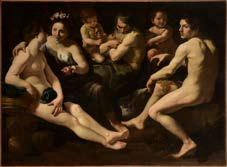
biennaleantiquariato 159

THE INTERNATIONAL AUCTION HOUSE CLOSE TO YOU GANDOLFIUBALDO 2022novembreColonia,privata.Collezionecm.27.5x39cartoncino,suapplicatacartasuOliofemminile.Nudo milano@lempertz.comContatti 1845 Twww.lempertz.com+393398668526
ROMANO FINE ART
Stand 58
Borgo Ognissanti 36 50123 Firenze
Tel. +39 055 239 www.romanofineart.cominfo@romanofineart.com6006
BARTOLOMEO PINELLI (Rome 1781 - 1835)
Portrait of the loved one Oil on canvas, 27,5 x 21 cm, (1821) Ritratto dell’amata Olio su tela, 27,5 x 21 cm, (1821)

ROMIGIOLI ANTICHITÀ
Stand 62 Viale Toselli 68 20025 Legnano (Milano) Cel. +39 348 412 www.romigioli.itromigioli@romigioli.it8148
GIOVANNI BARATTA (Carrara, 13 May 1670 - 21 May 1747)
Carrara marble sculpture, 72 x 48 cm, (1699 Sculturaca)in marmo di Carrara, 72 x 48 cm, (1699 ca.)
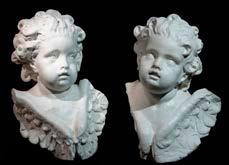
SALAMON & C. Stand 50 Palazzo Cicogna Via San Damiano 2, primo piano 20122 Milano Tel. +39 02 760 246 38 info@salamon.it; matteo@salamon.it www.salamon.it
JACOPO DEL CASENTINO (Pratovecchio 1295/1300 -1349)
The last supper - Saint Francis receives the stigmata Tempera on panel, gold ground, 33,3 x 15,6 cm, (1320 ca) L’ultima cena - San francesco riceve le stigmate Tempera su tavola, fondo oro, 33,3 x 15,6 cm, (1320 ca.)
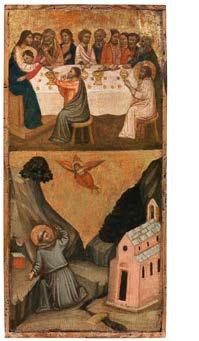
SANTA TECLA
Stand 32 Via dei Savonarola 66 35137 Padova Tel. +39 049 856 santateclaltd@gmail.com1460
GIROLAMO MUZIANO (Brescia 1532 - Rome 1592) Repenting Saint Jerome of the 16th century) San Girolamo penitente Olio su prima tela, 228 x 164 cm, (seconda metà del sec. XVI)

GIOVANNI SARTI Stand 3 137 rue du Faubourg Saint-Honoré 75008 Parigi Tel. +33 142 893 www.sarti-gallery.comgiovanni.sarti@wanadoo.fr366
GREGORIO DI CECCO DI LUCA (Documented in Siena from 1418 to 1424)
Tempera on panel, 60 x 32 cm, (1410-1415 ca) Matrimonio mistico di Santa Caterina tra Tempera su tavola, 60 x 32 cm, (1410-1415 ca.)
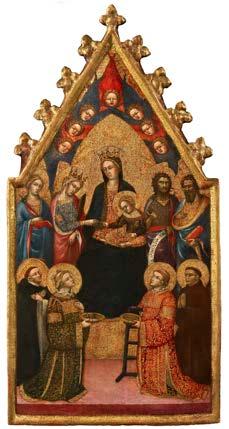
SCULTURA ITALIANA di Dario Mottola Stand 51 Via Santa Marta 21 20123 Milano Tel. +39 02 869 www.sculturaitalianasrl.comdario.mottola@tiscali.it2922
ALESSANDRO MAZZUCOTELLI (Lodi 1865 - Milan 1938)
Wrought iron, (1910)
Ferro battuto, (1910 circa)
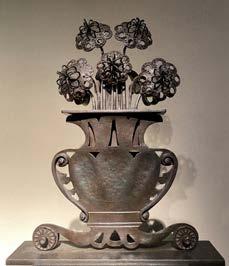
biennaleantiquariato 161
SECOL-ART ANTICHITA’ di Masoero
Davide & C.
Stand 35
Via Maria Vittoria 27/a 10123 Torino Tel. + 39 335 805 www.secolart.comsecolartmasoero@gmail.com0537
A wall mirror
Gilt and carved wood, a ceramic frame by Giorgio Giacinto Rossetti, 195 x 119 cm, (1735 ca)
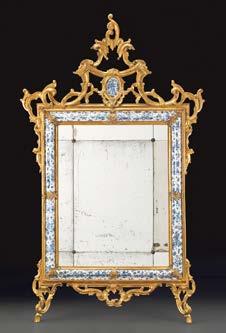
Specchiera
Legno scolpito e dorato, cornice in ceramica di Giorgio Giacinto Rossetti, 195 x 119 cm, (1735 ca.)
SOCIETÀ DI BELLE ARTI
Stand 34
Viale Buonarroti 9 55049 Viareggio (Lucca)
Tel. +39 0584 520 30
Via del Politecnico 9 20121 Milano Tel. +39 02 760 227 13 www.sba.itinfo@sba.it
OSCAR GHIGLIA (Livorno 1876 - Florence 1945)
Oil on cardboard, 36,6 x 35,8 cm, (1930 ca.)
Olio su cartone, 36,6 x 35,8 cm, (1930 ca.)
SPERONE WESTWATER Stand 1 257 10002BoweryNewYork, N.Y. Tel. +1 212 999 www.speronewestwater.cominfo@speronewestwater.com7337
GIOVANNI COLACICCHI (Anagni 1900 - Florence 1992) The drunkenness of Noah Oil on canvas, 97 x 155 cm, (1955)
Olio su tela, 97 x 155 cm, (1955)

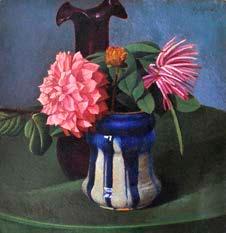
TETTAMANTI ANTICHITÀ
Stand 22 Via Maggio 22r 50125 Firenze
Tel. +39 055 218 tettamantiantichita@virgilio.it044
JULIEN DE PARME (Cavigliano 1736 - Paris 1799)
Oil on canvas, 171,5 x 122 cm, (1765) Marcantonio e Cleopatra Olio su tela, 171,5 x 122 cm, (1765)

TORNABUONI ARTE Stand 49 Lungarno B. Cellini 3 50125 Firenze
Tel. +39 055 681
www.tornabuoniarte.itfortedeimarmi@tornabuoniarte.itTel.55042Piazzamilano@tornabuoniarte.itTel.20121Viainfo@tornabuoniarte.it2697Fatebenefratelli34/36Milano+39026554841Marconi2FortedeiMarmi+390584787030
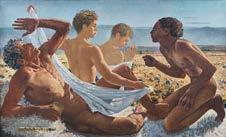
PABLO PICASSO (Malaga, Spain 1881 - Mougins, France 1973)
Etude pour taureau Gouache on cardboard, 65 x 50 cm Etude pour taureau Gouache su cartone, 65 x 50 cm
162 biennaleantiquariato
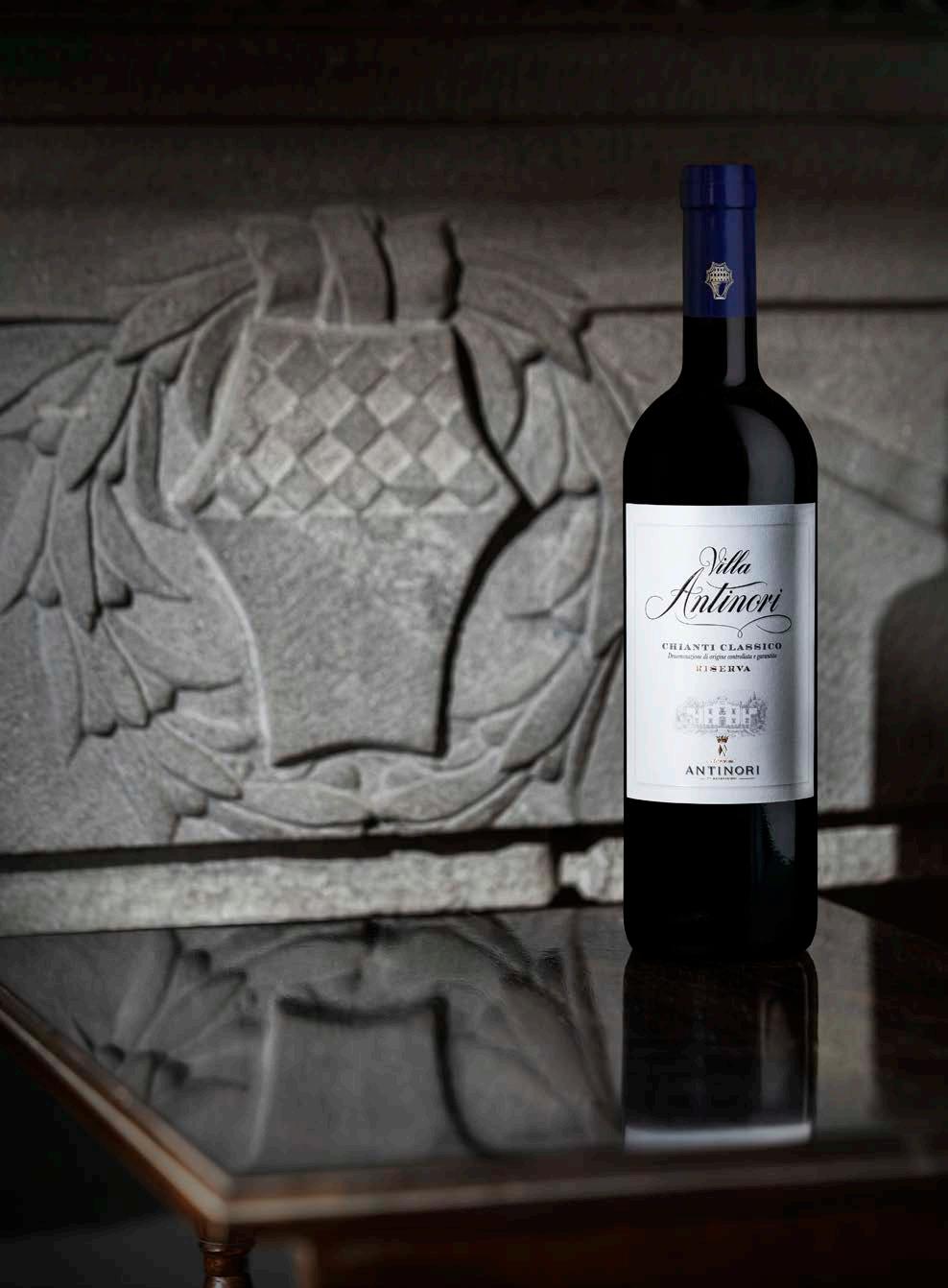
F UTURO A NTICO
































